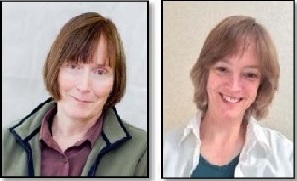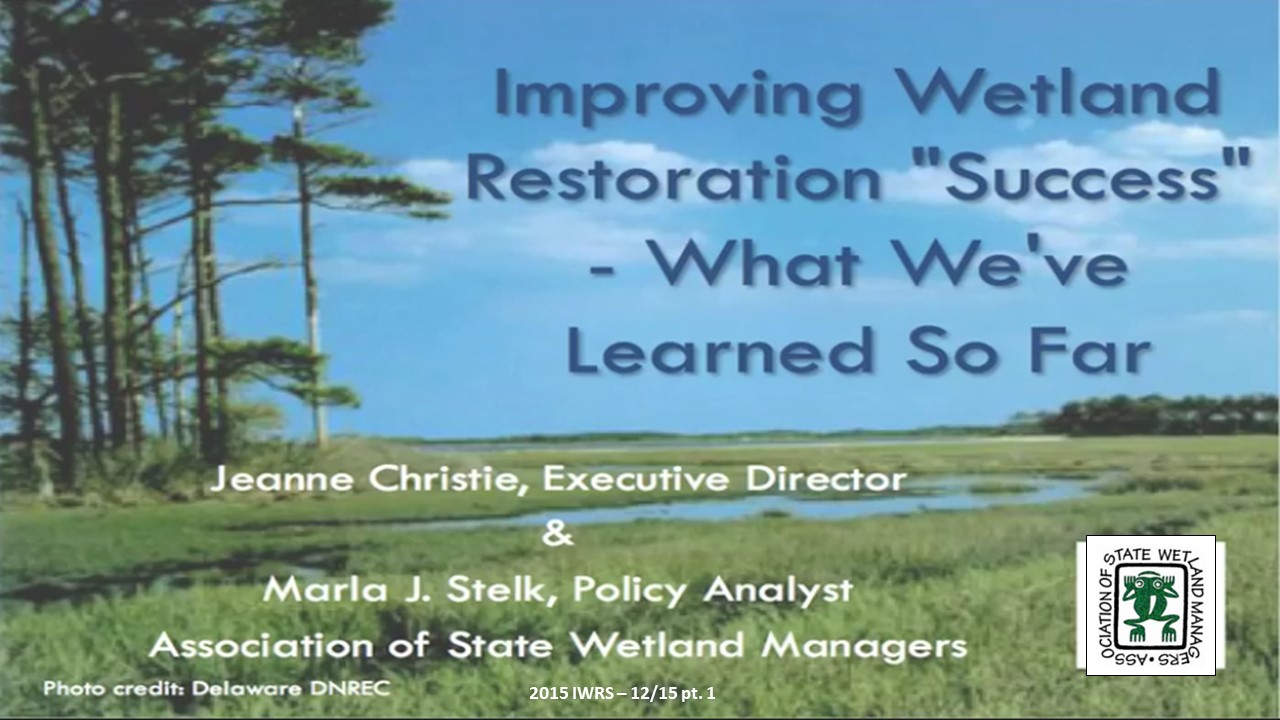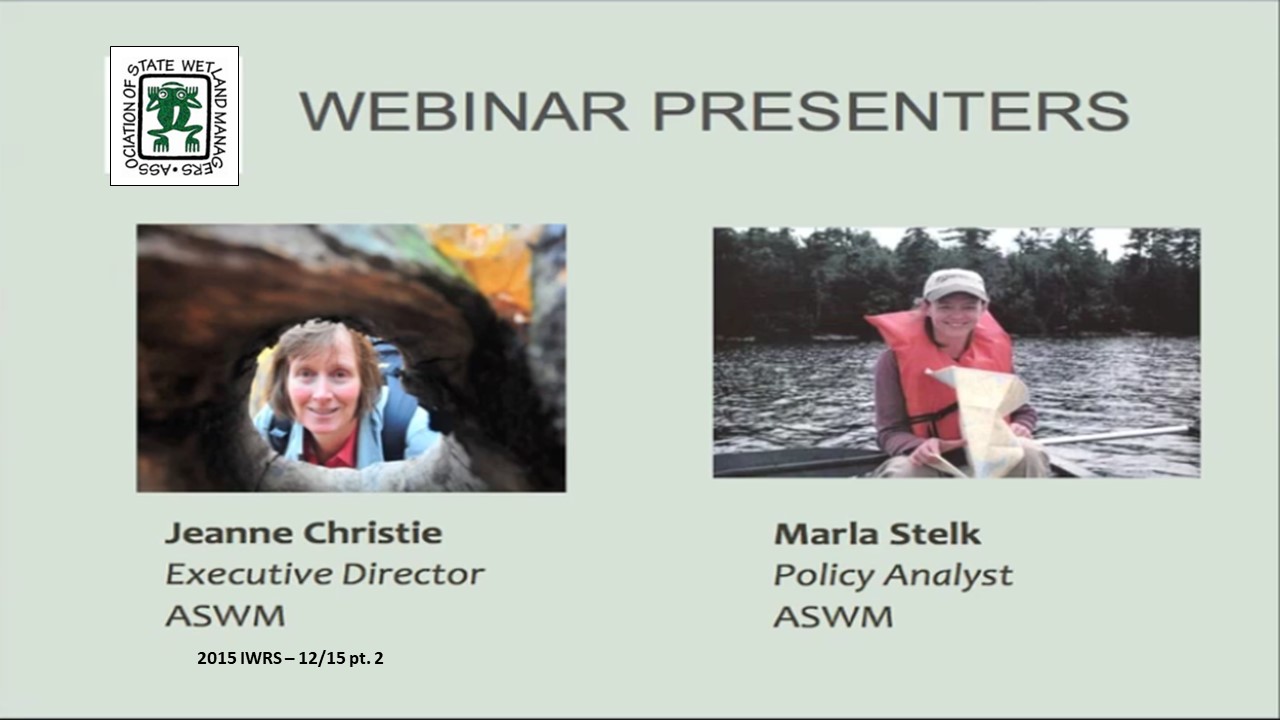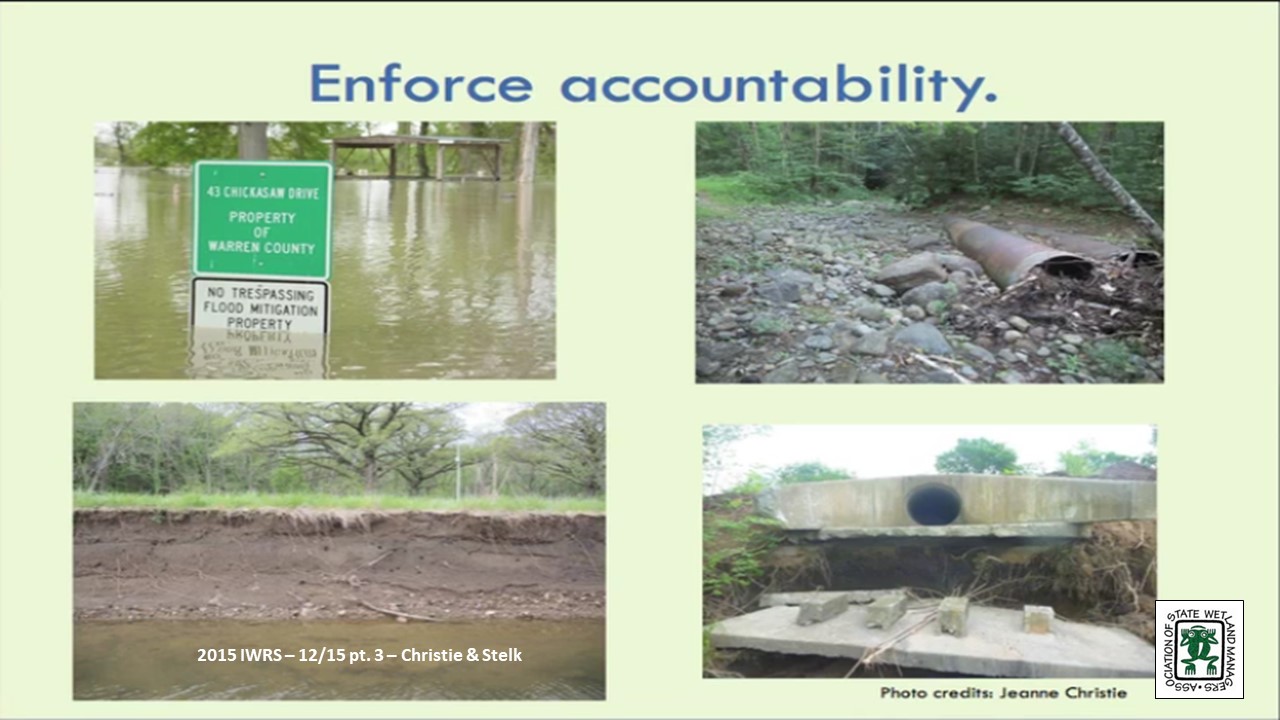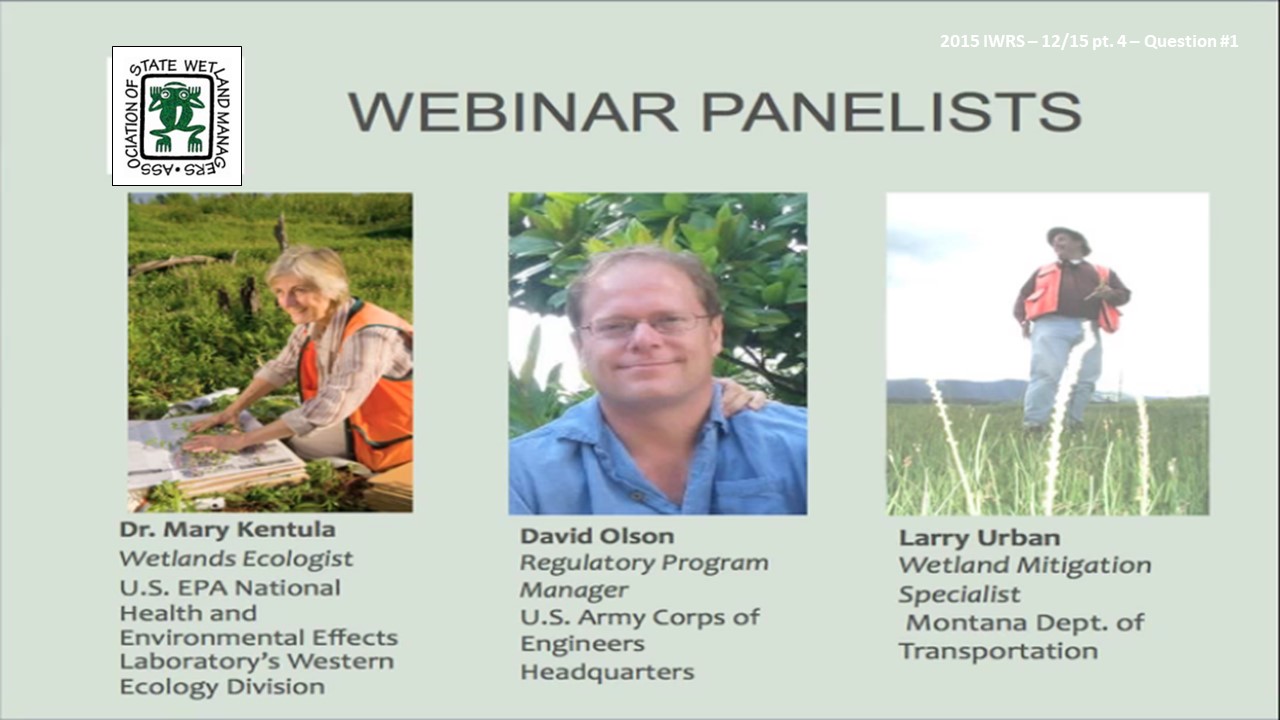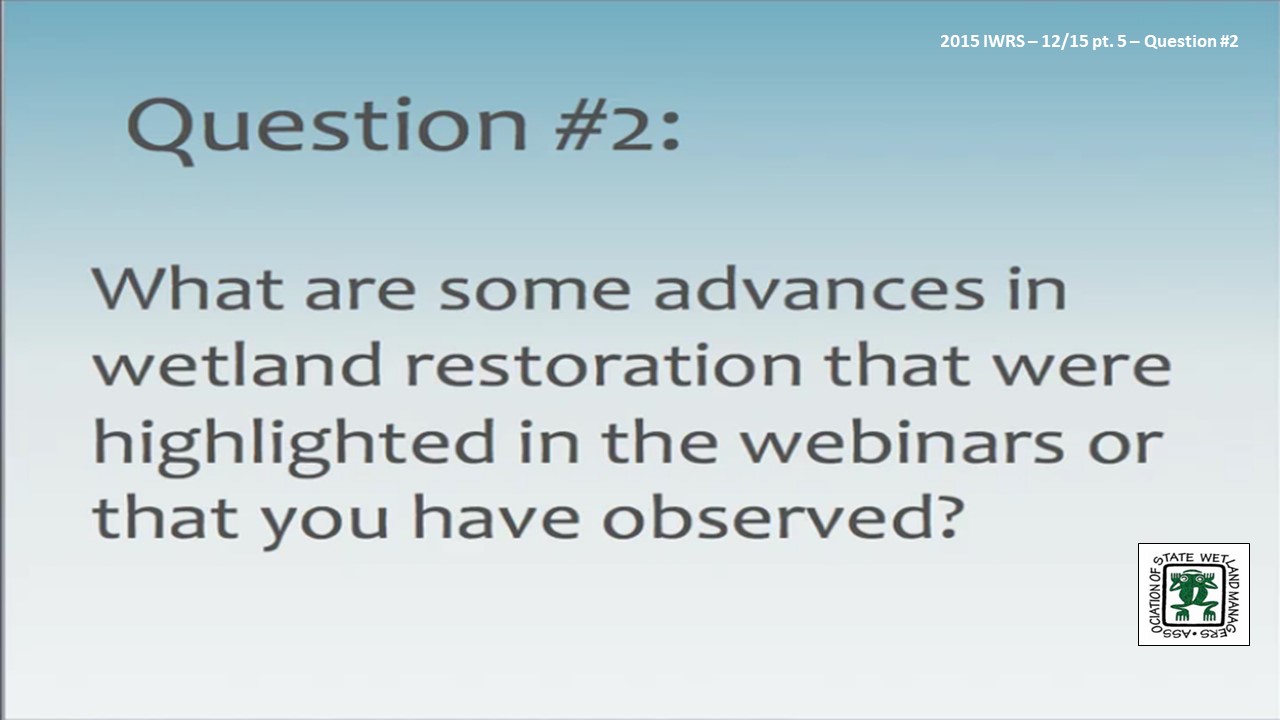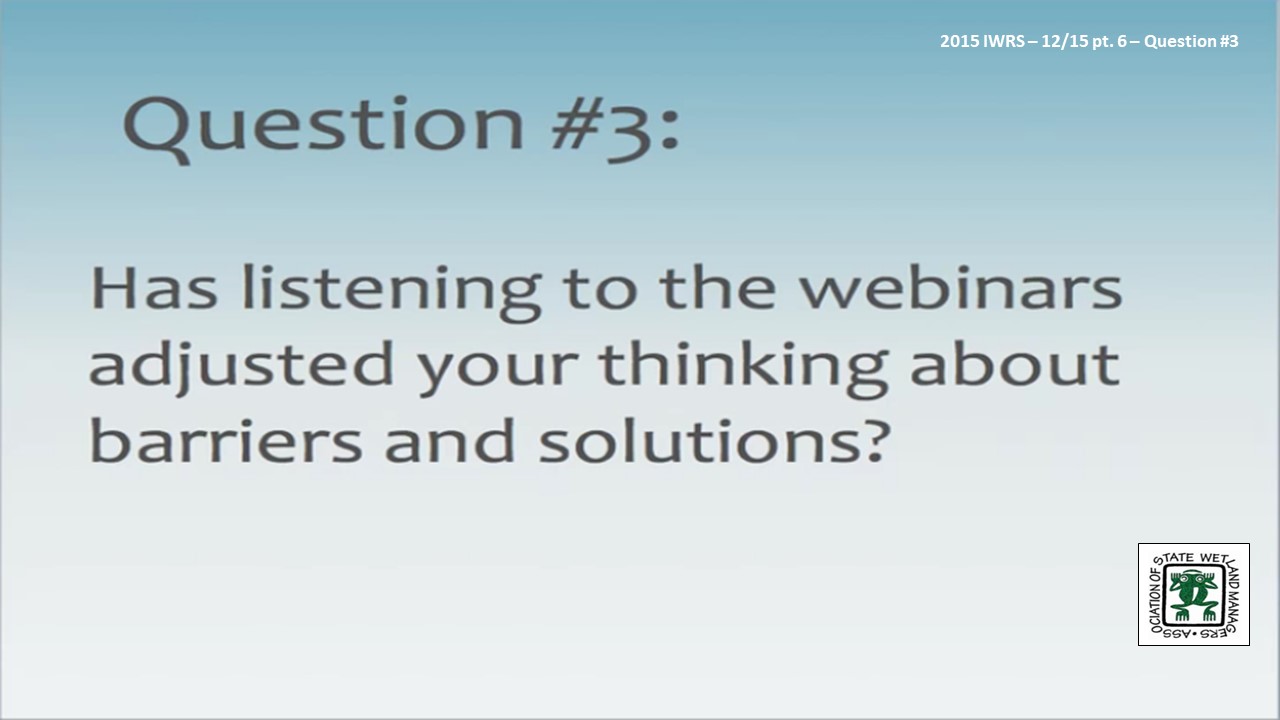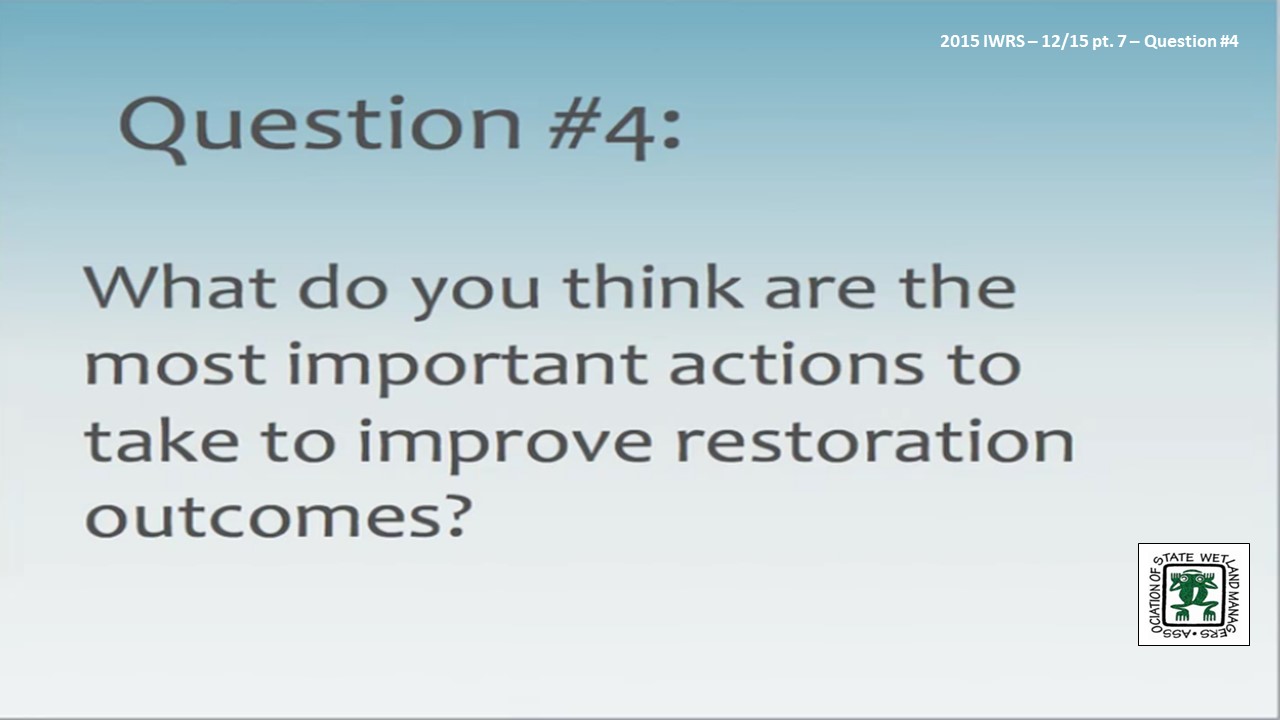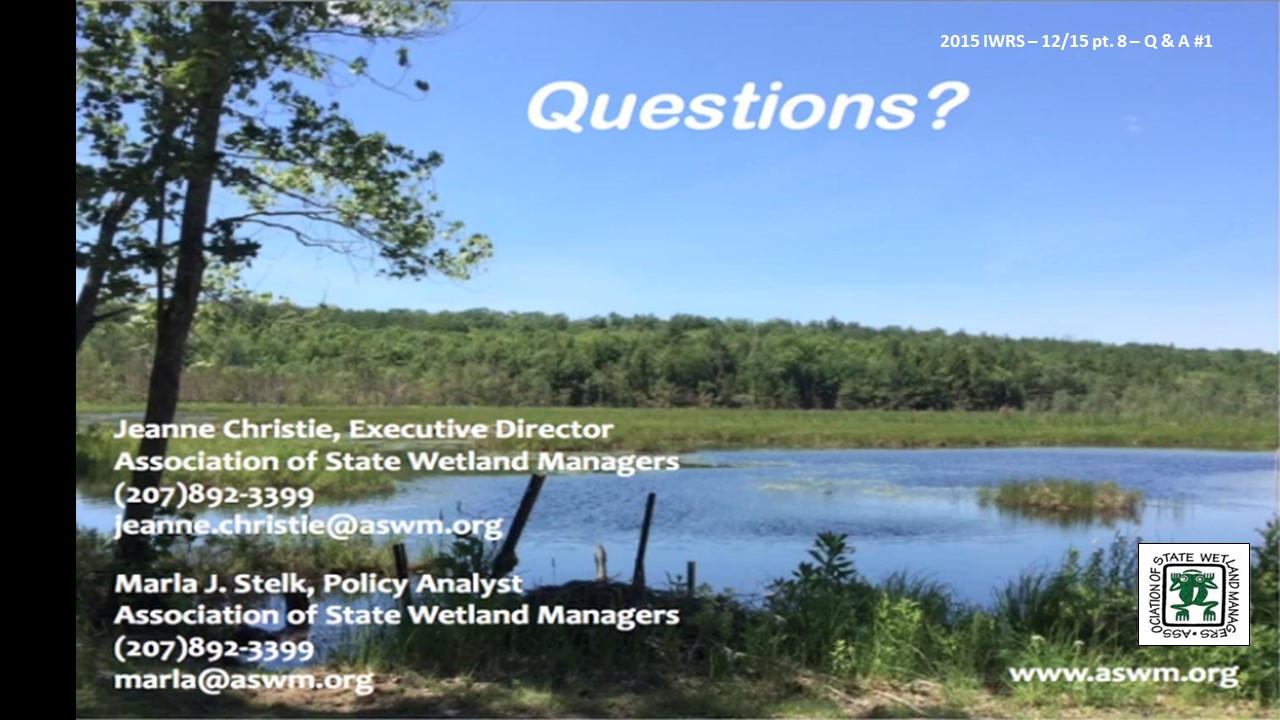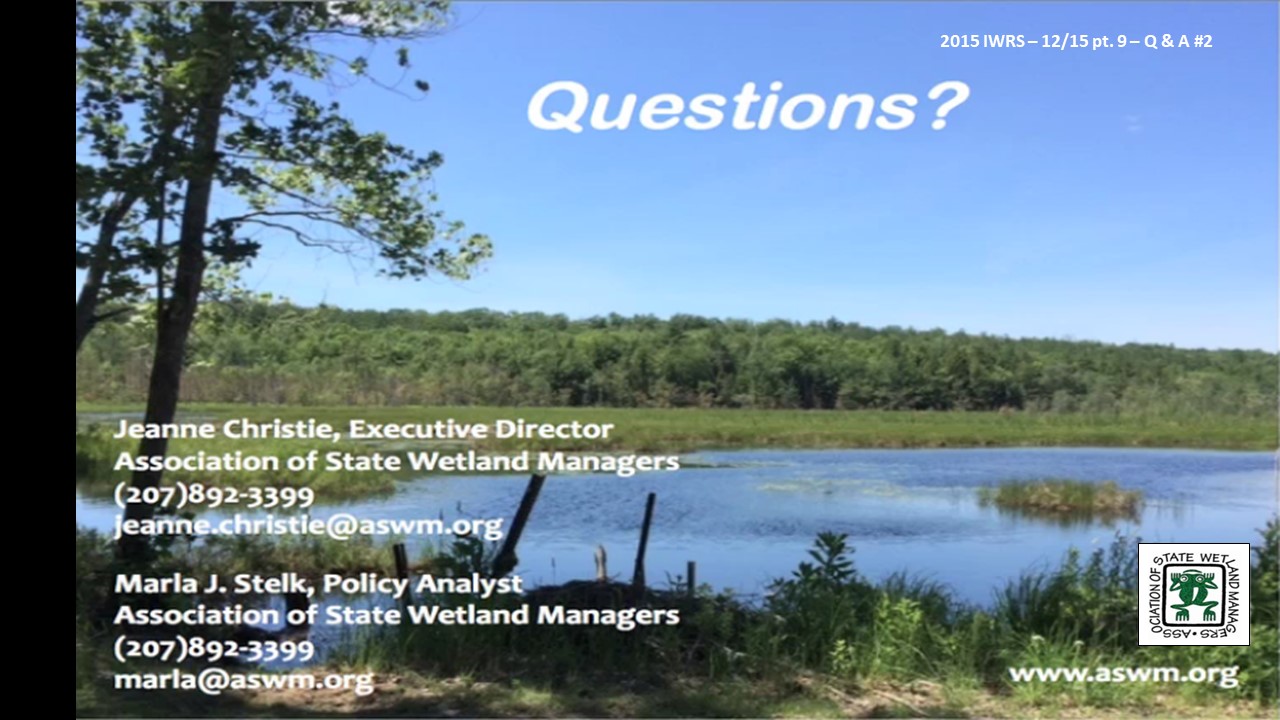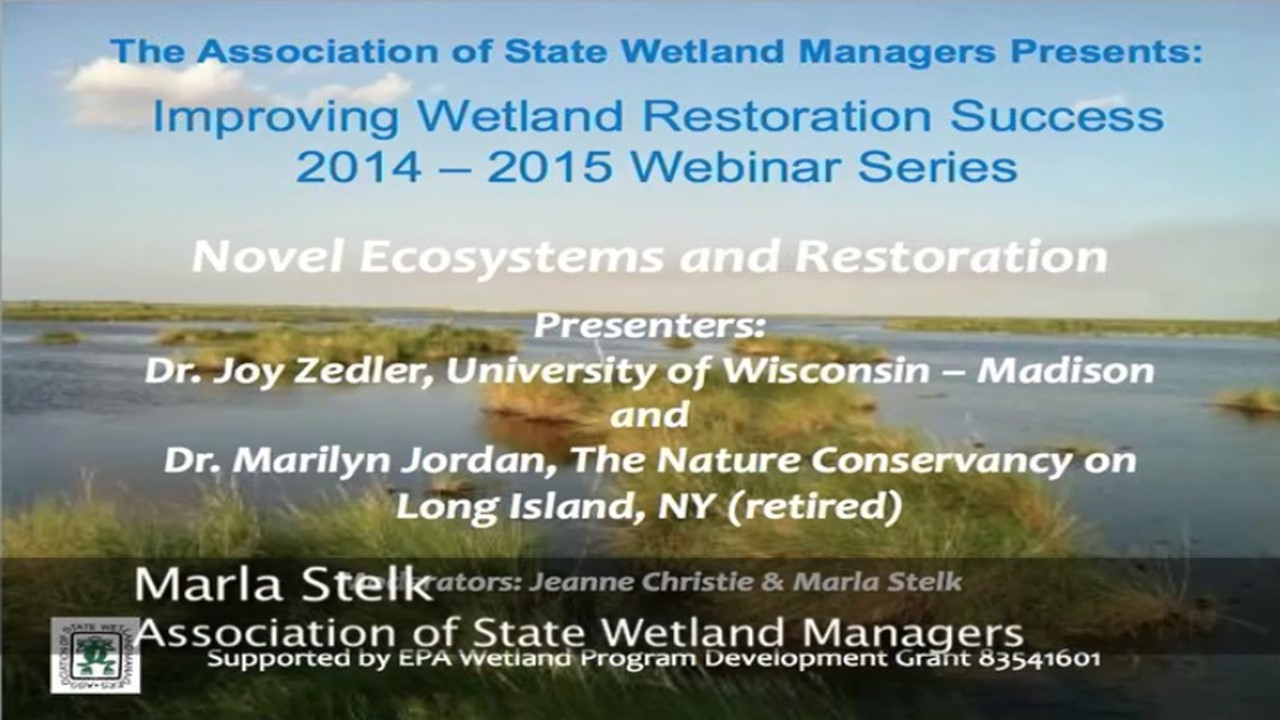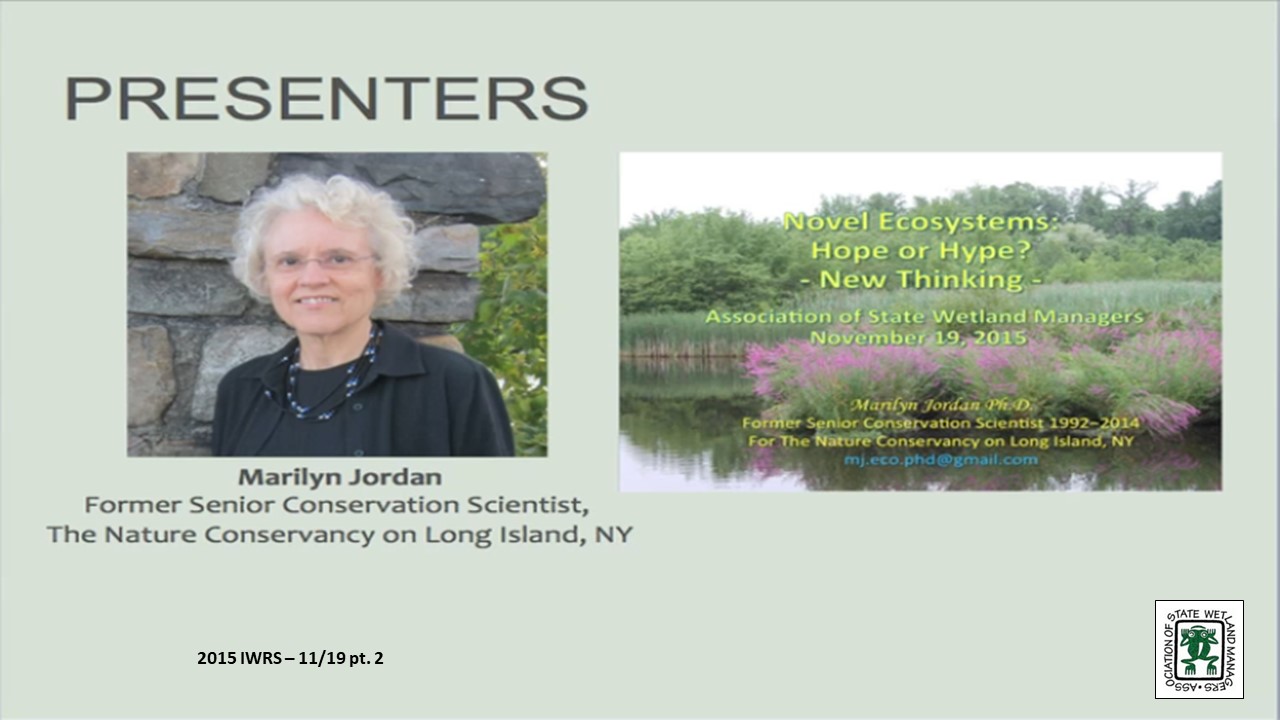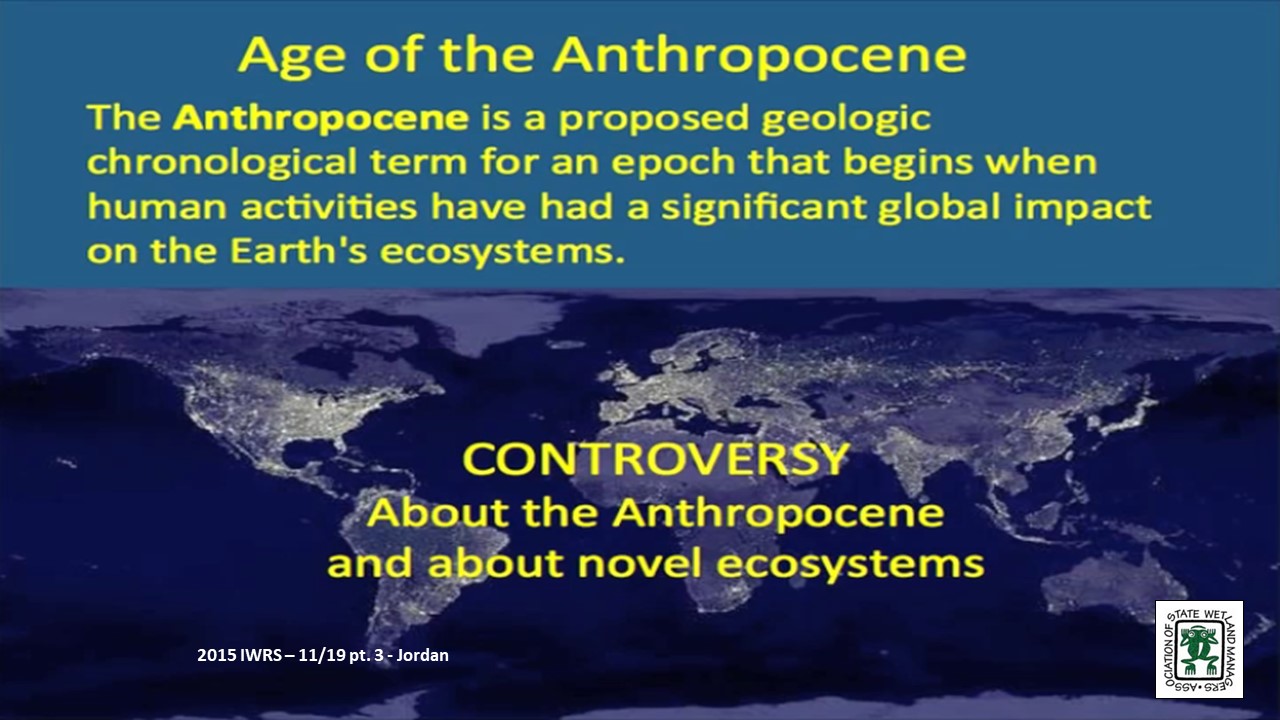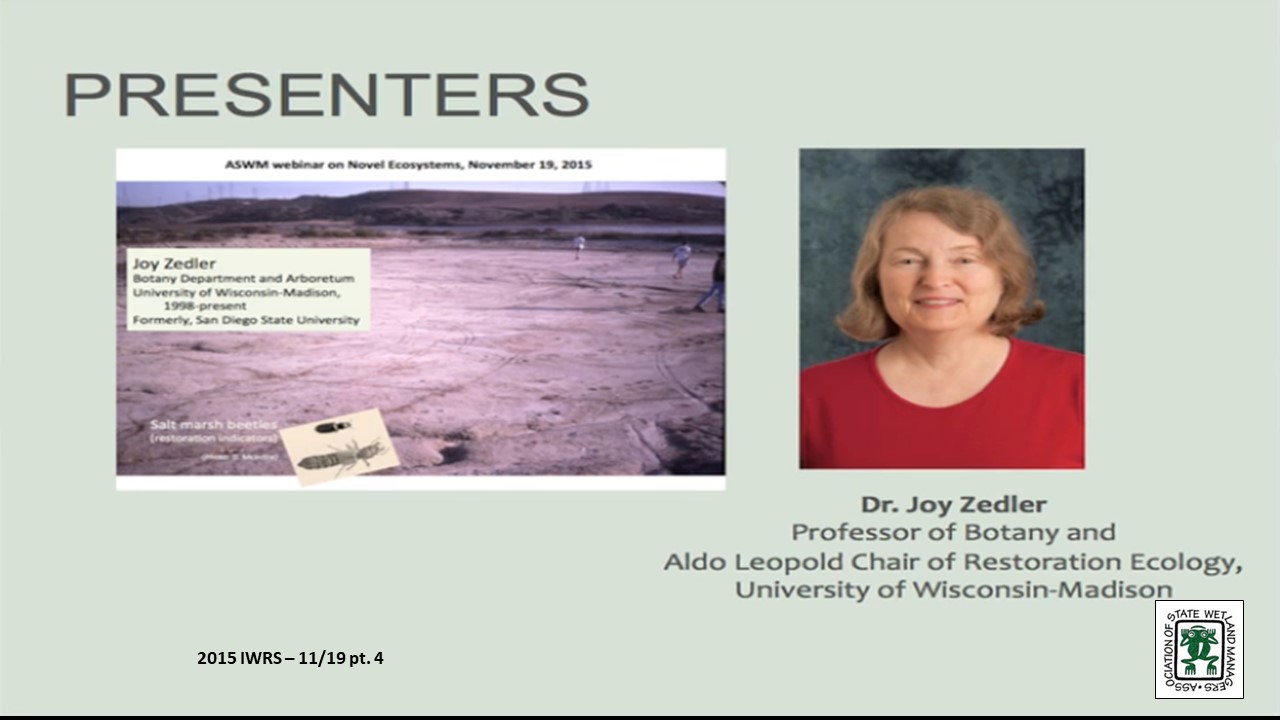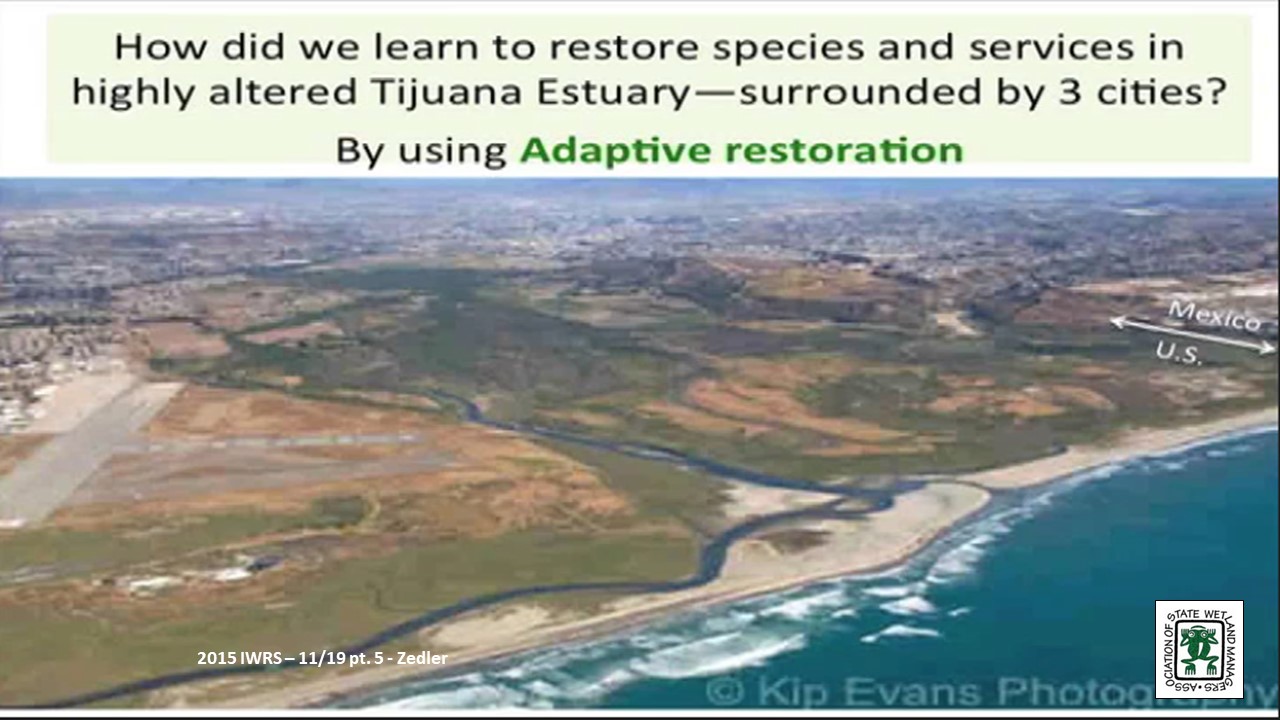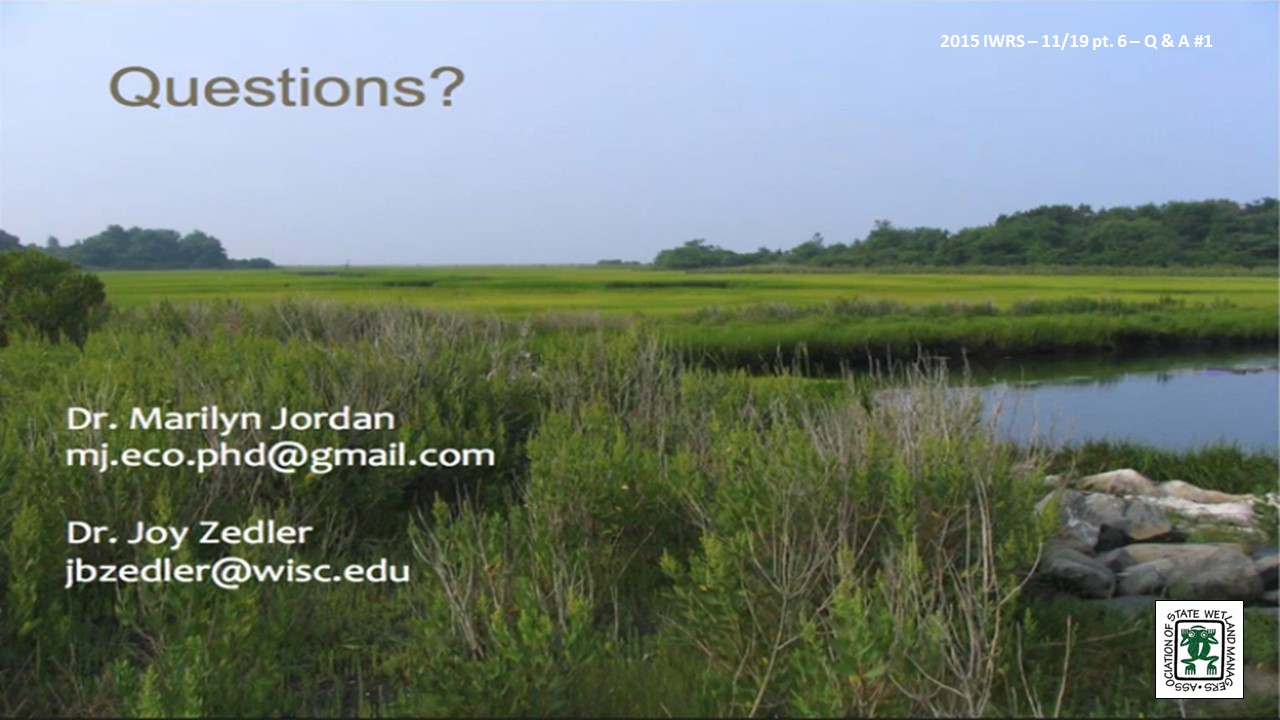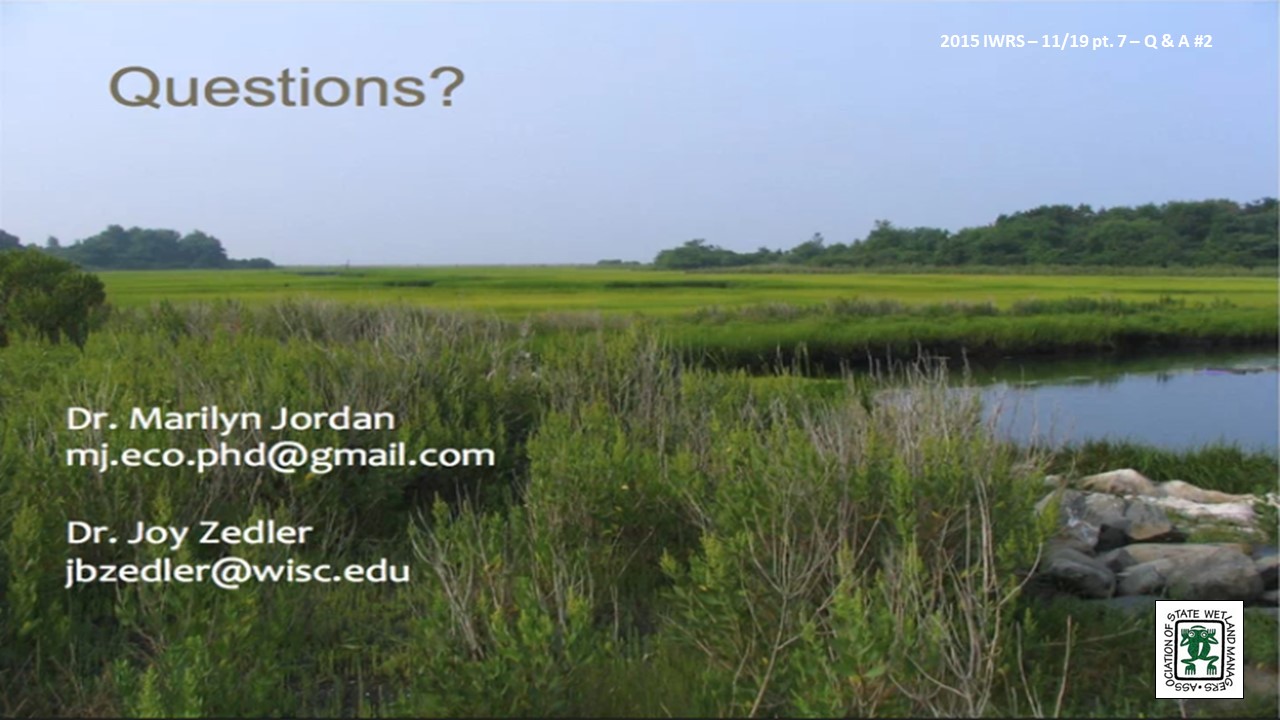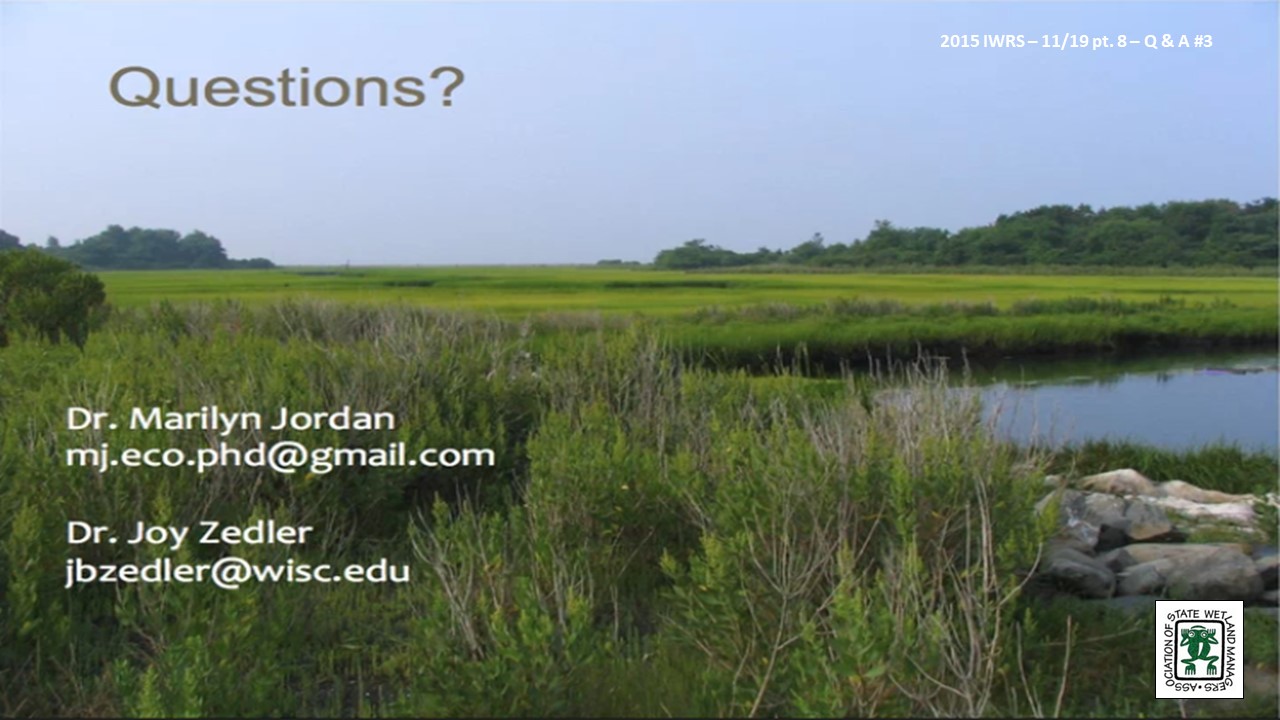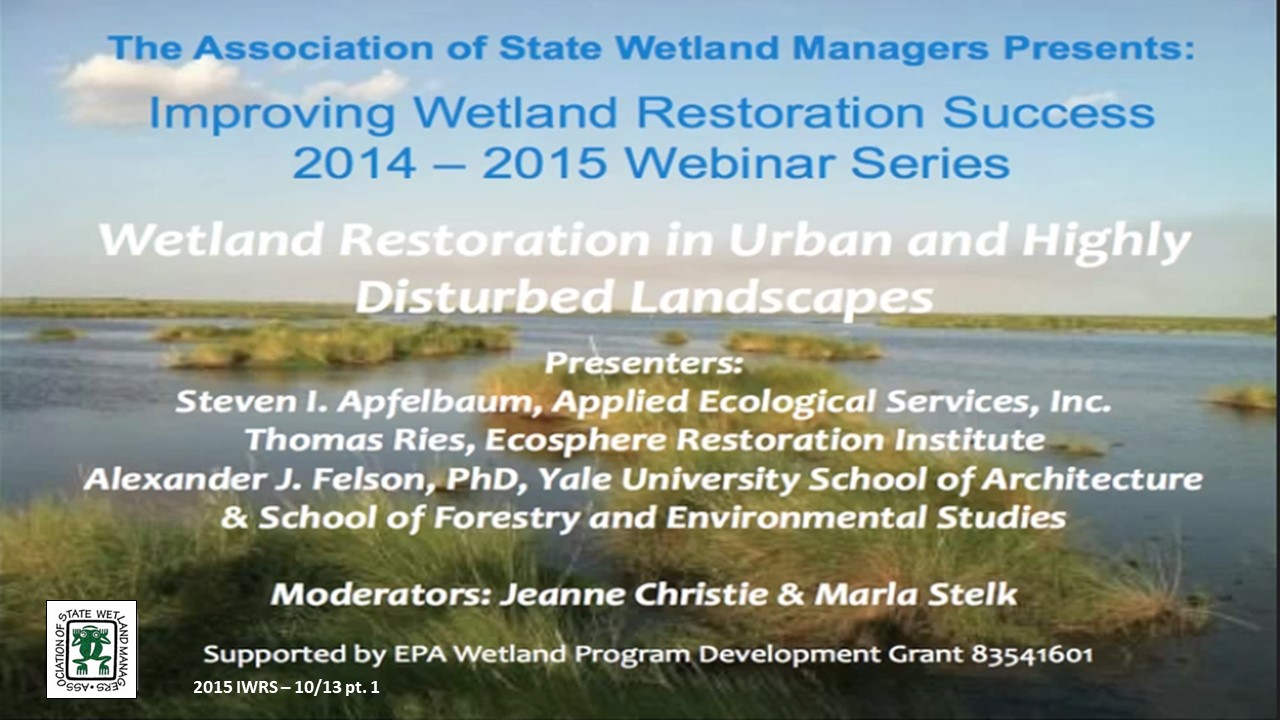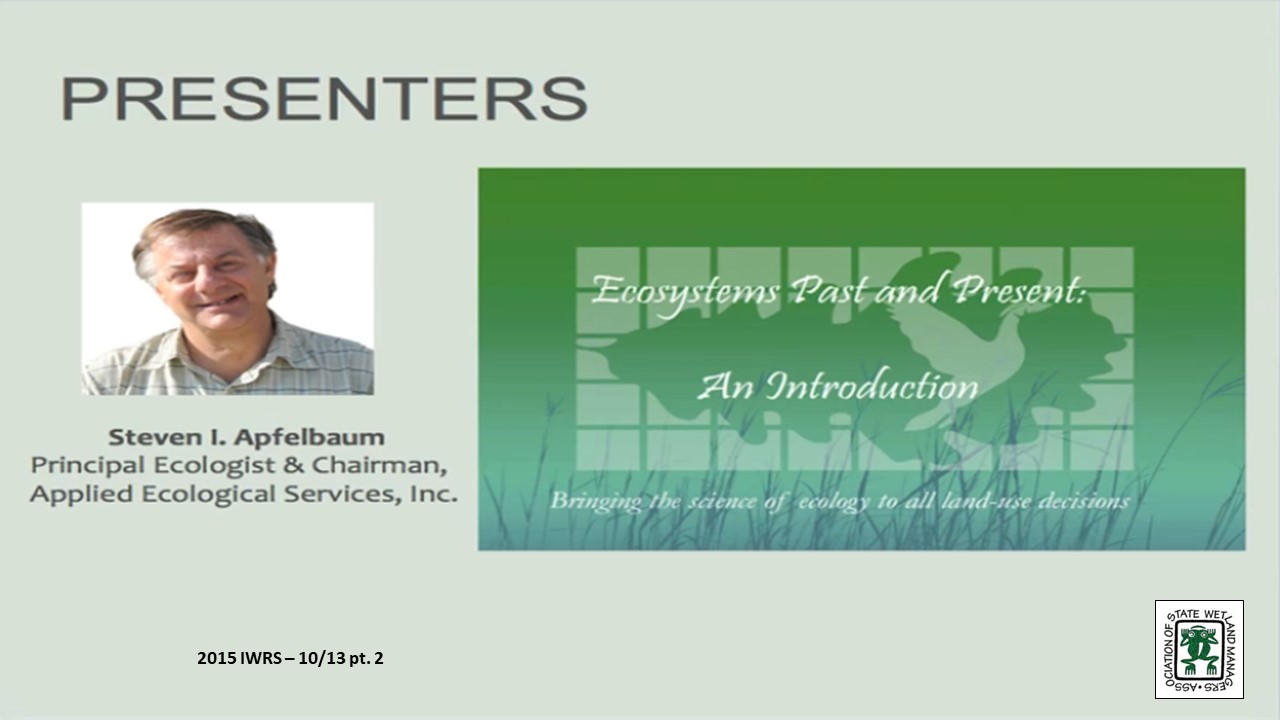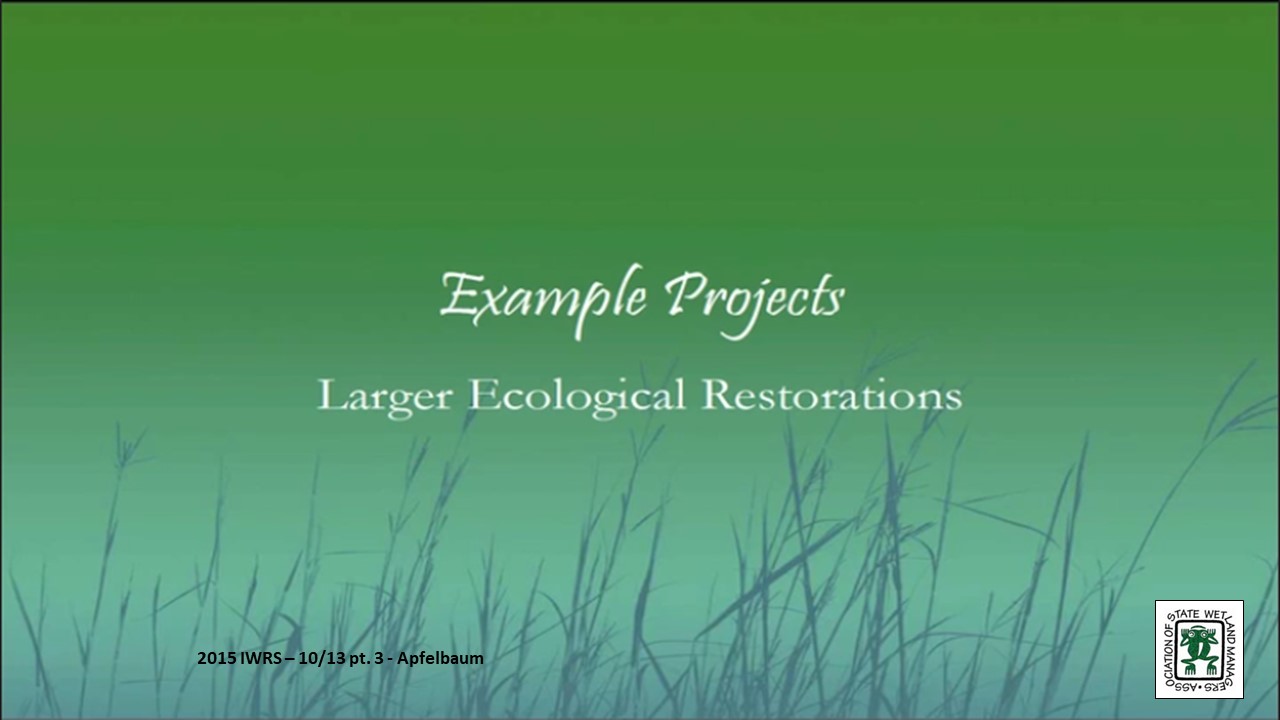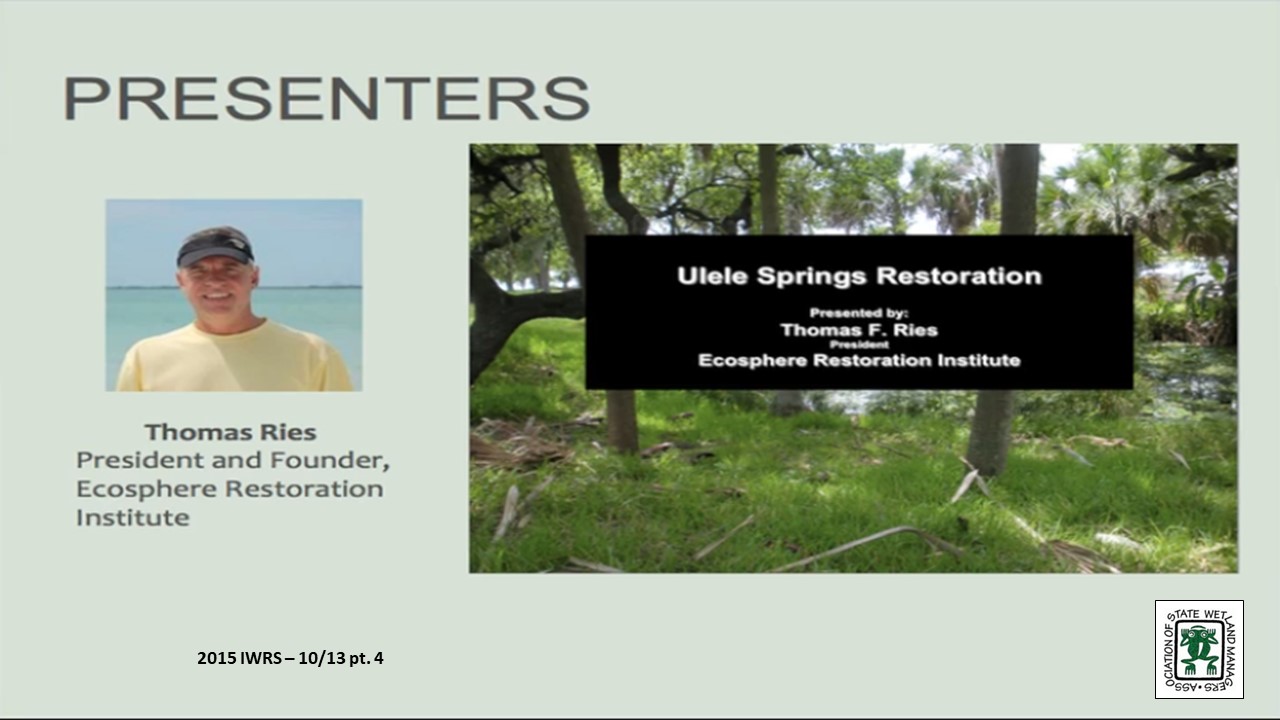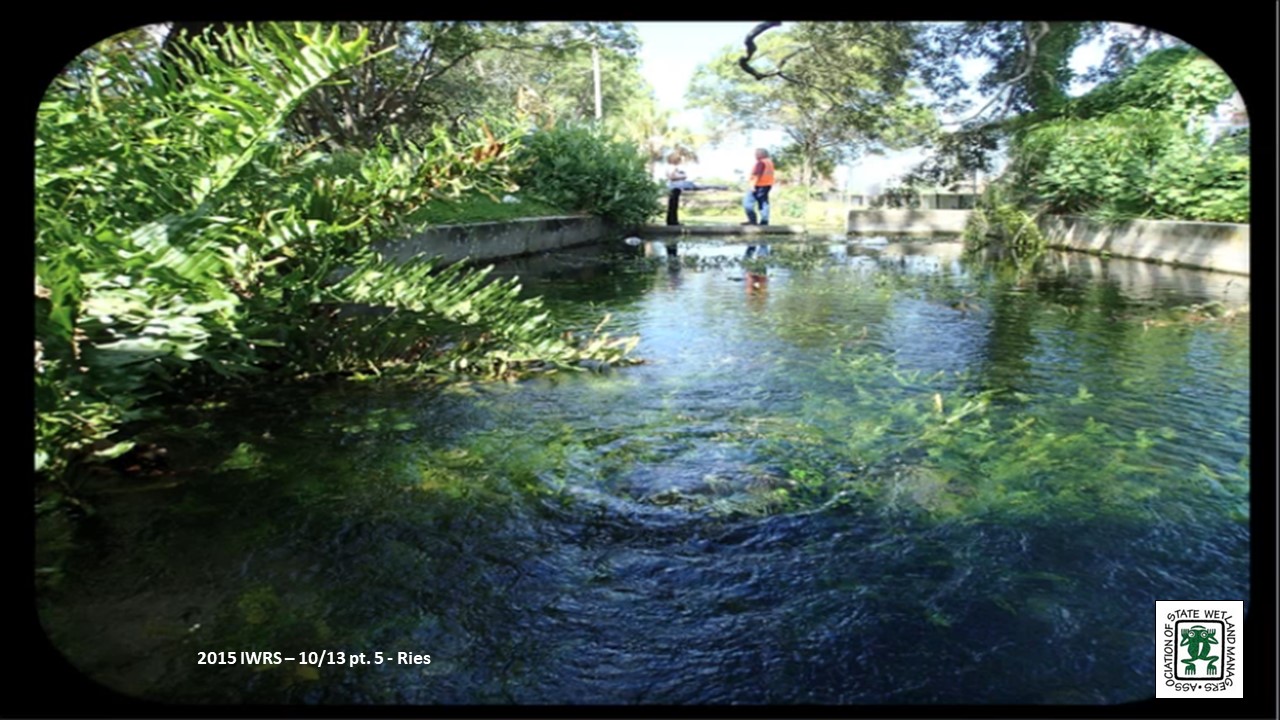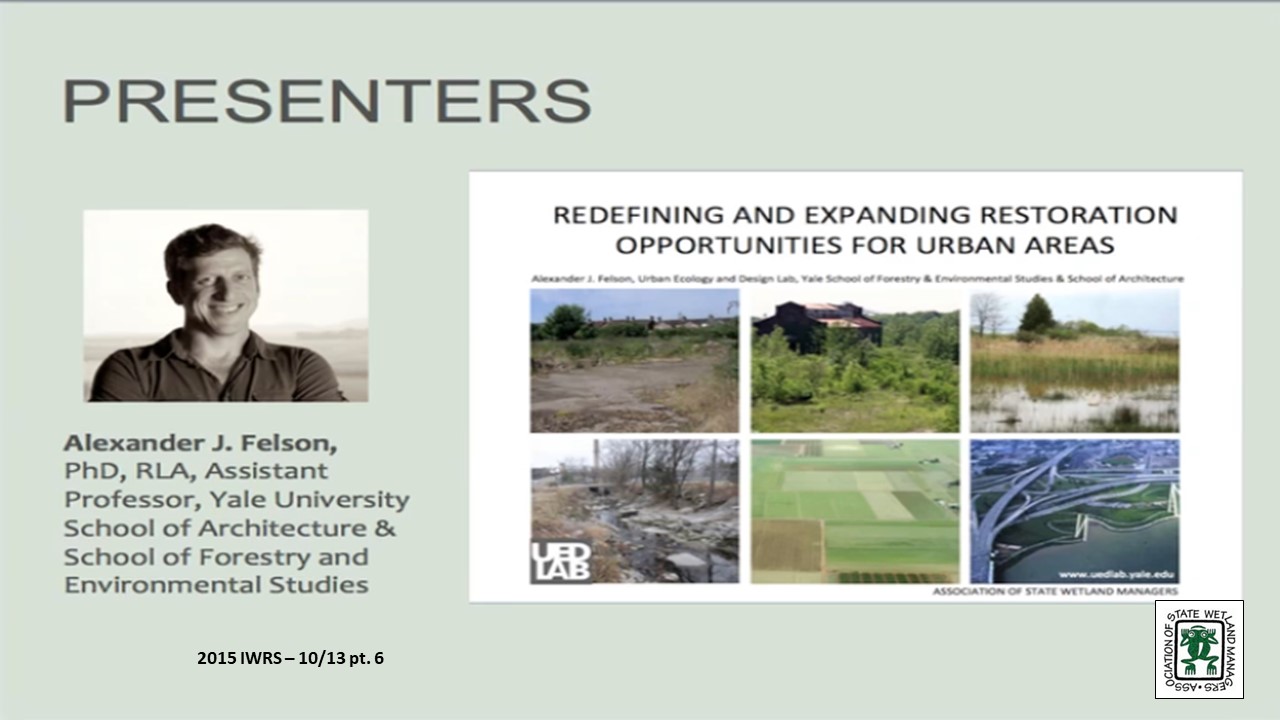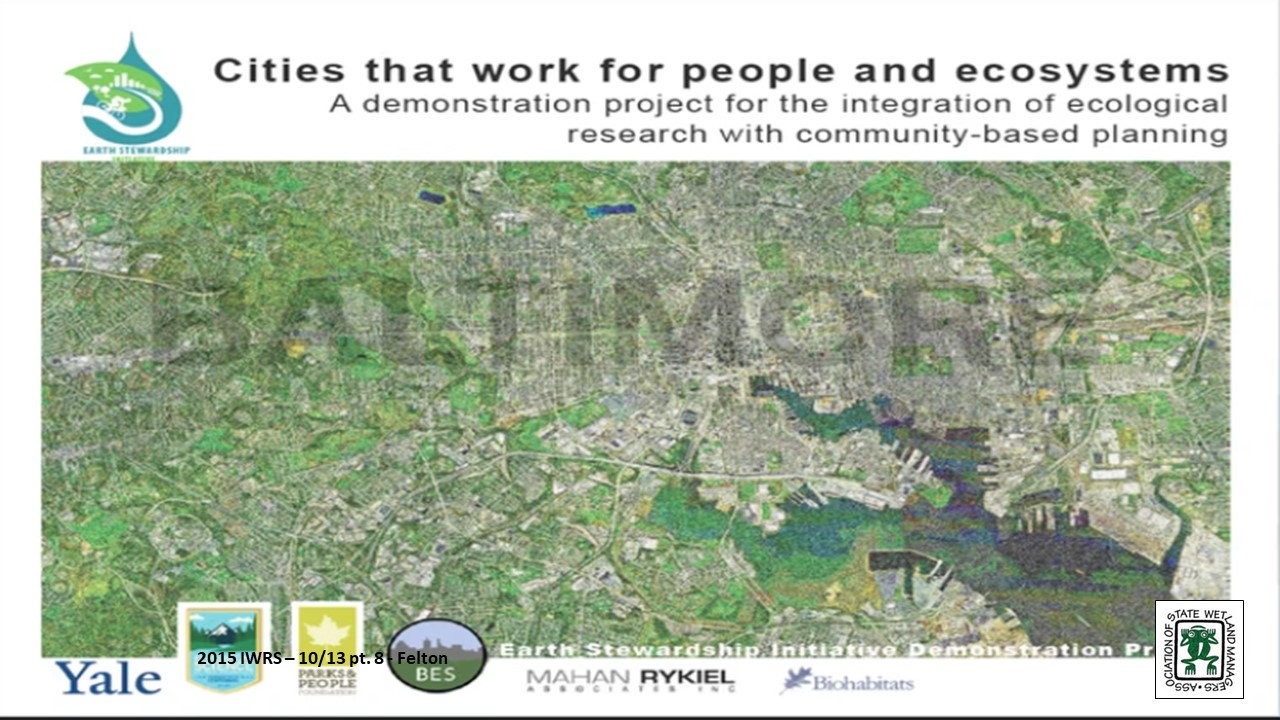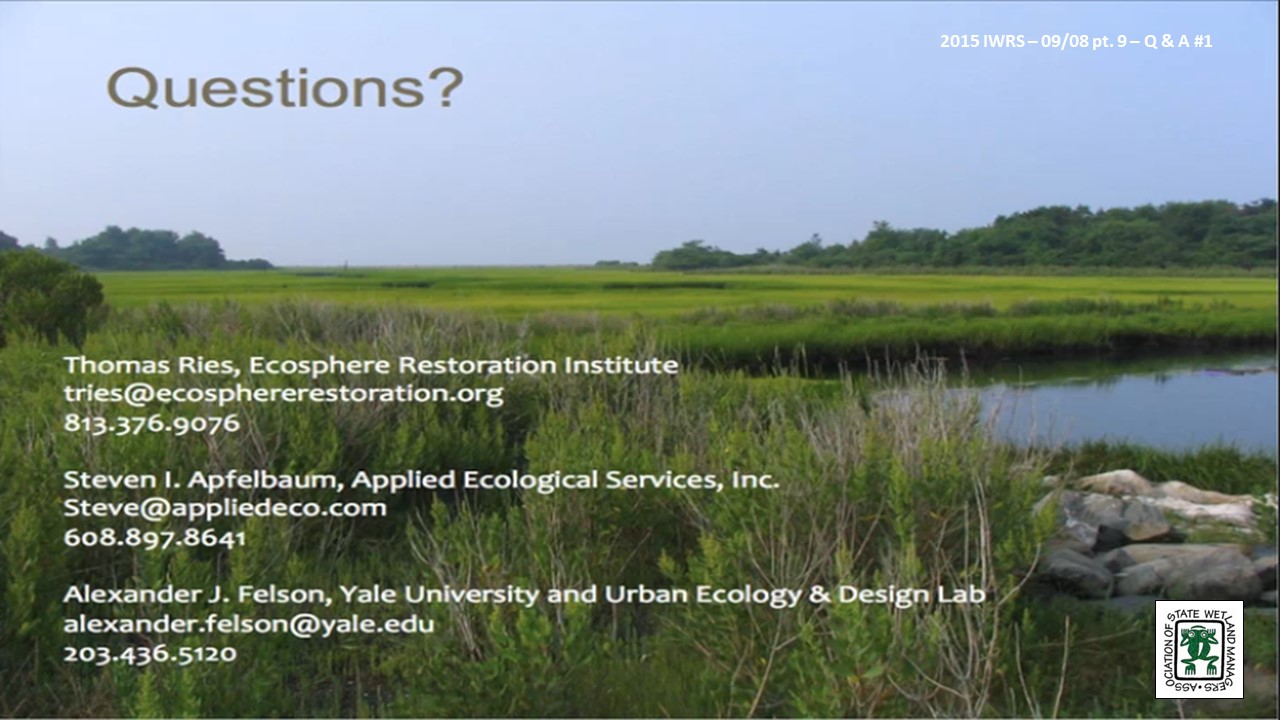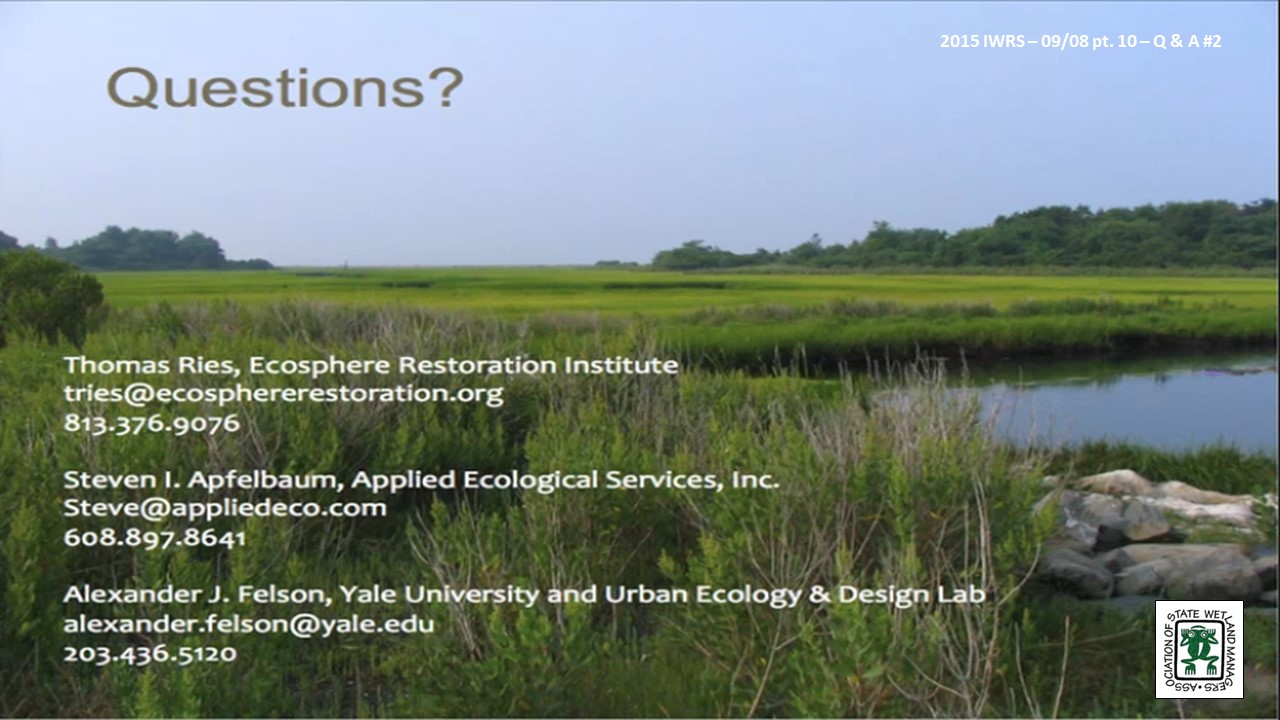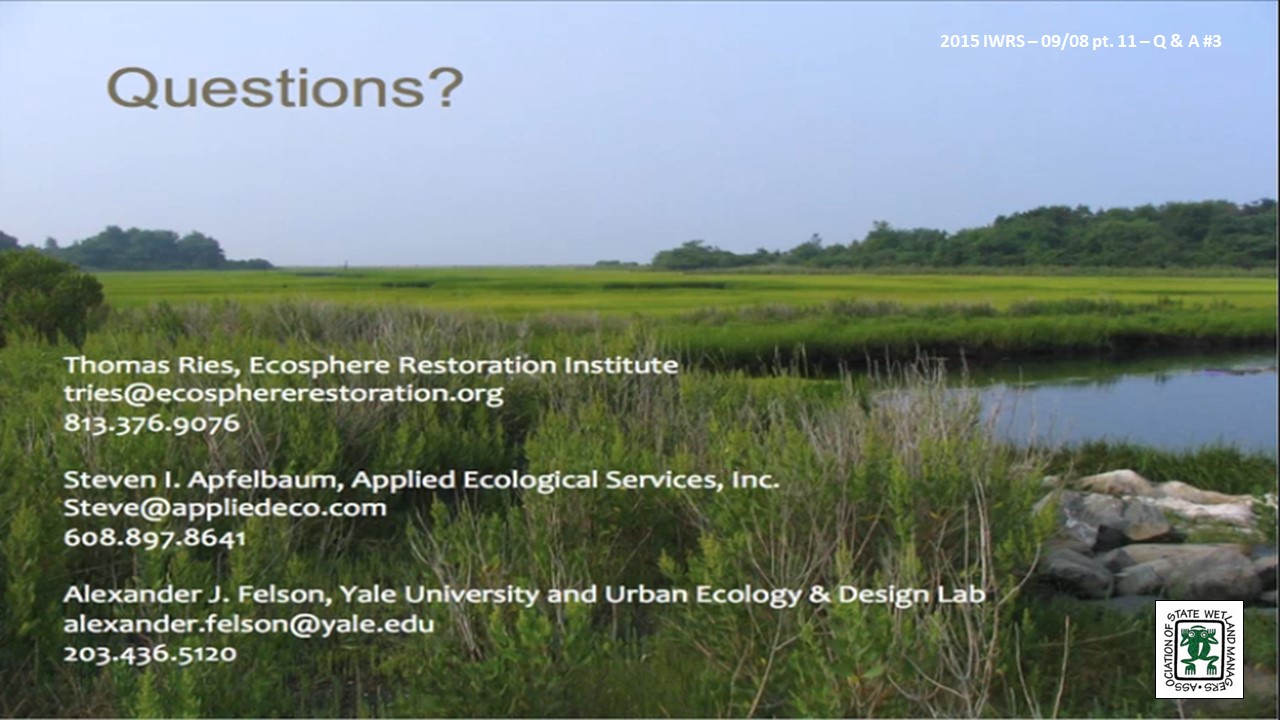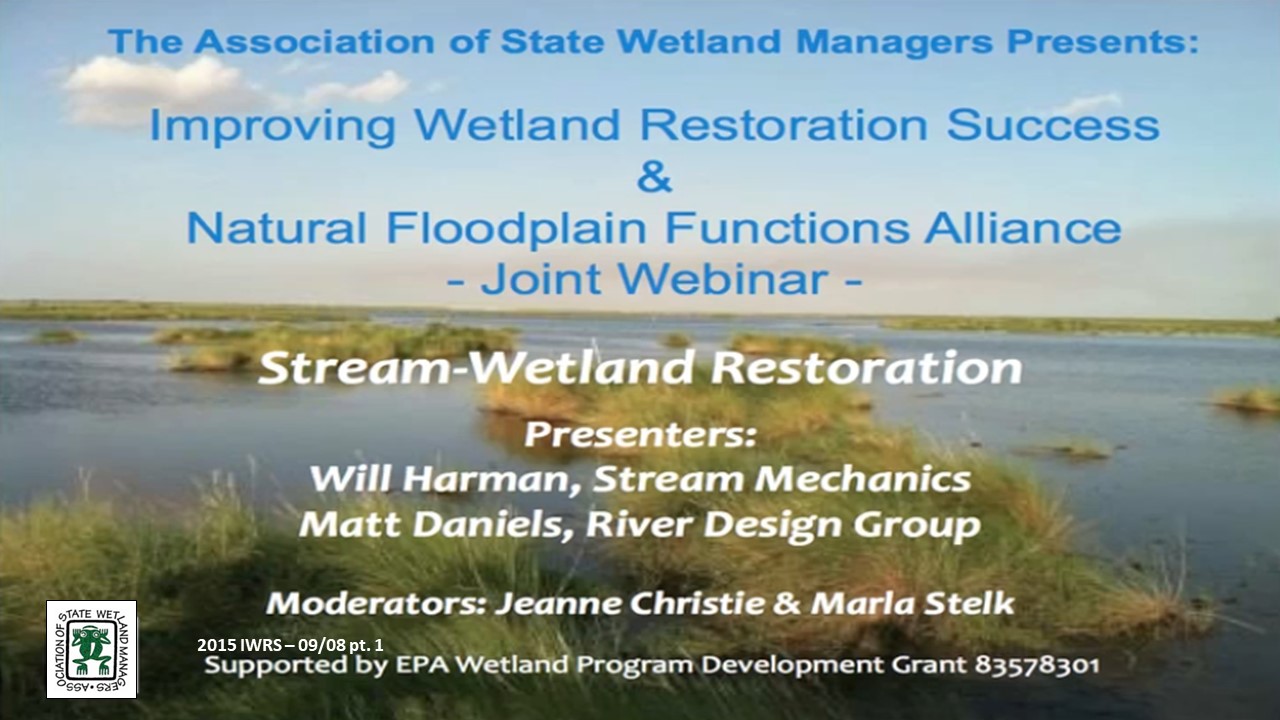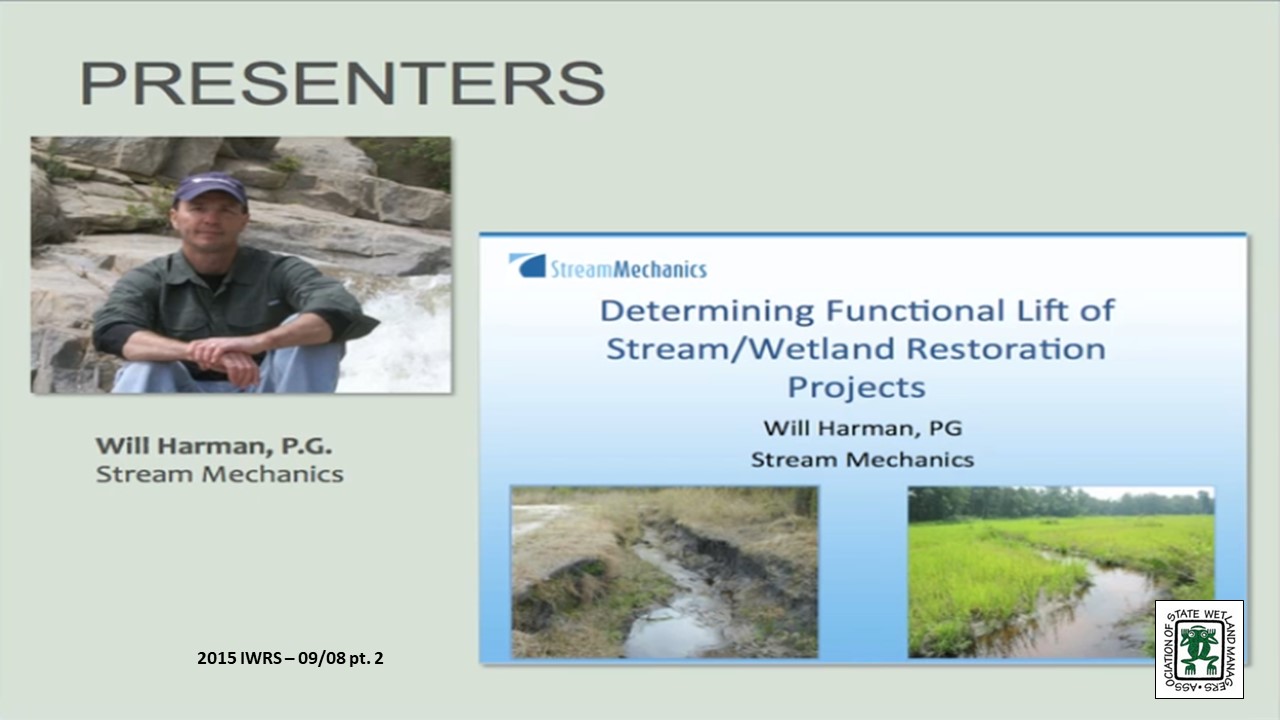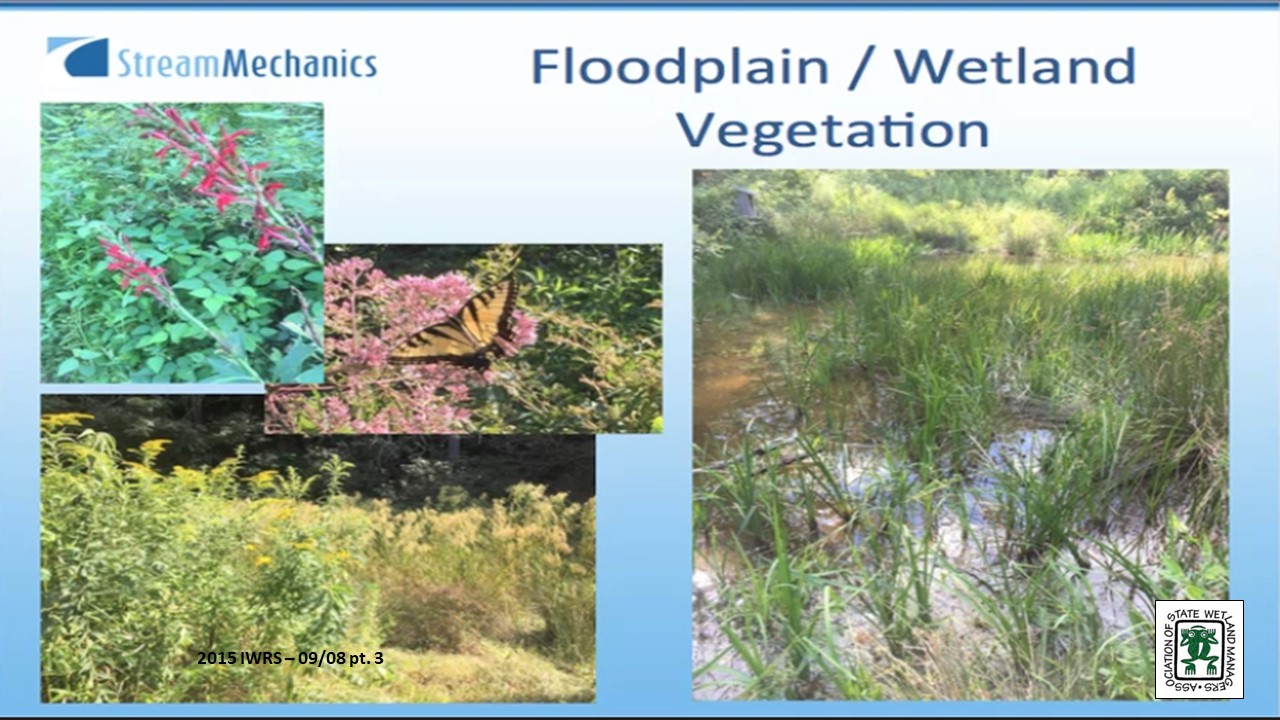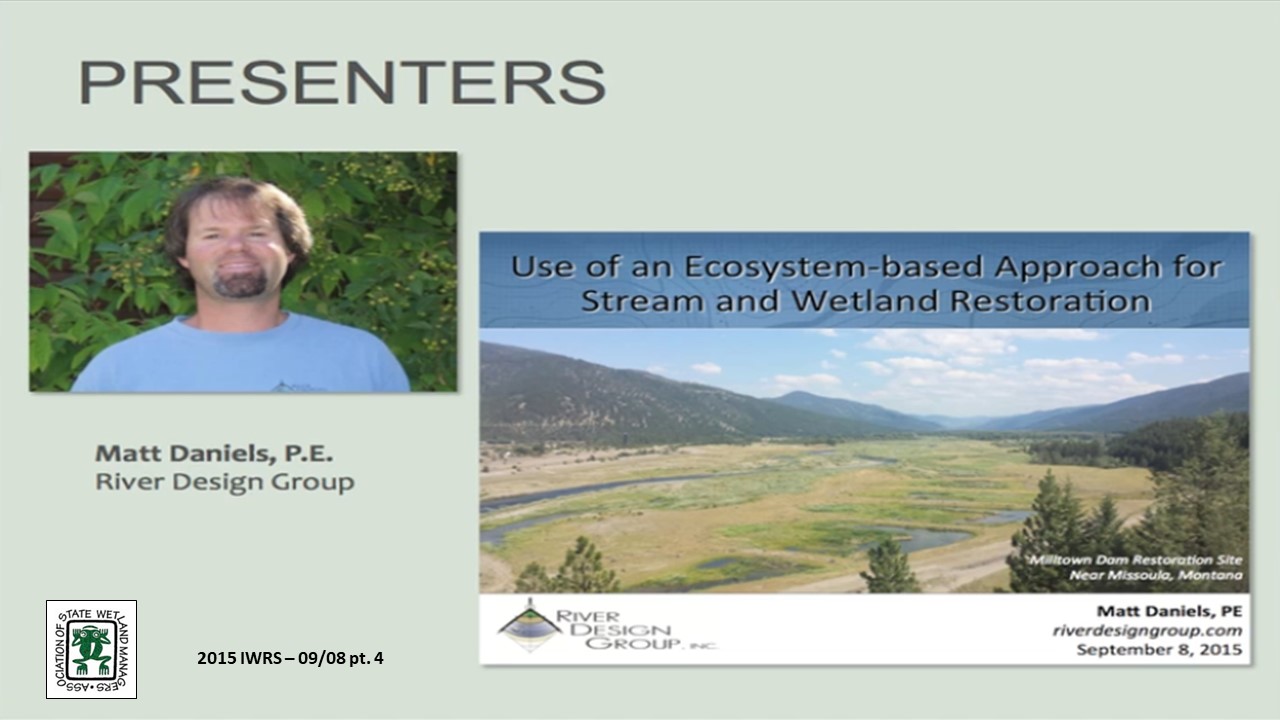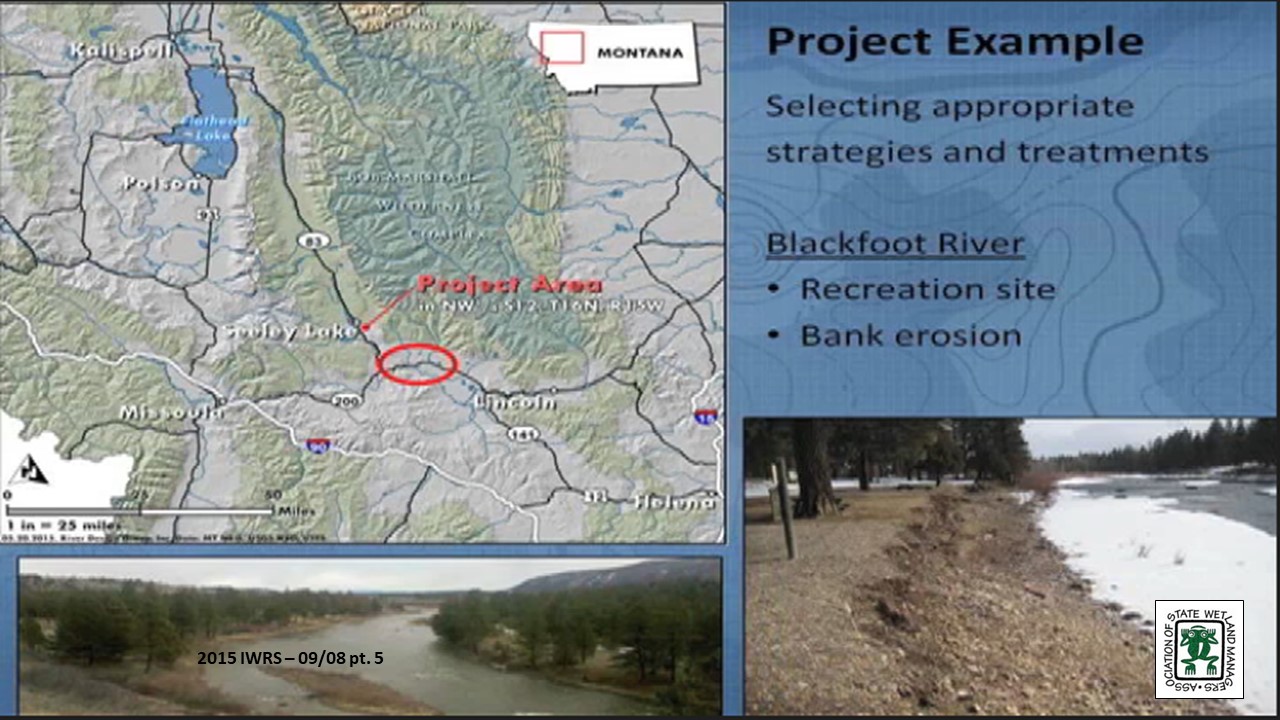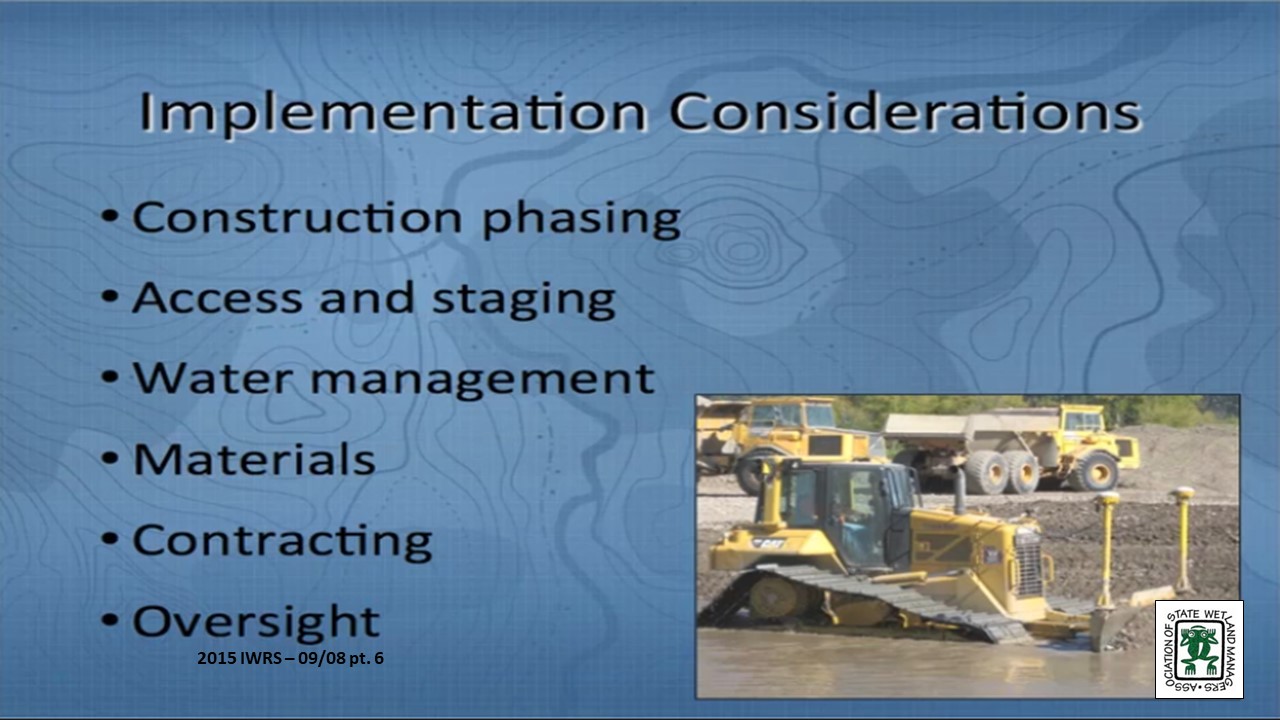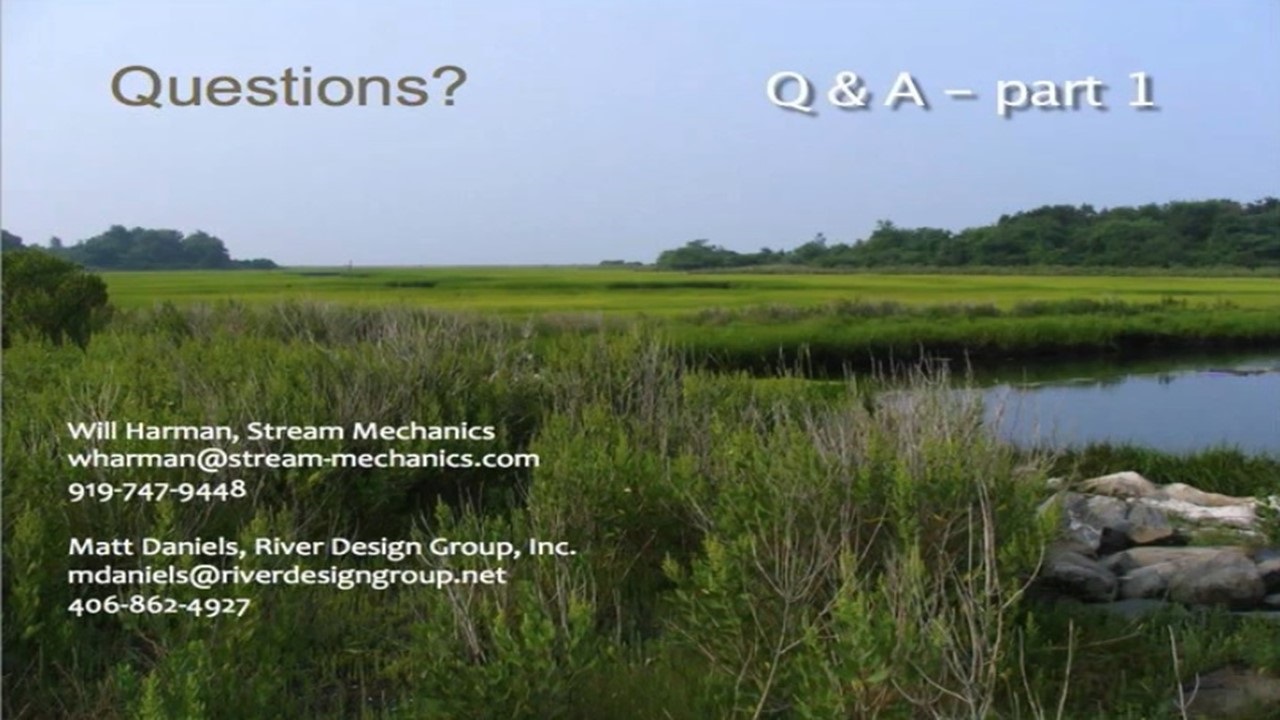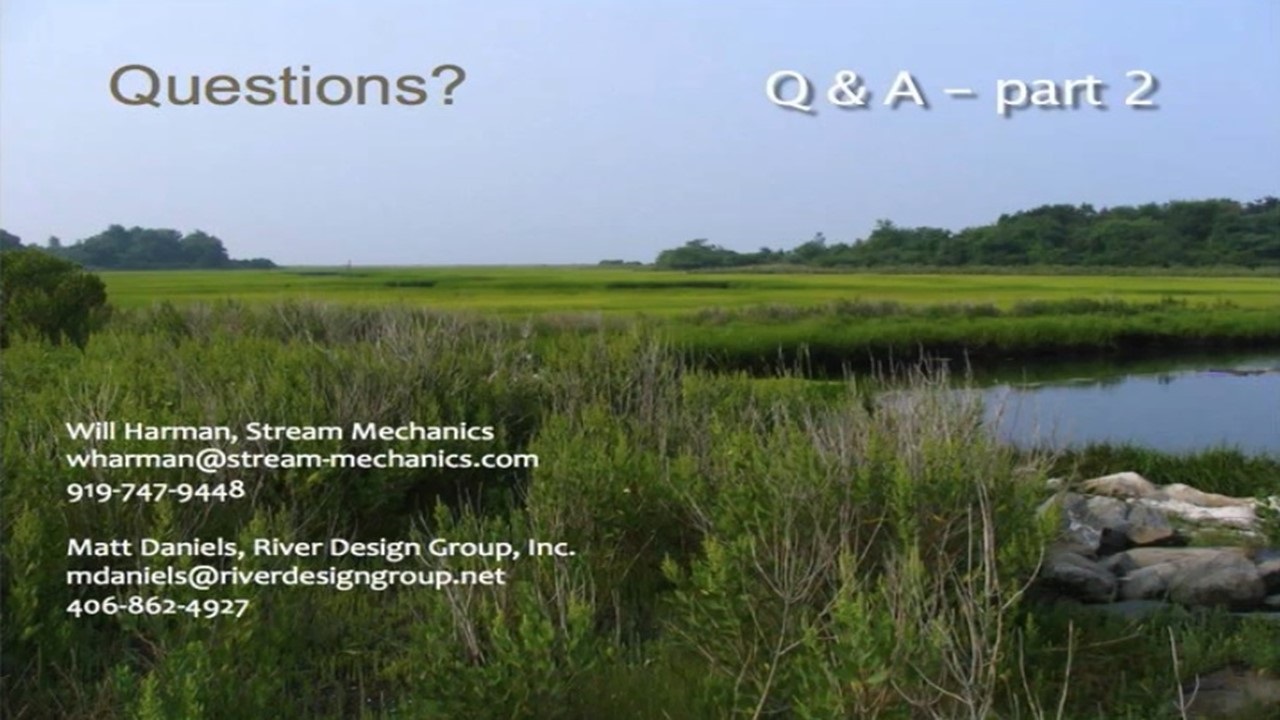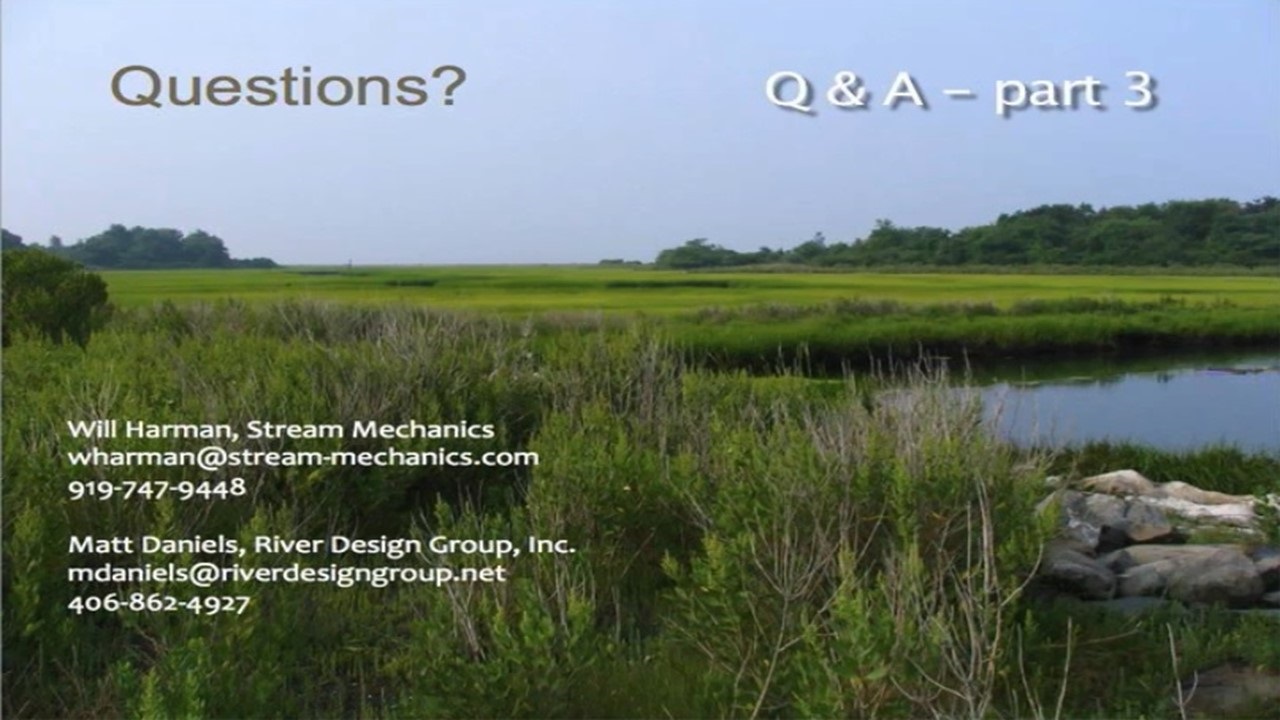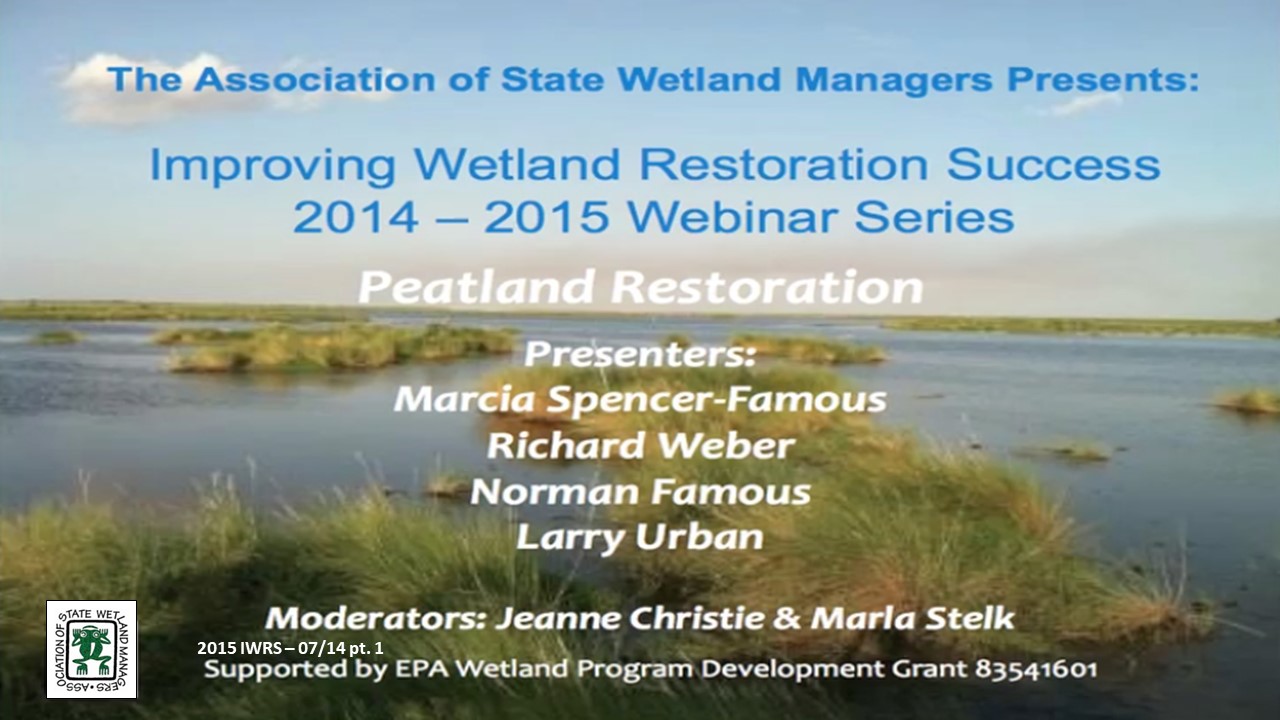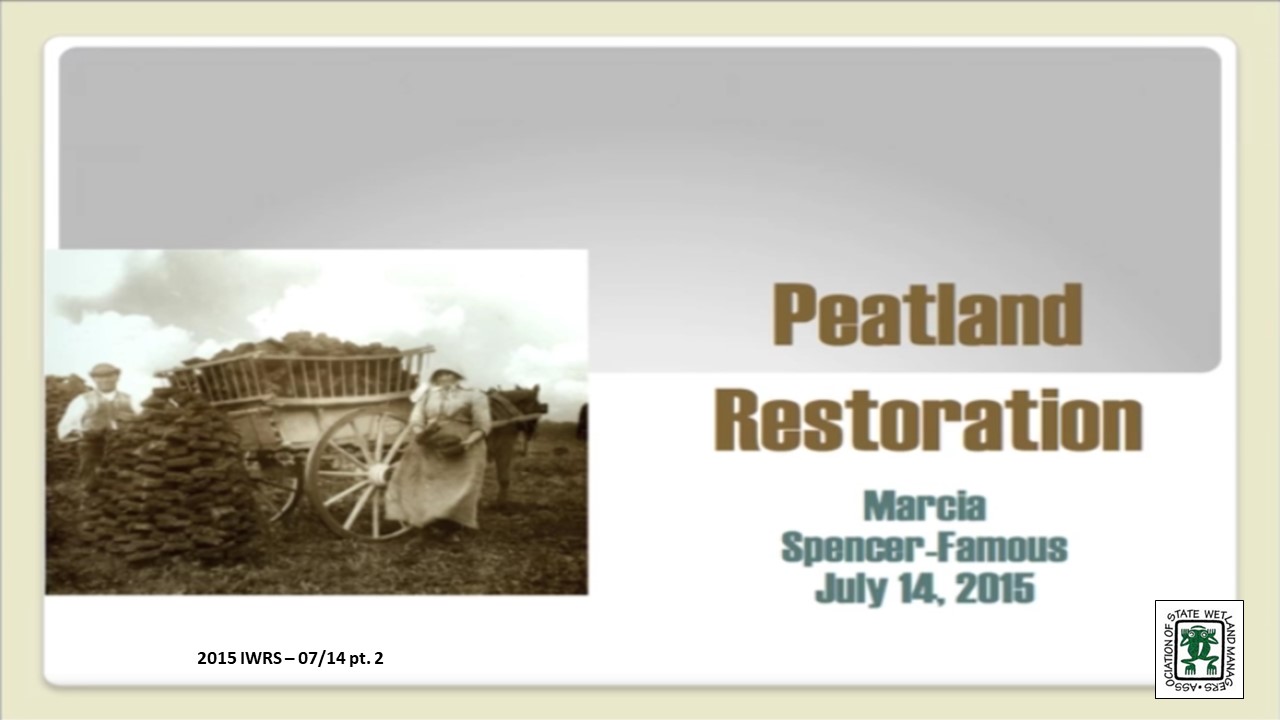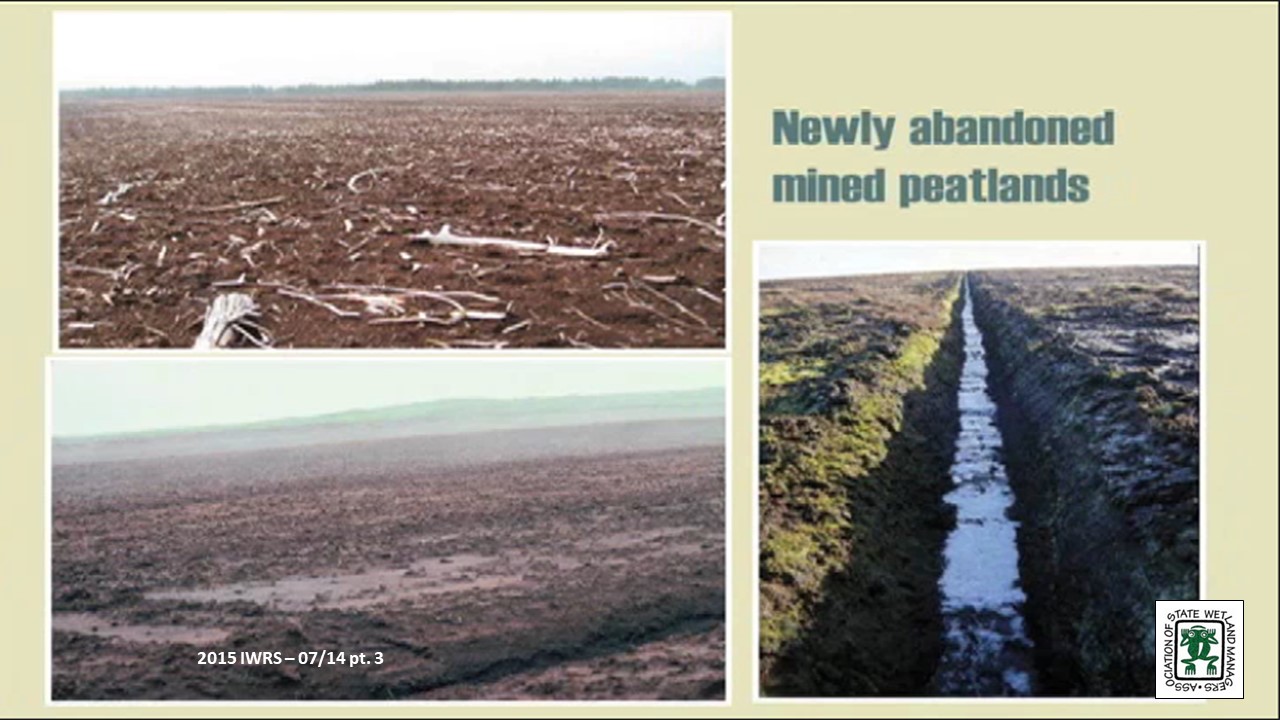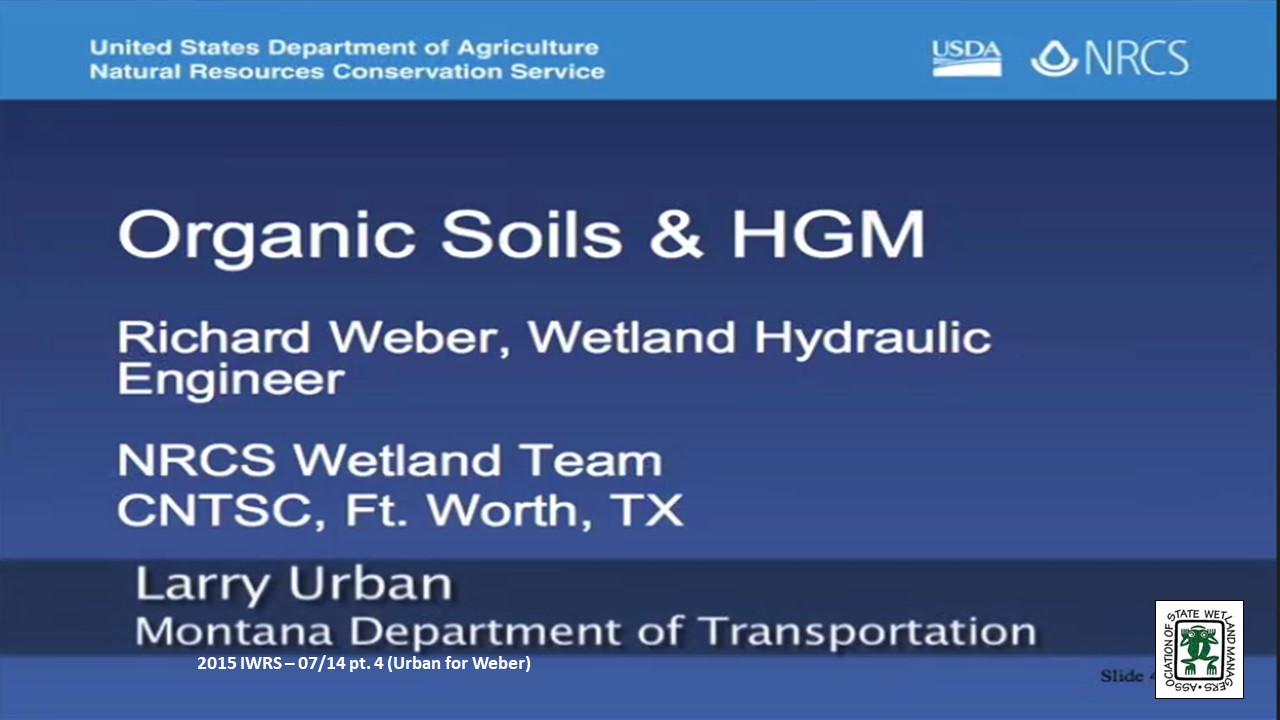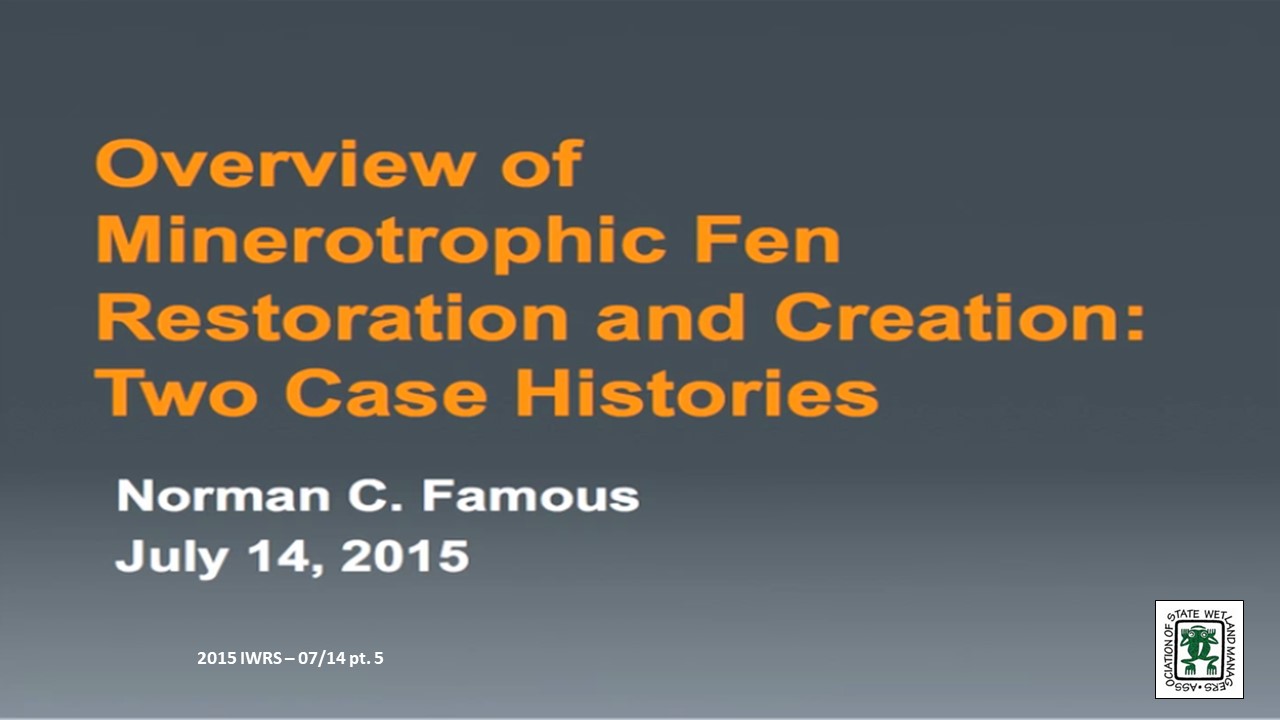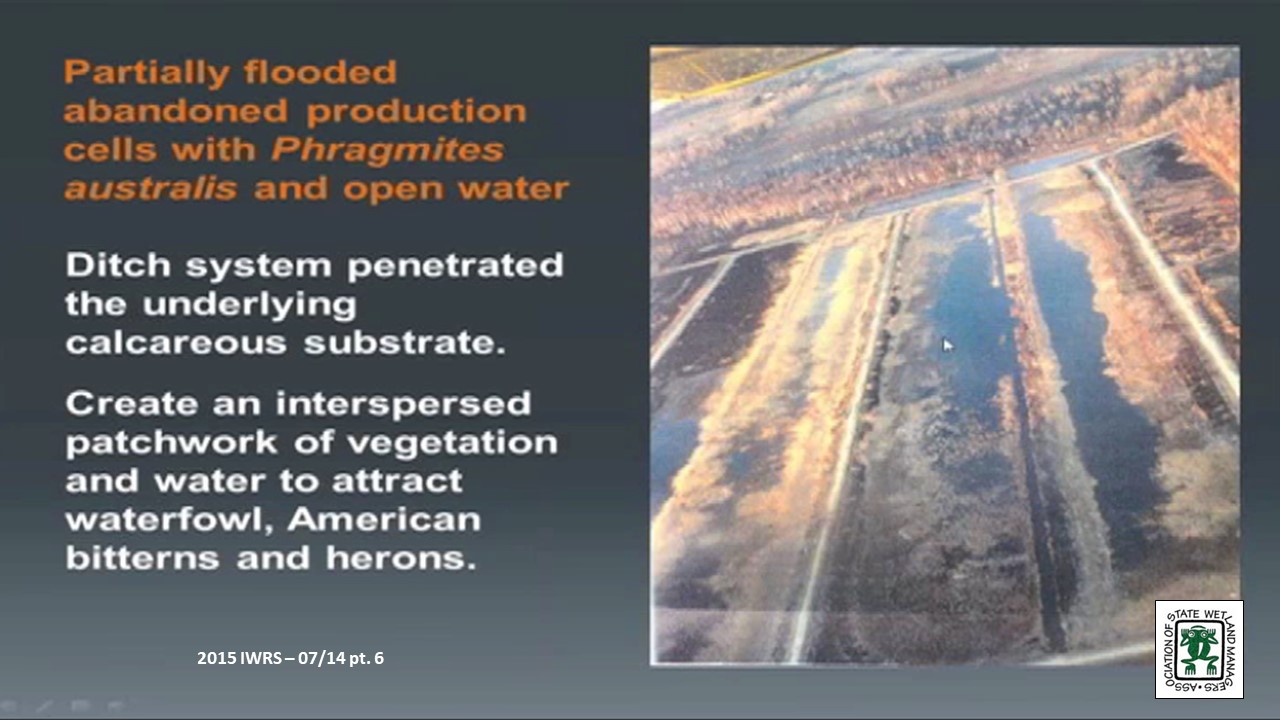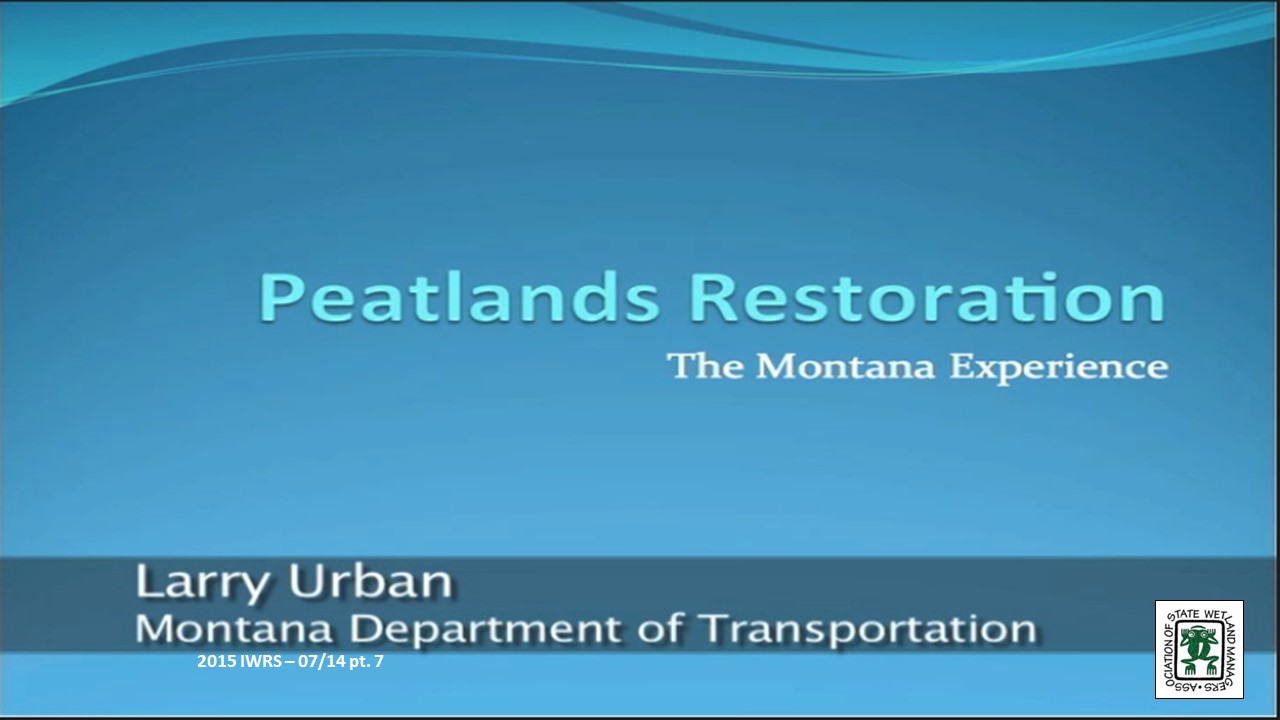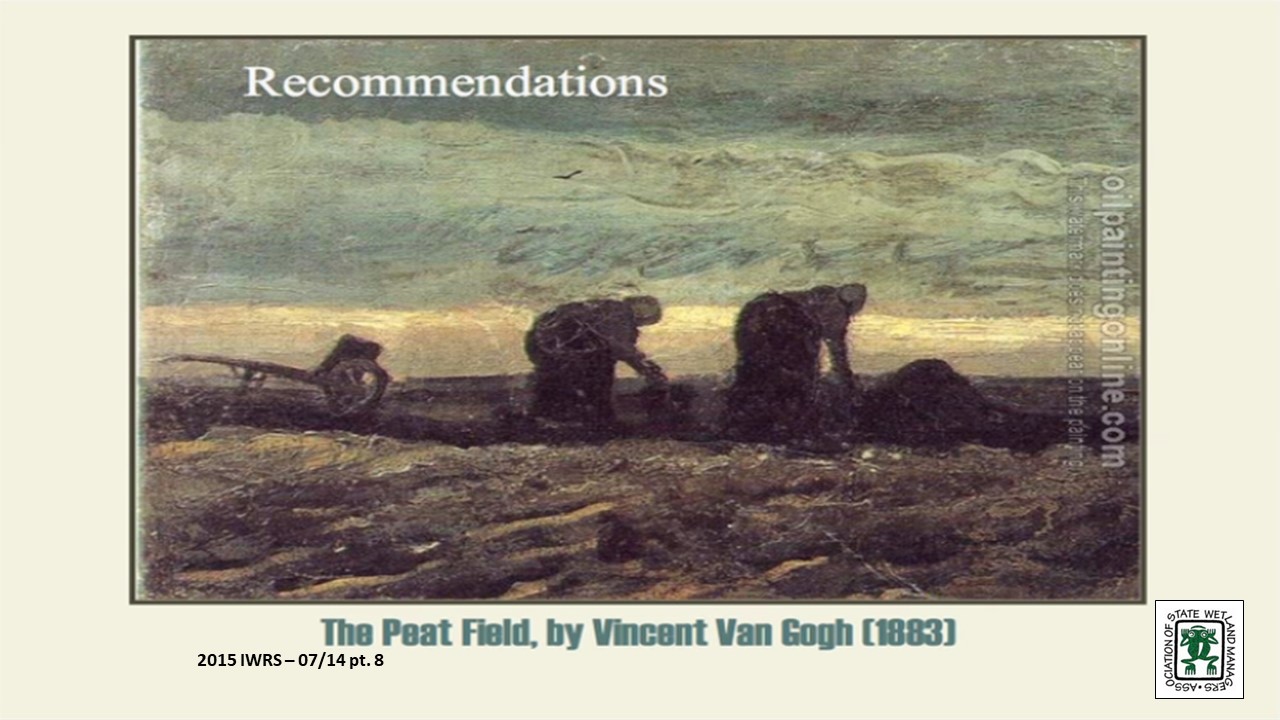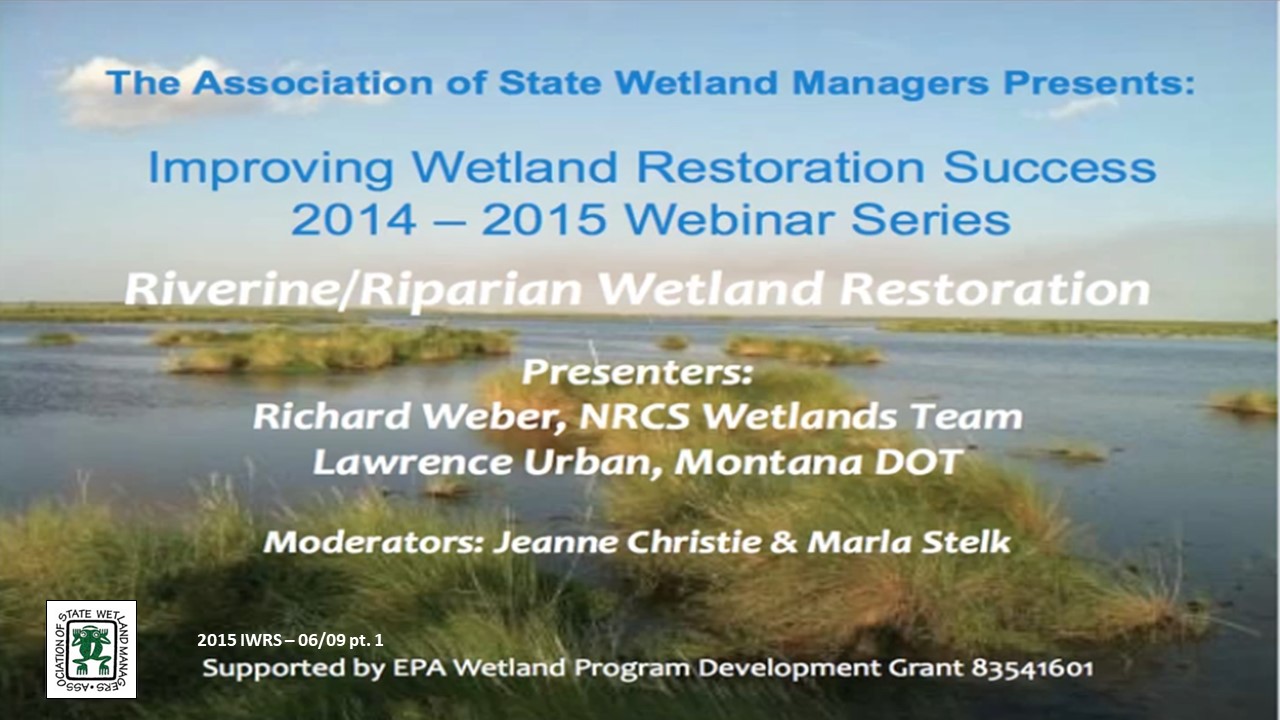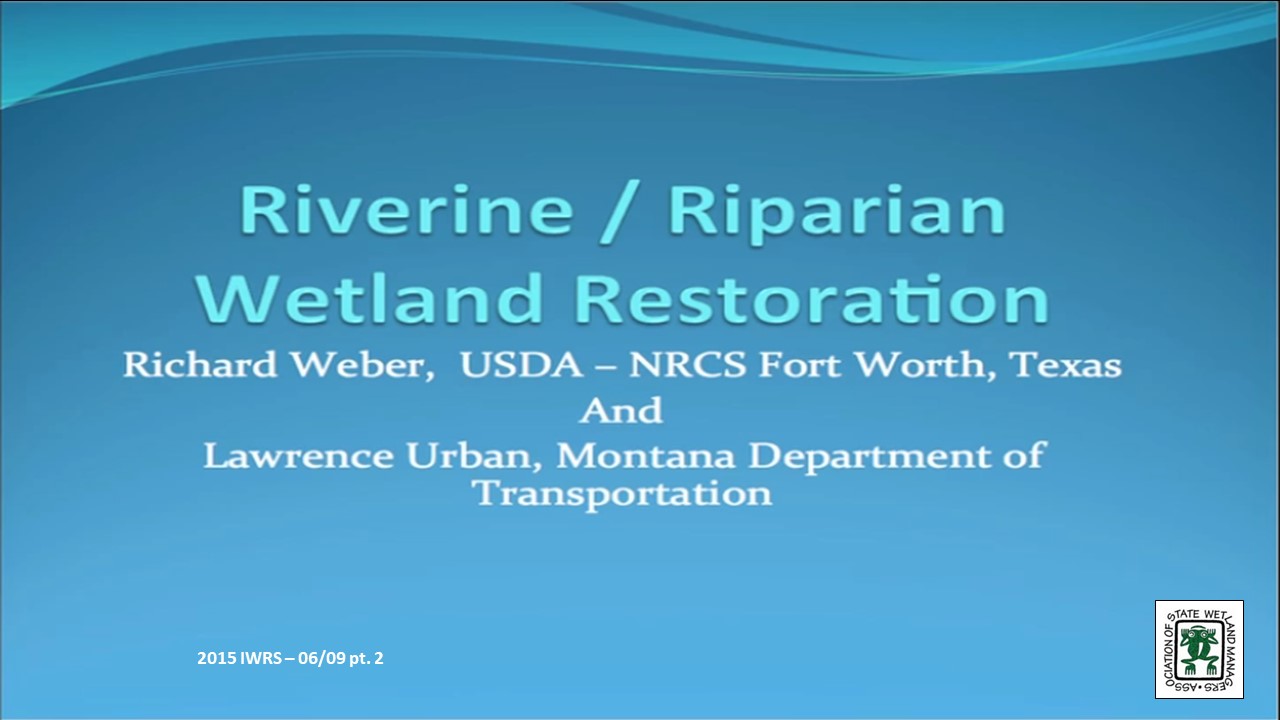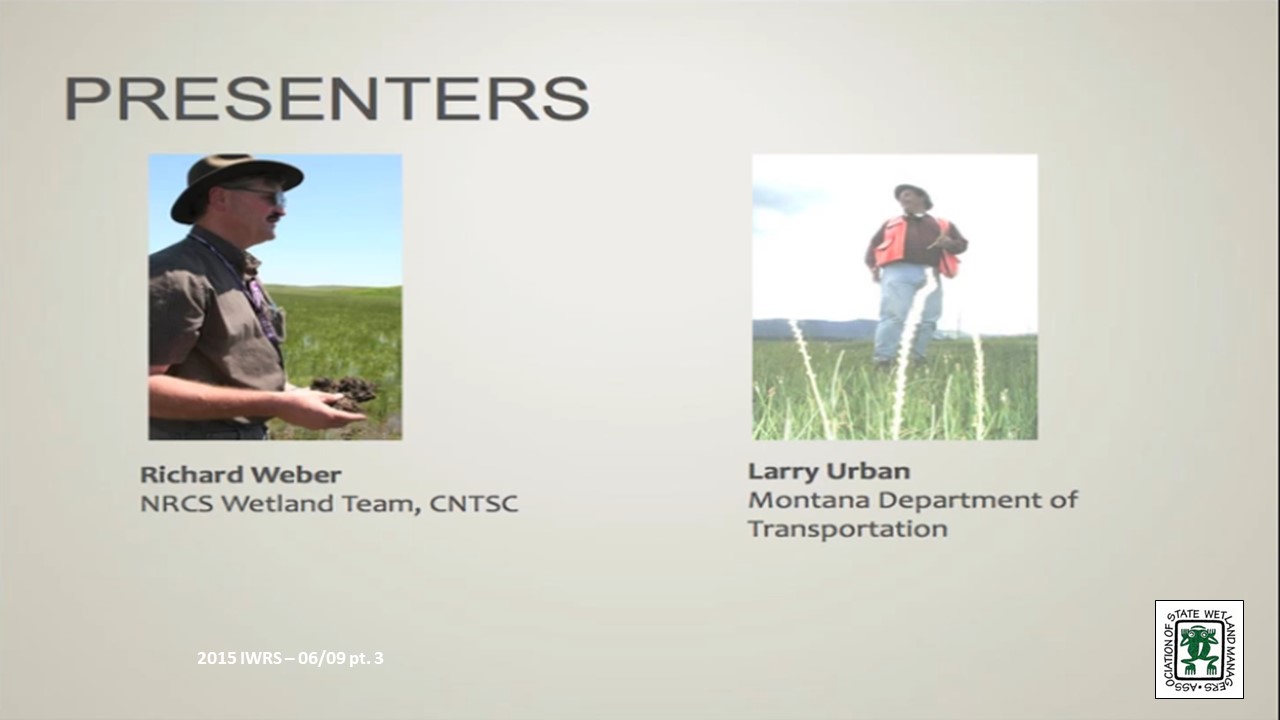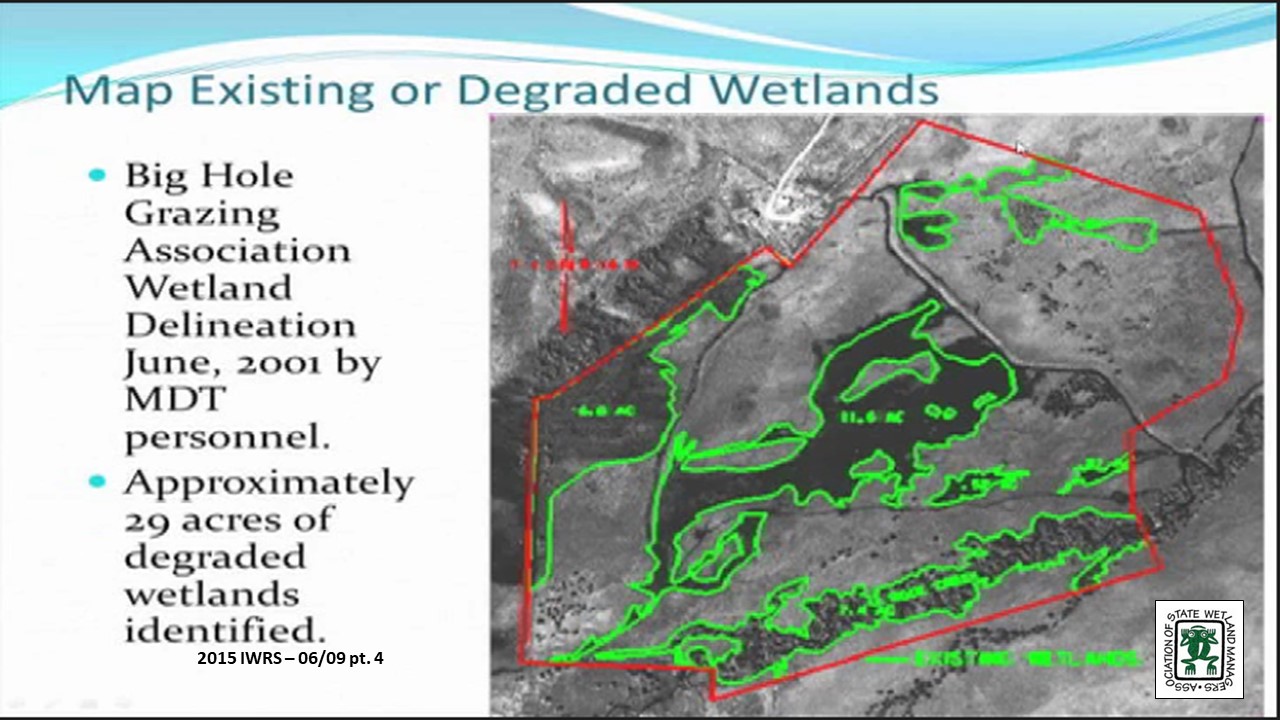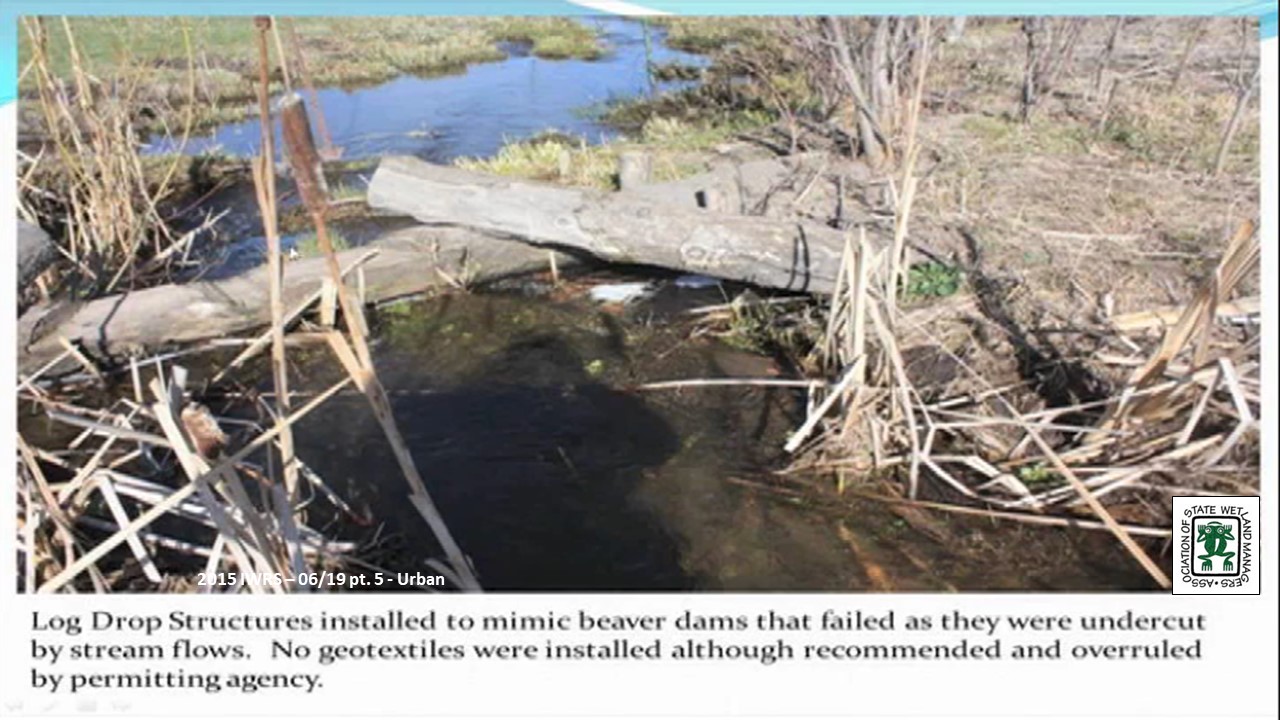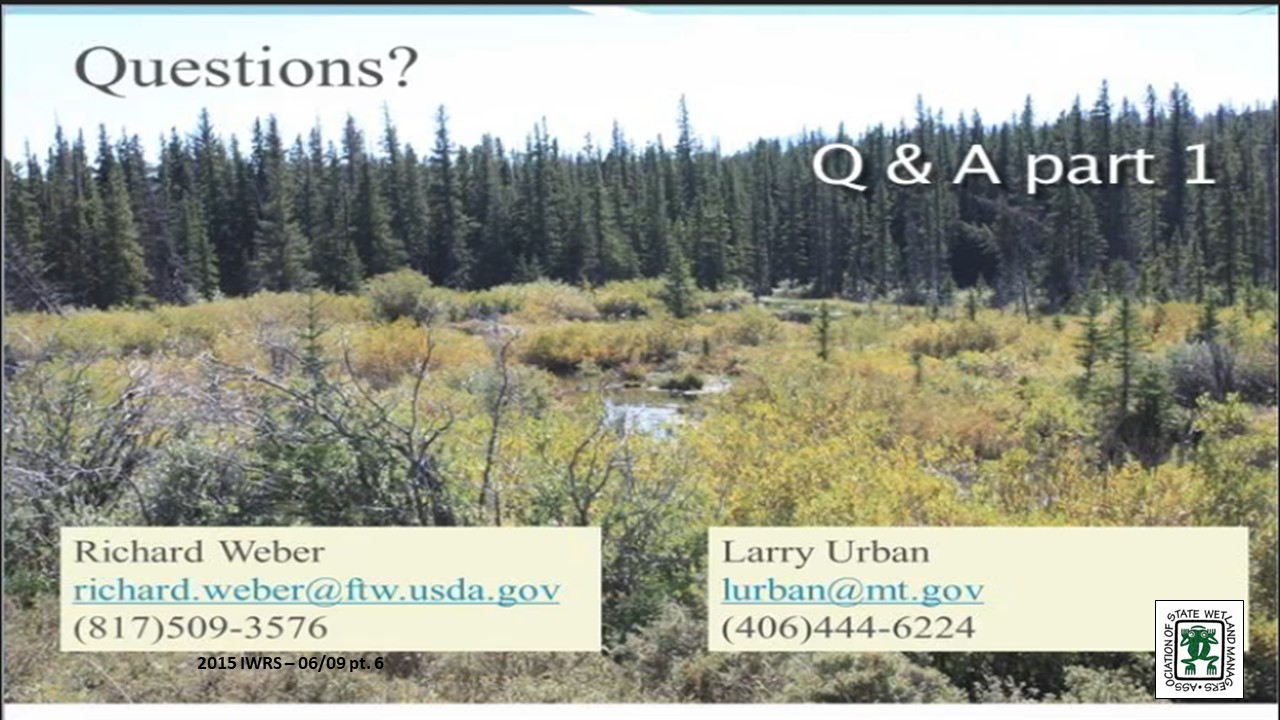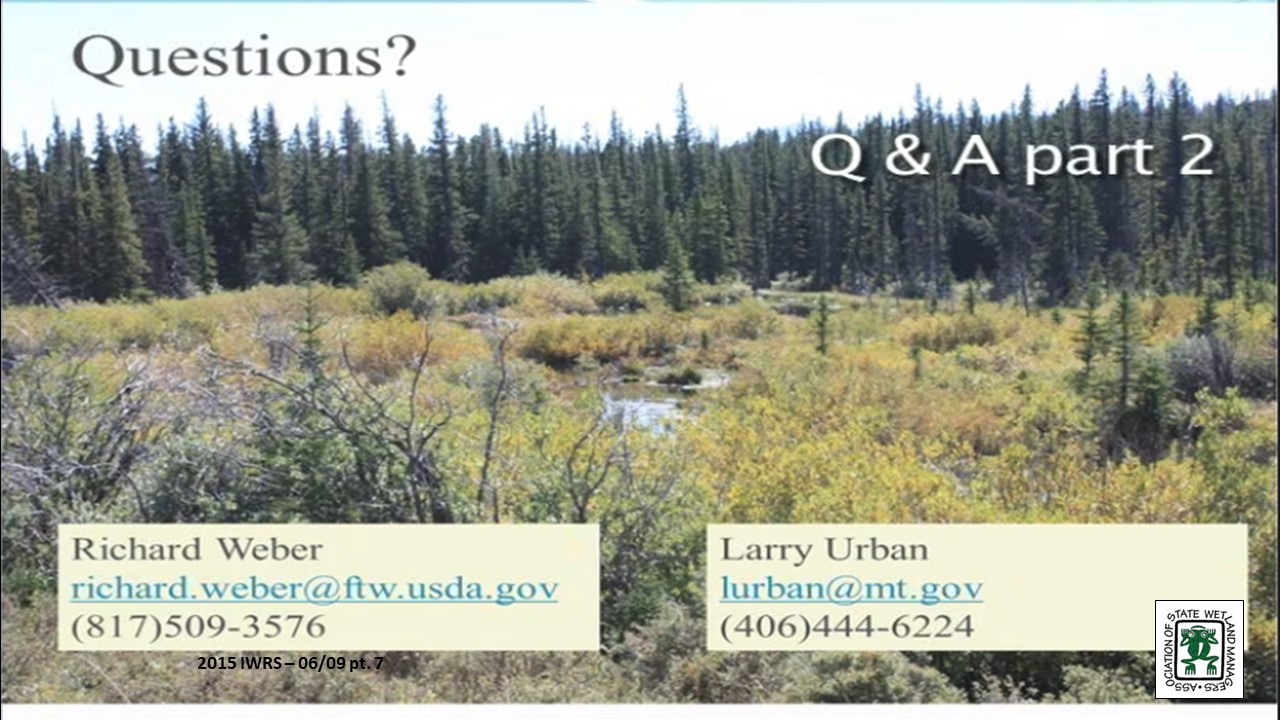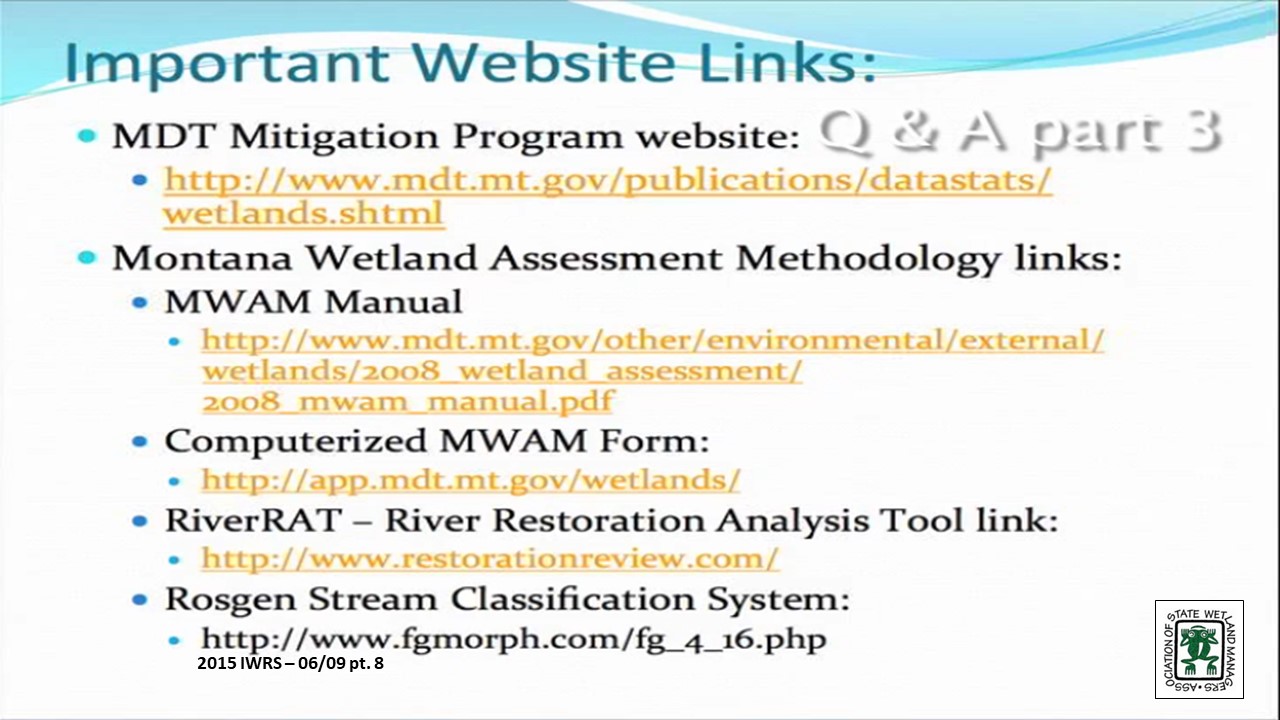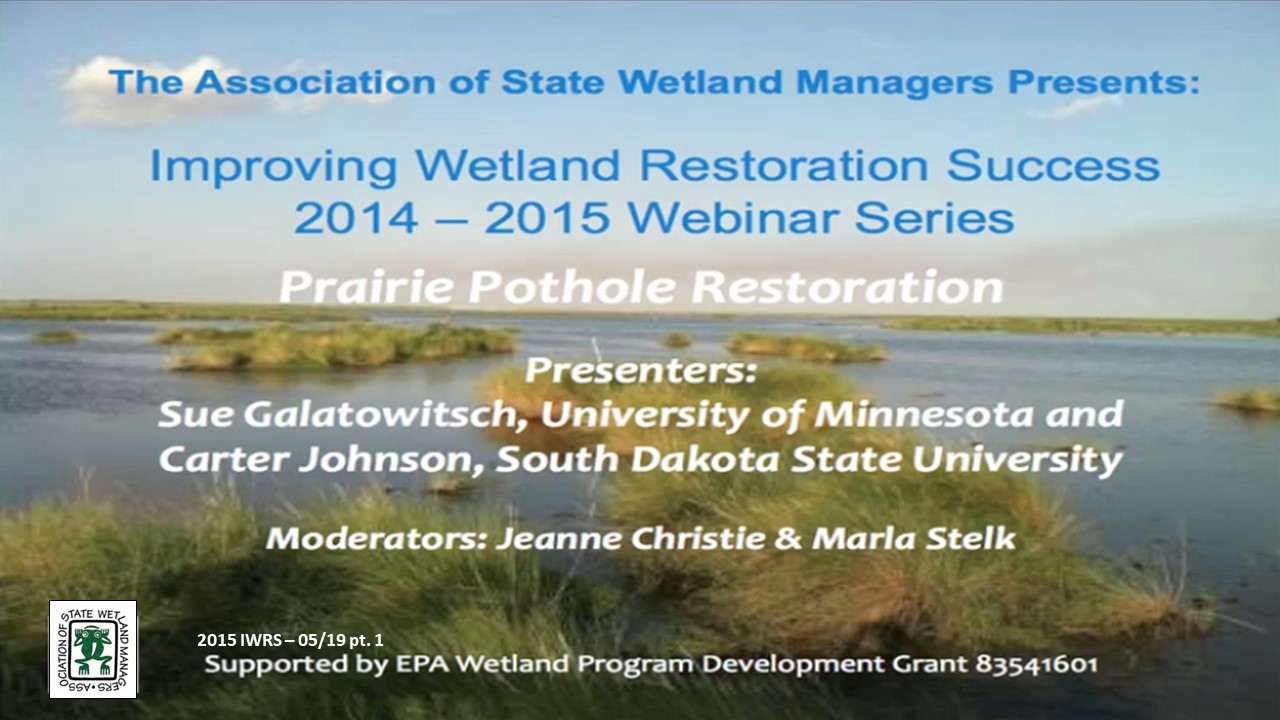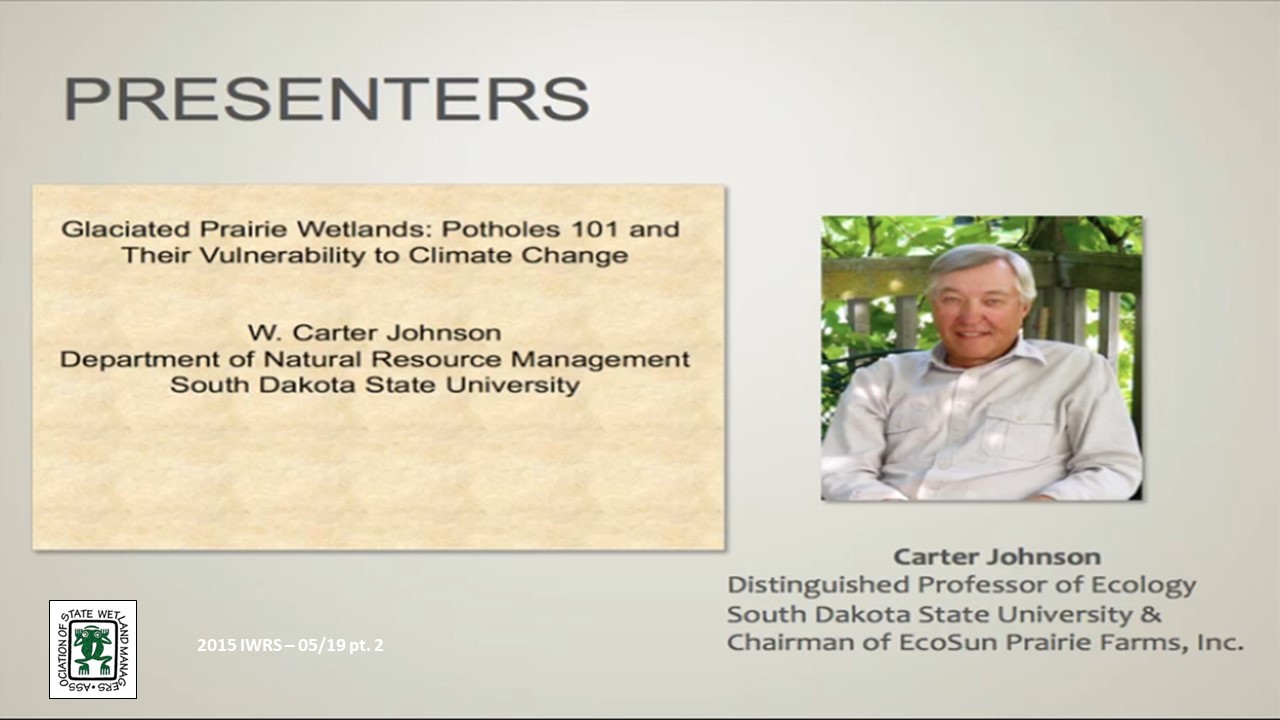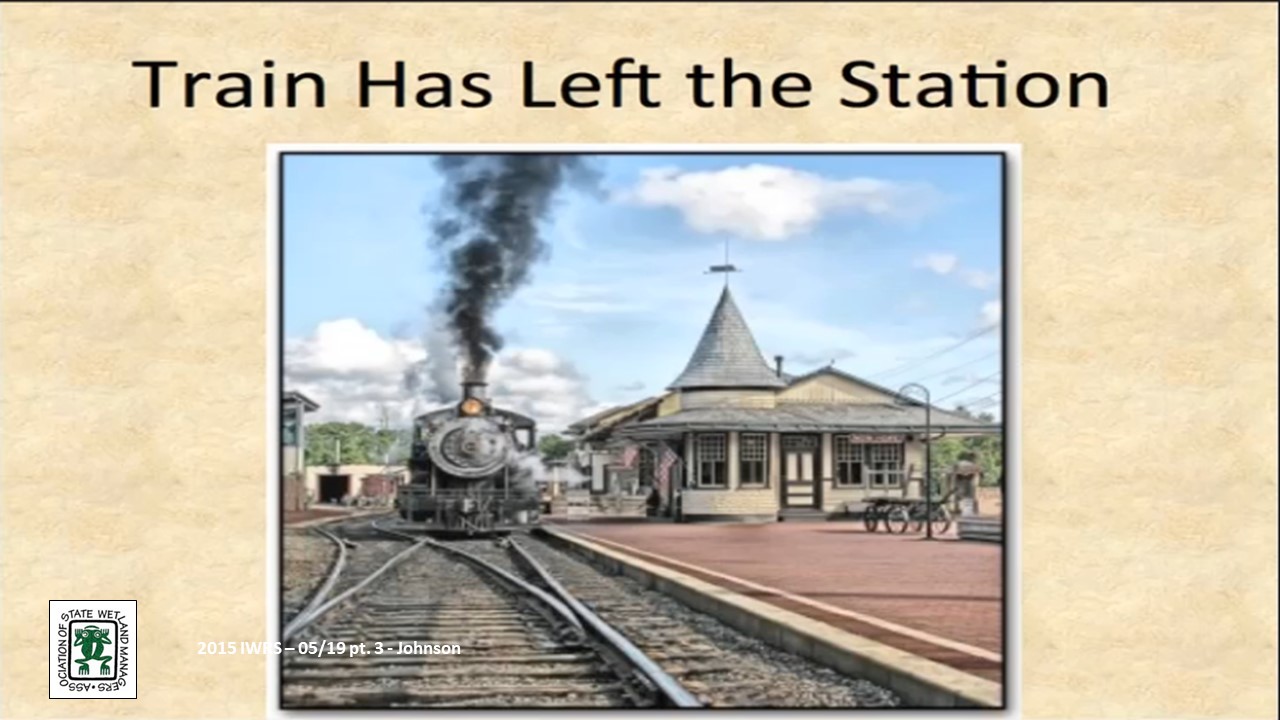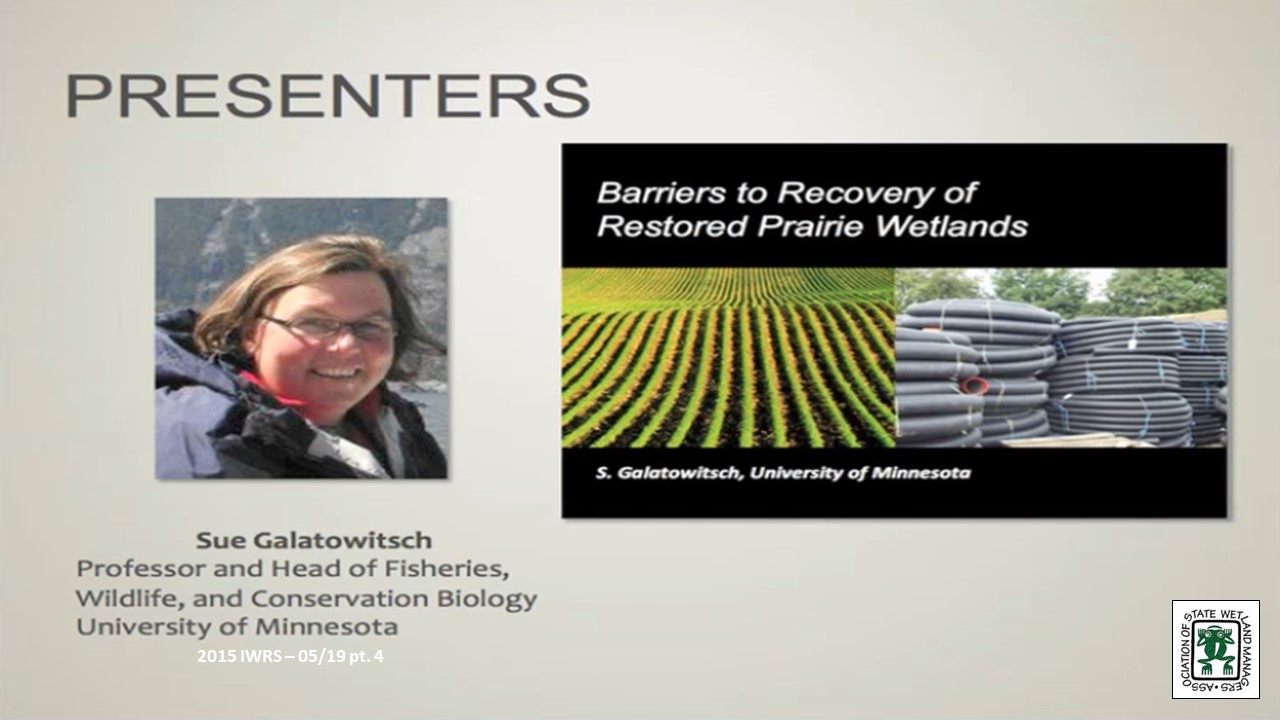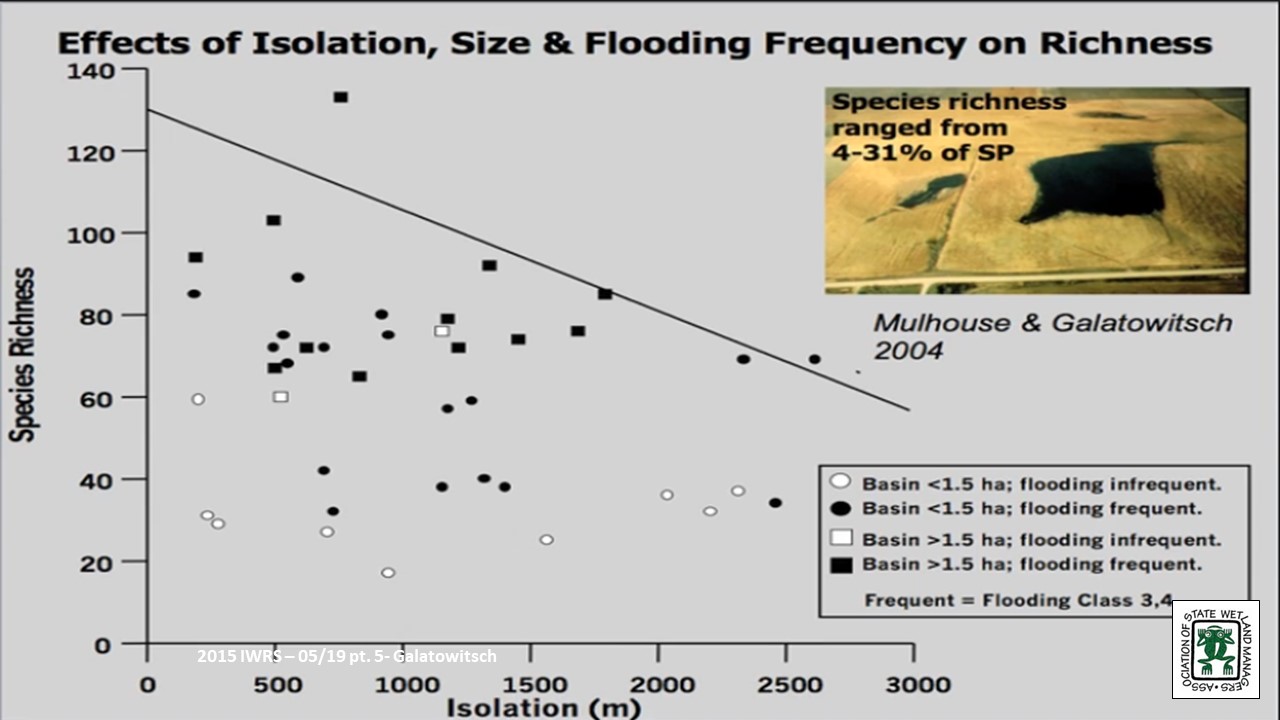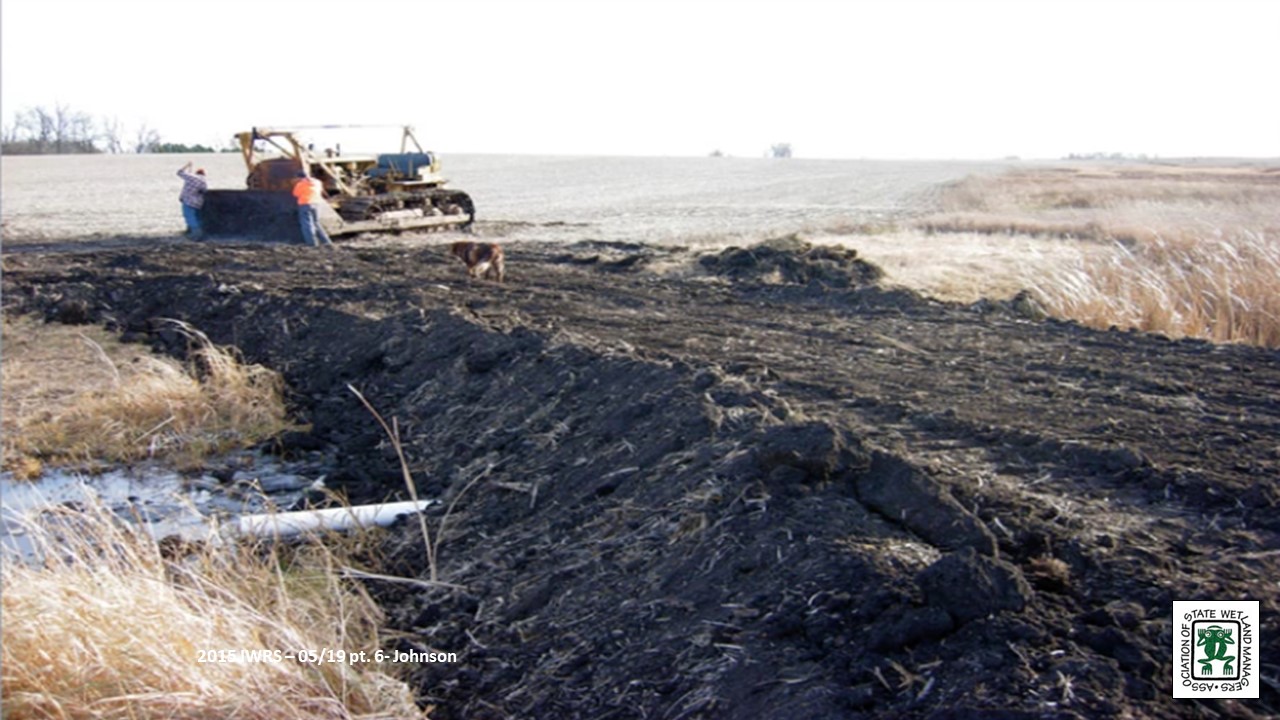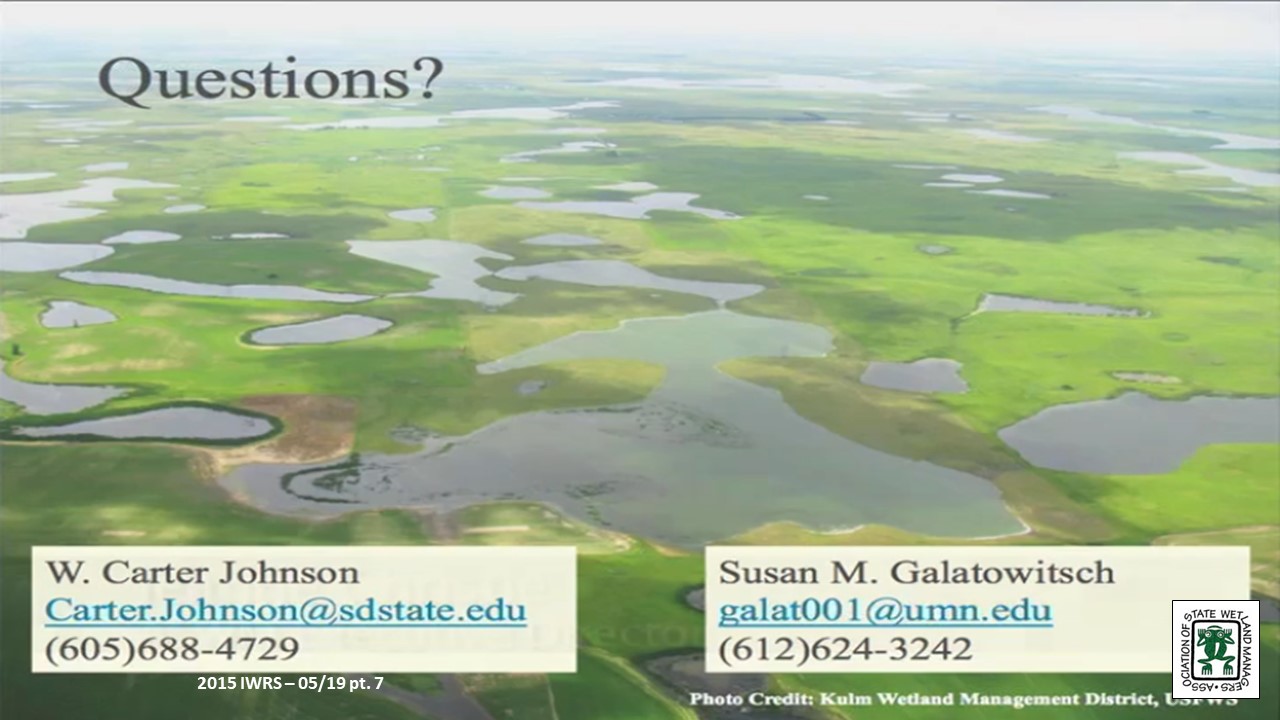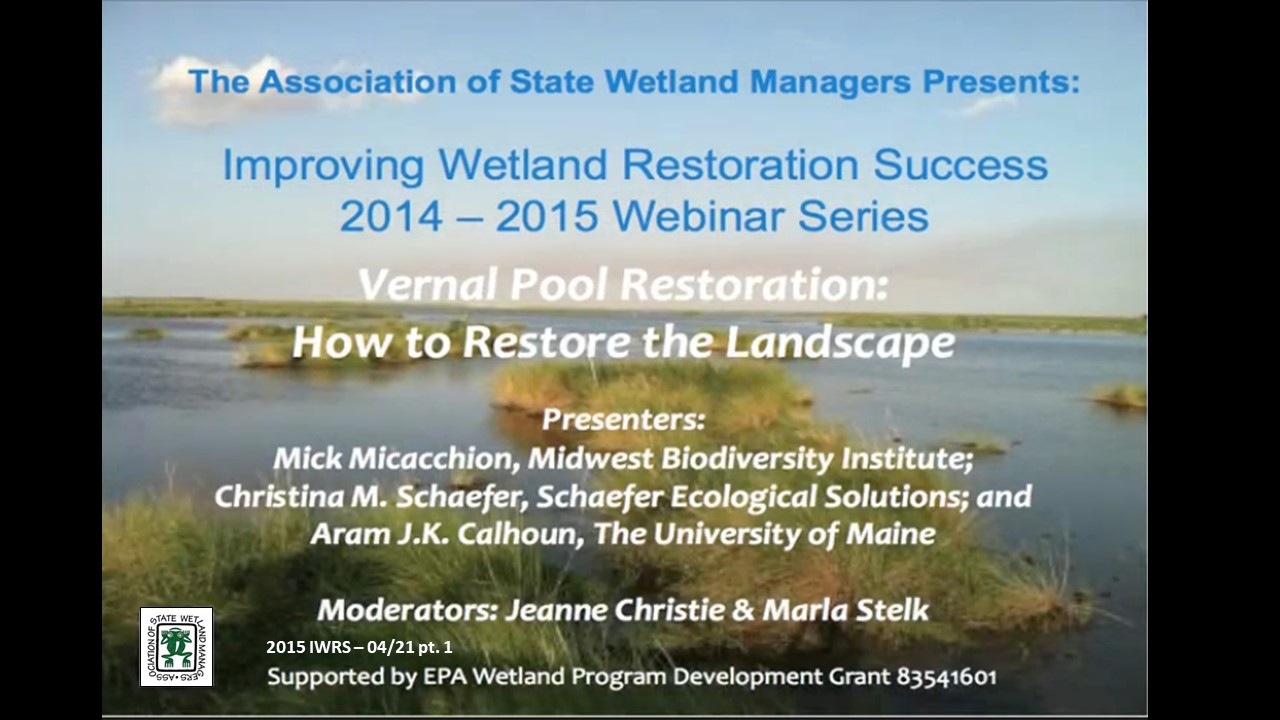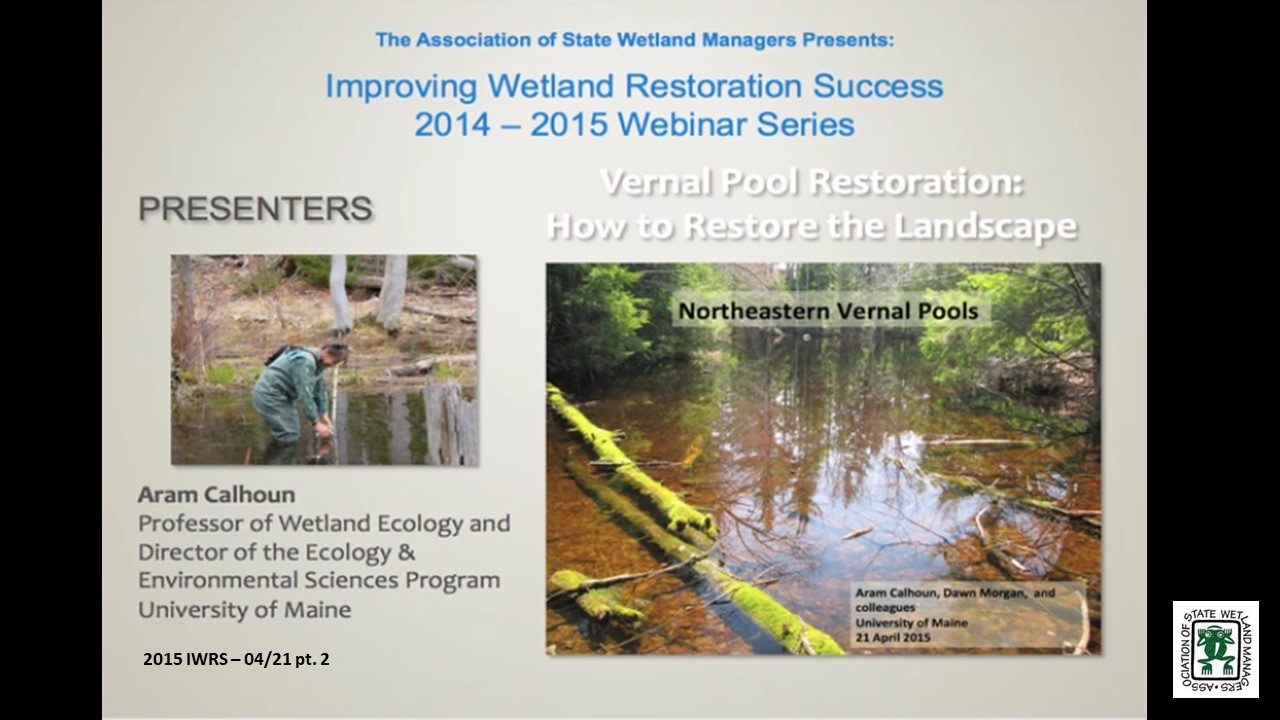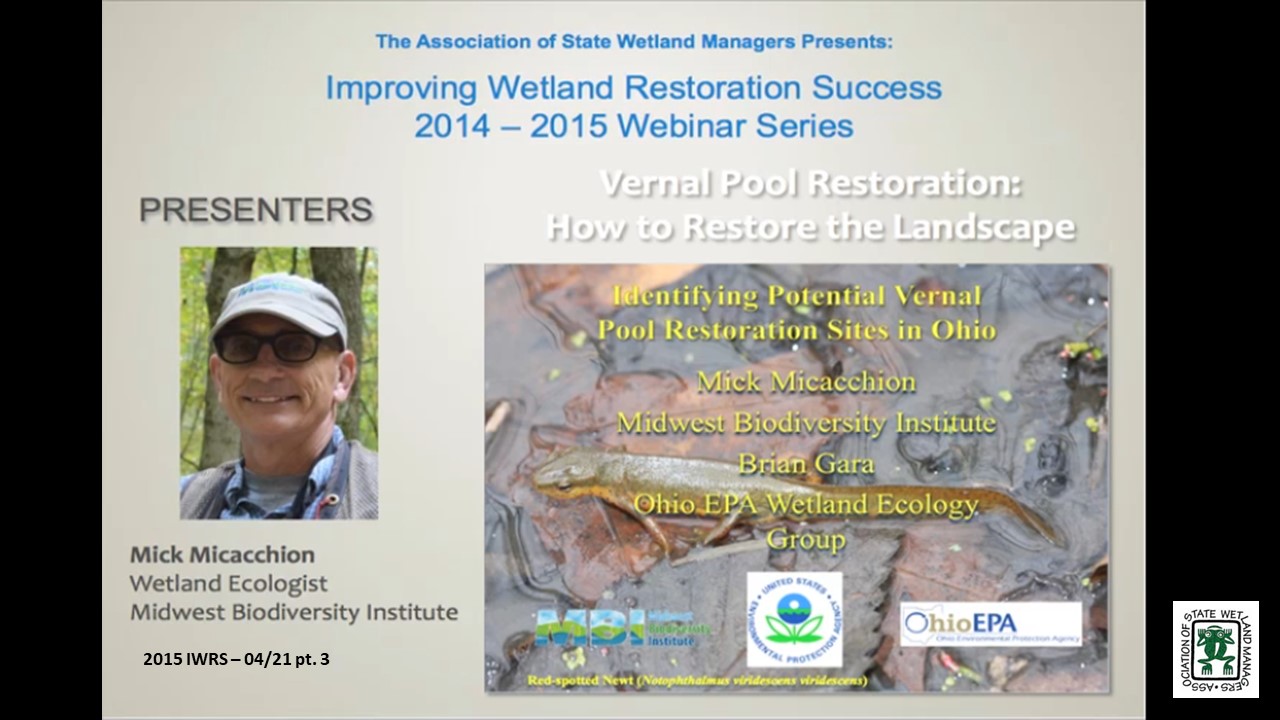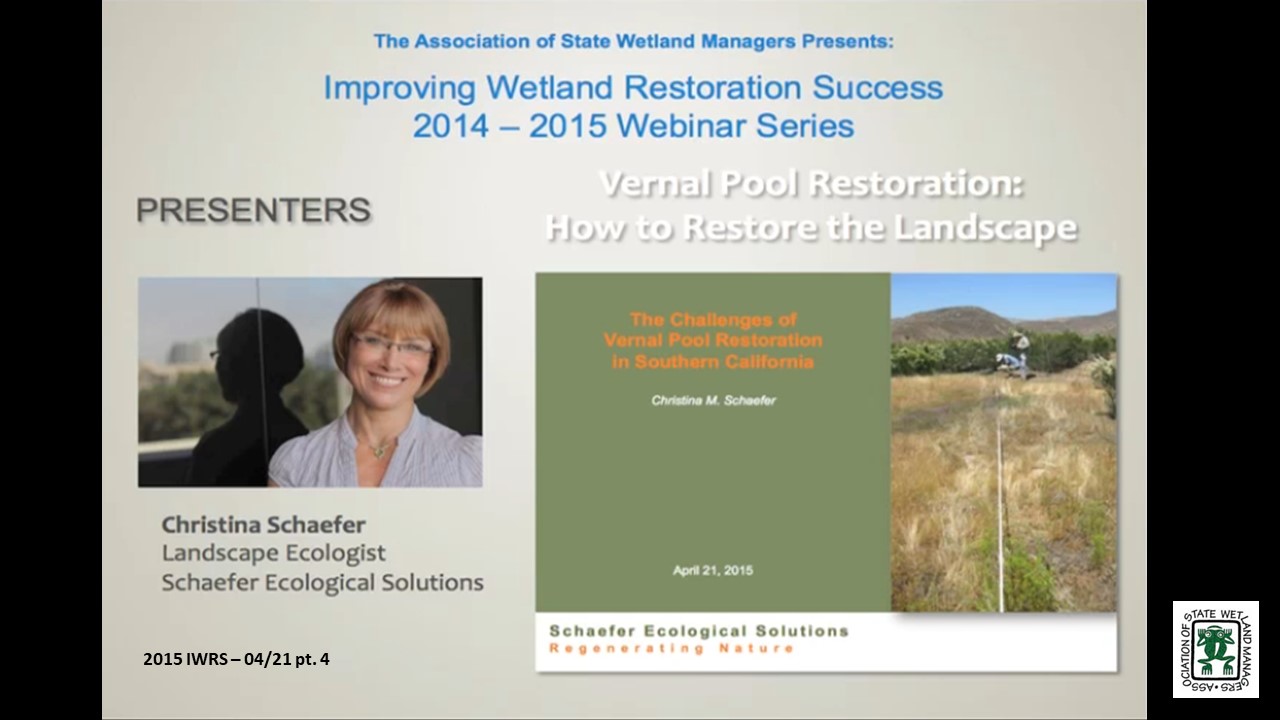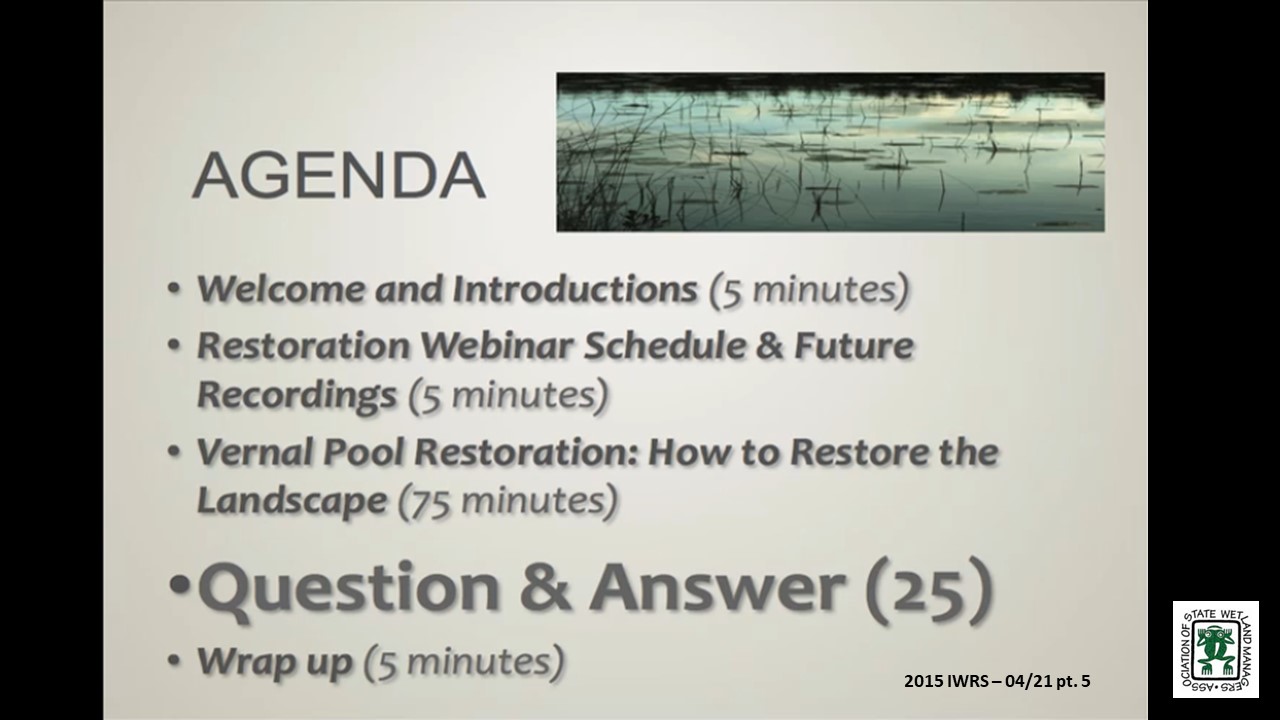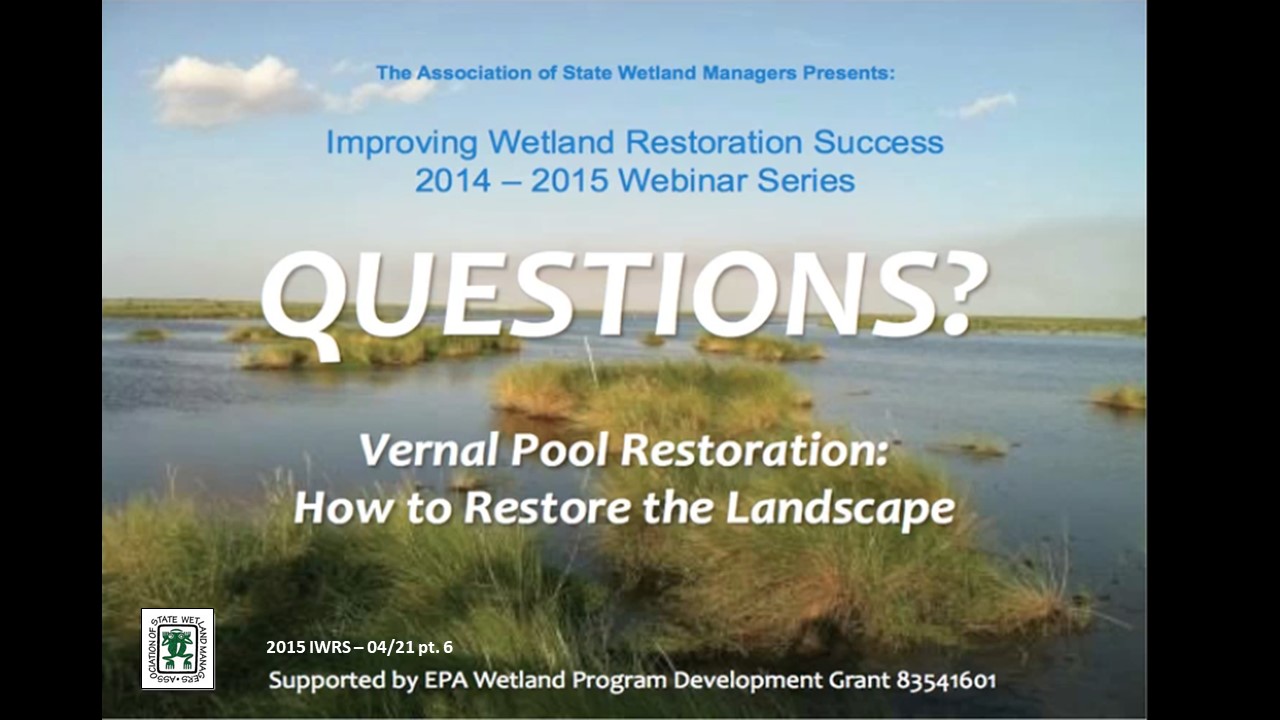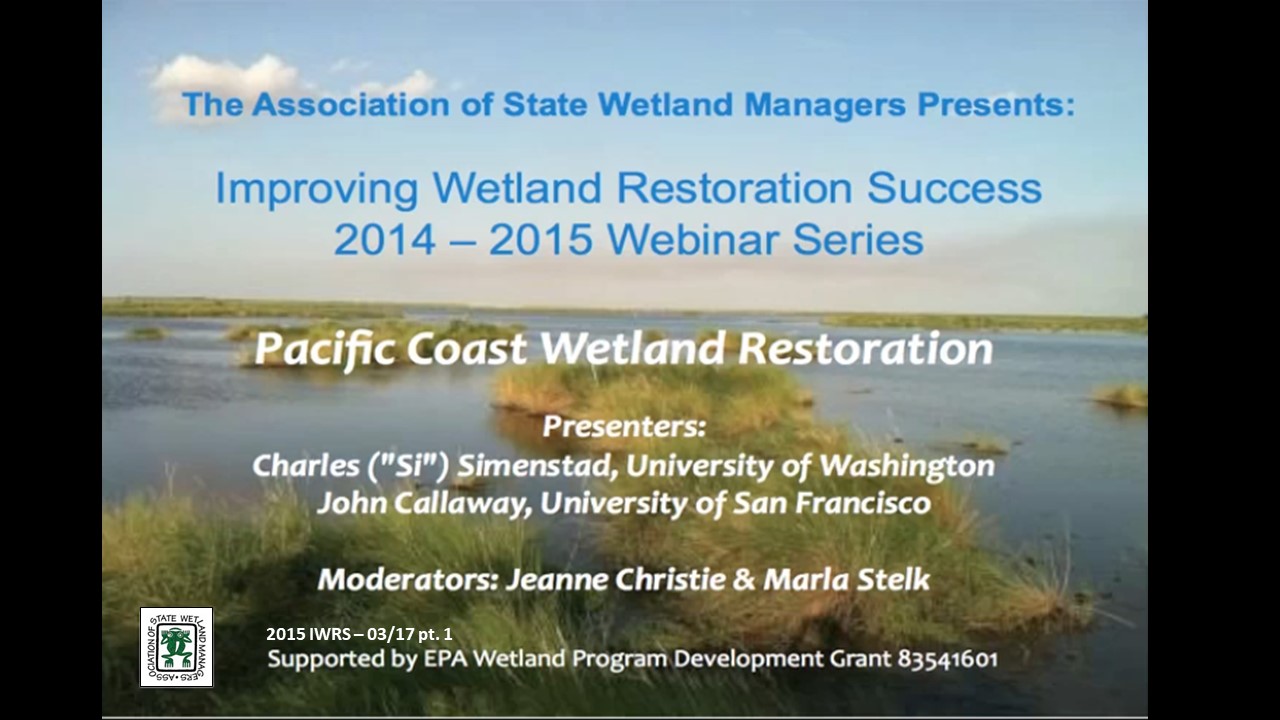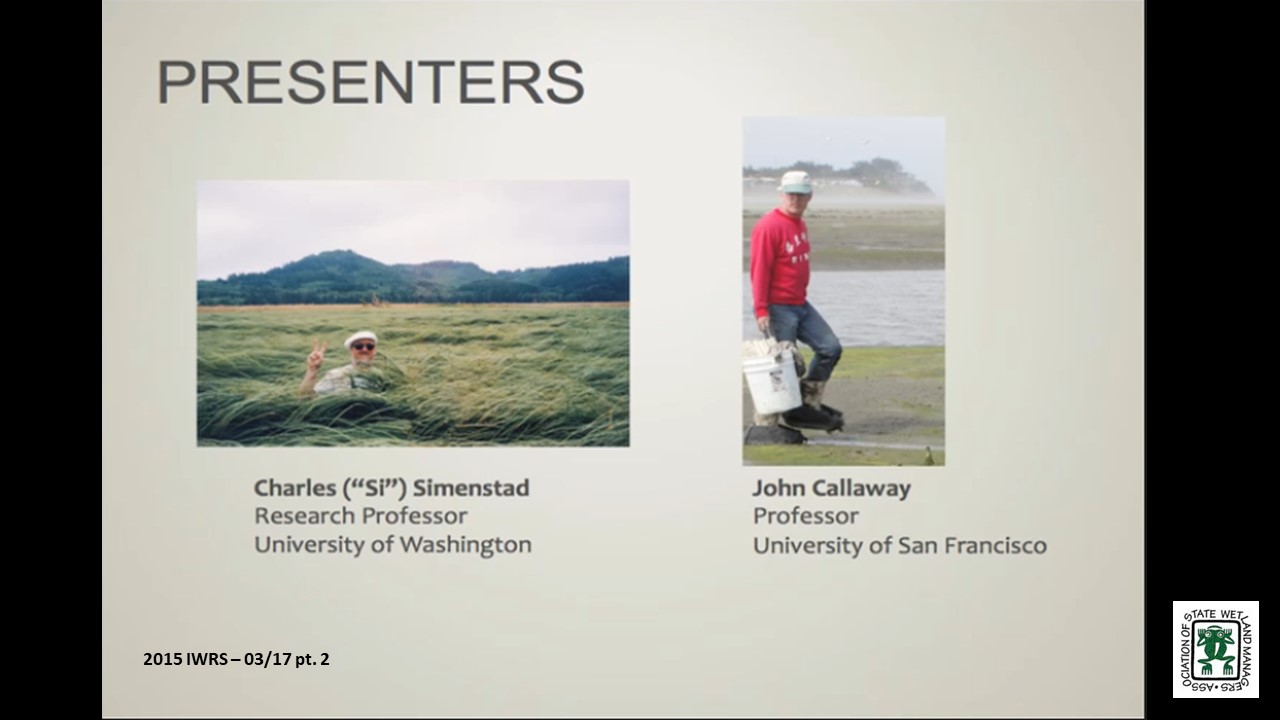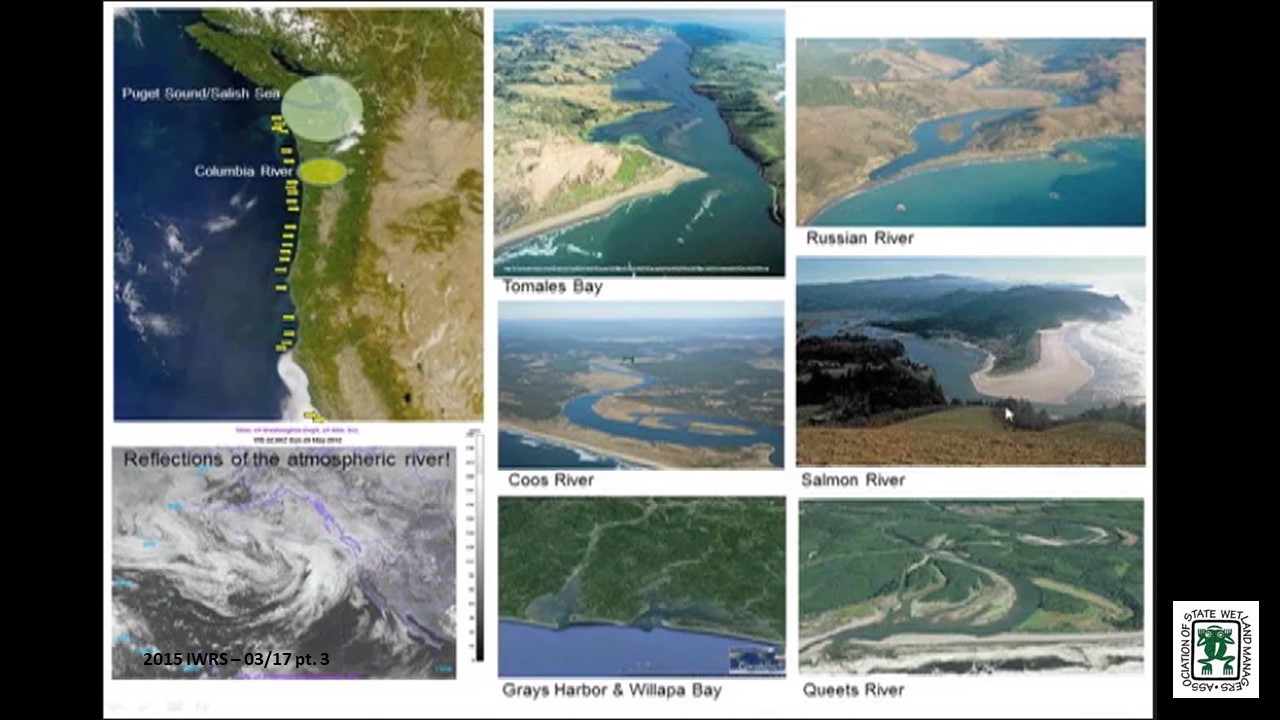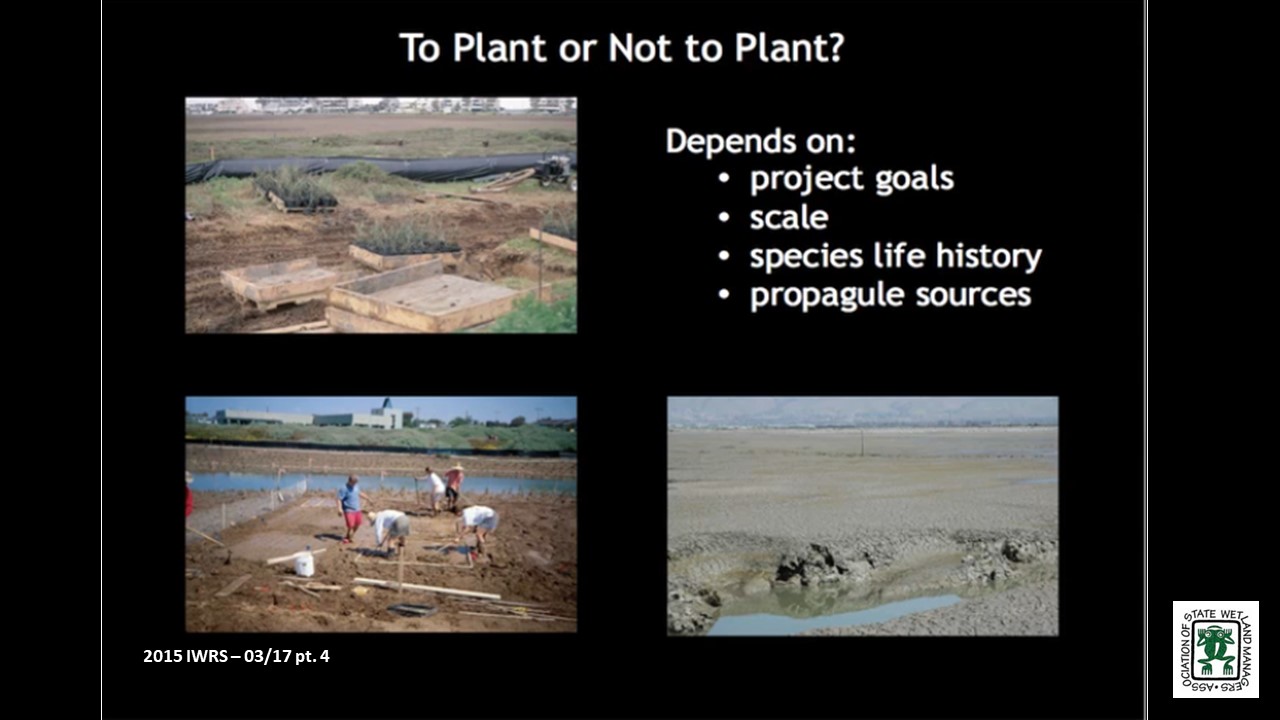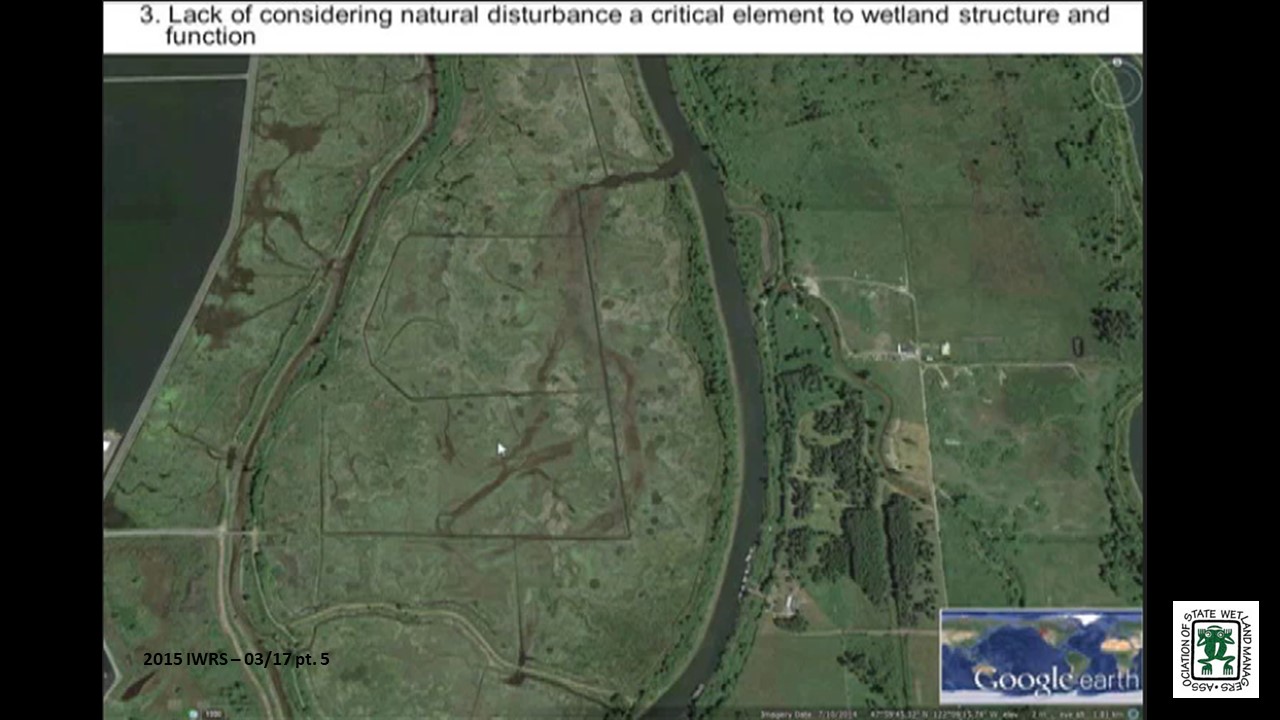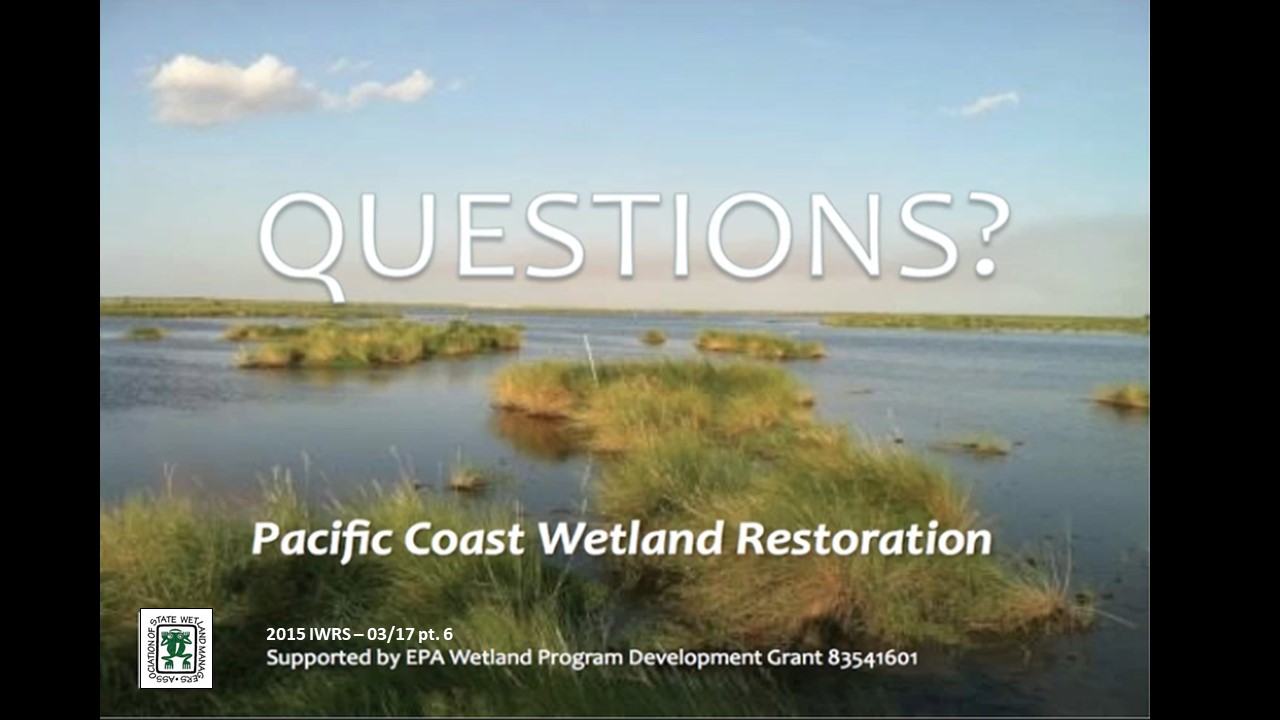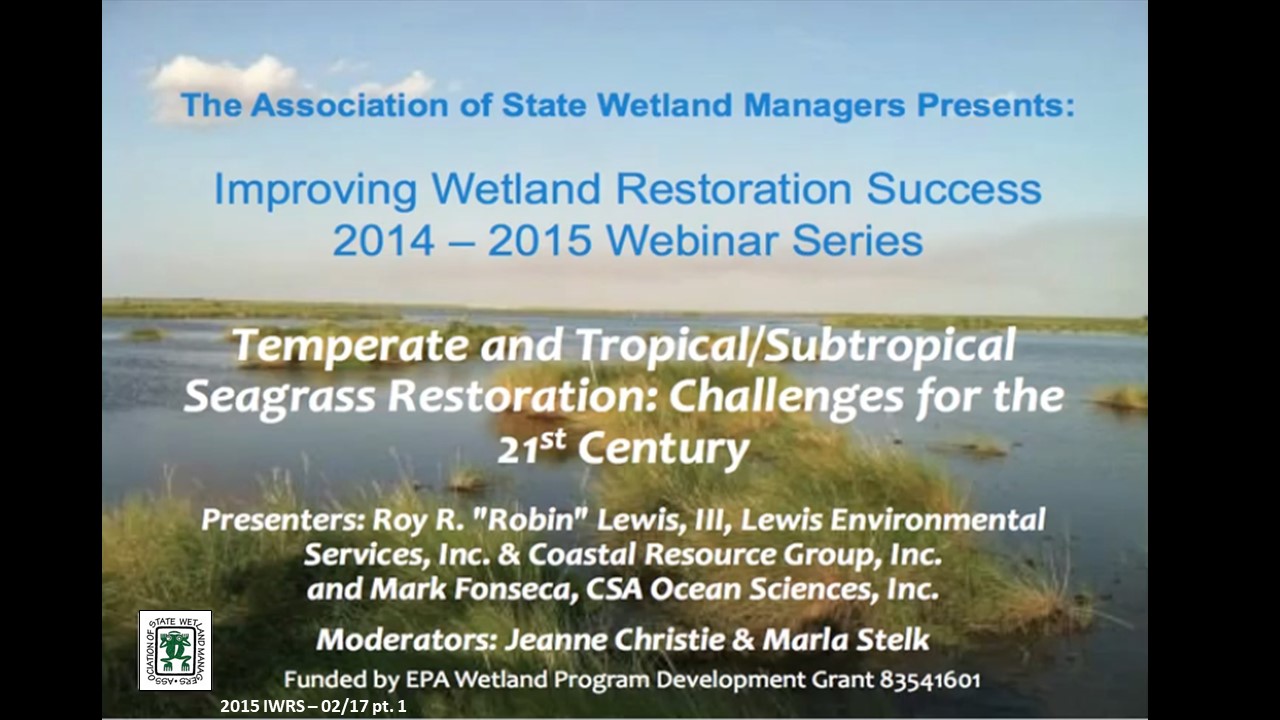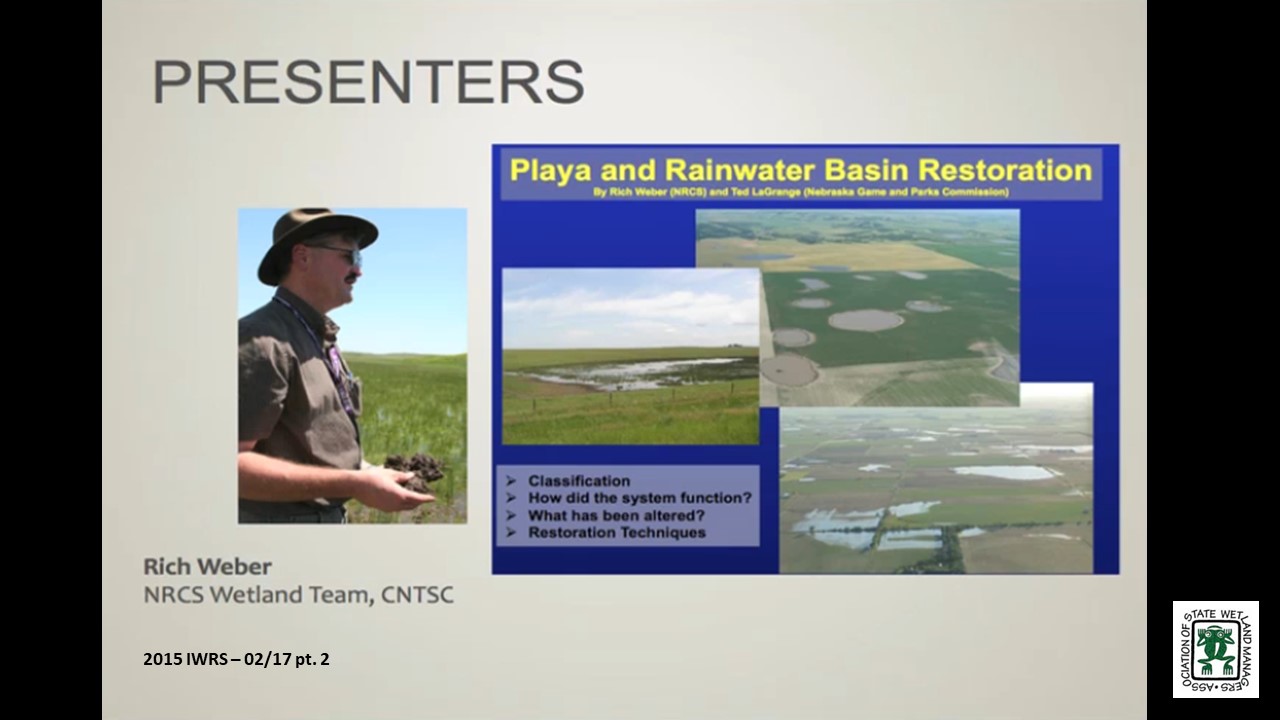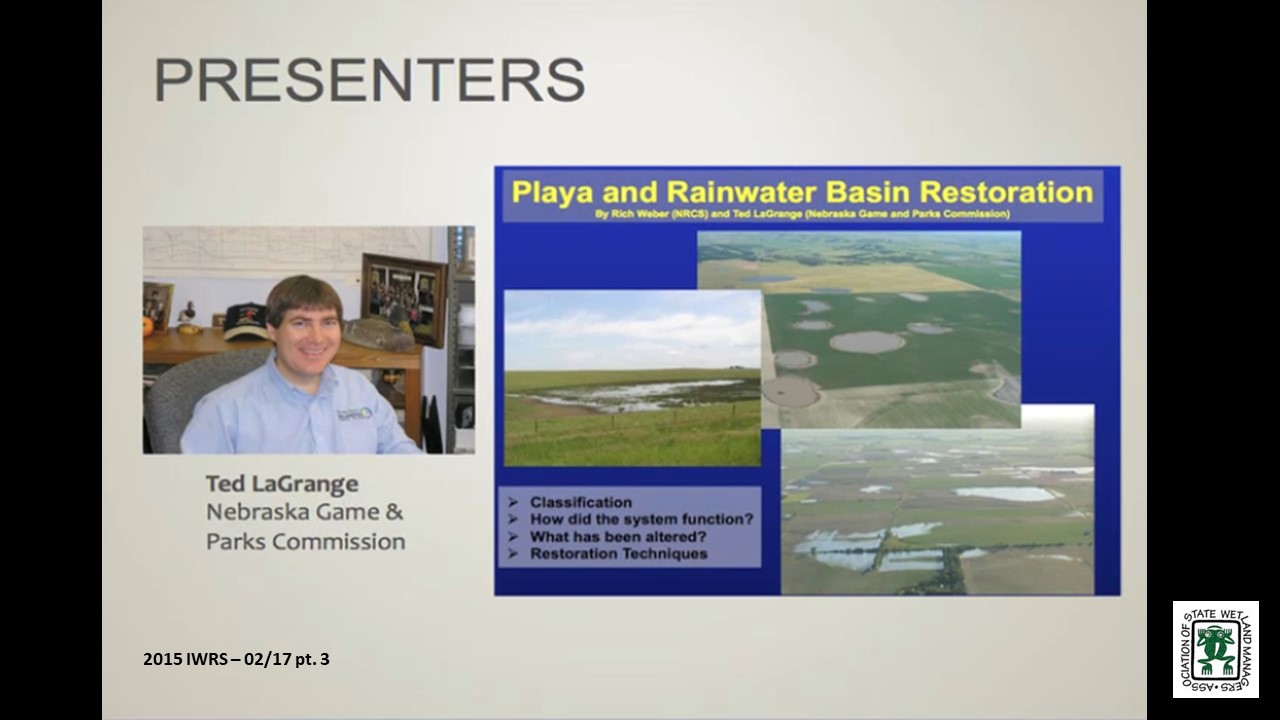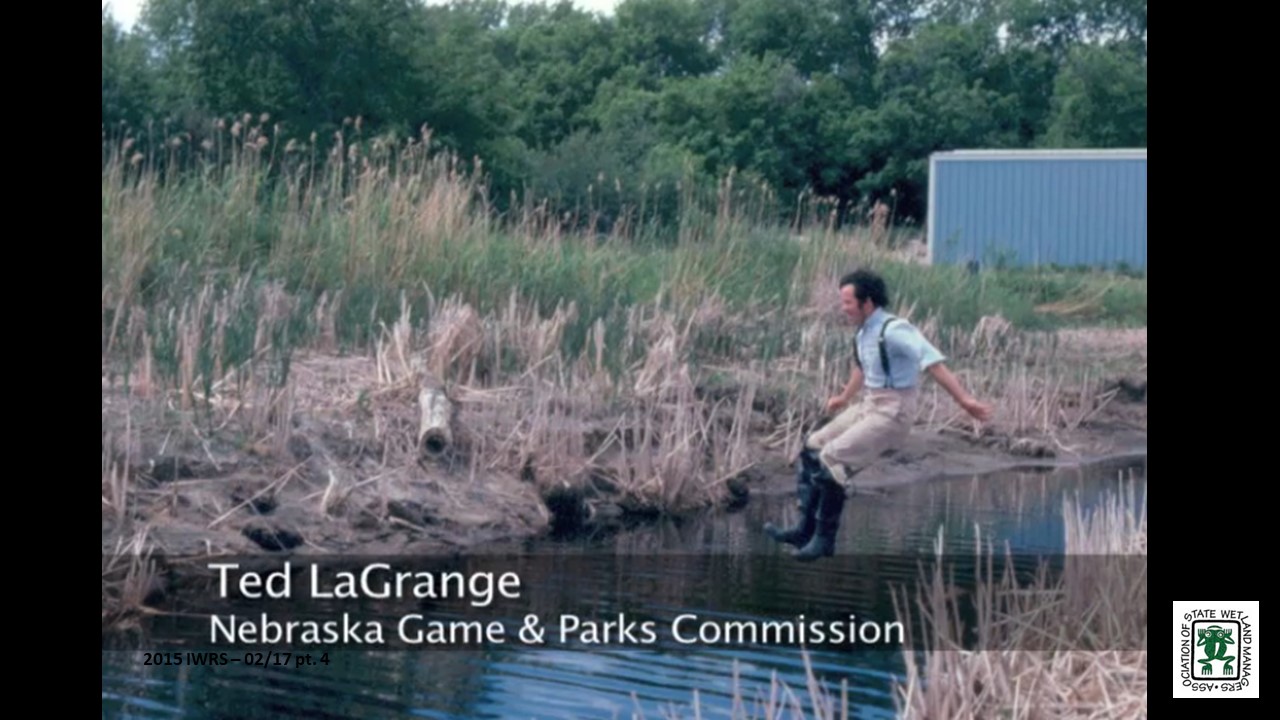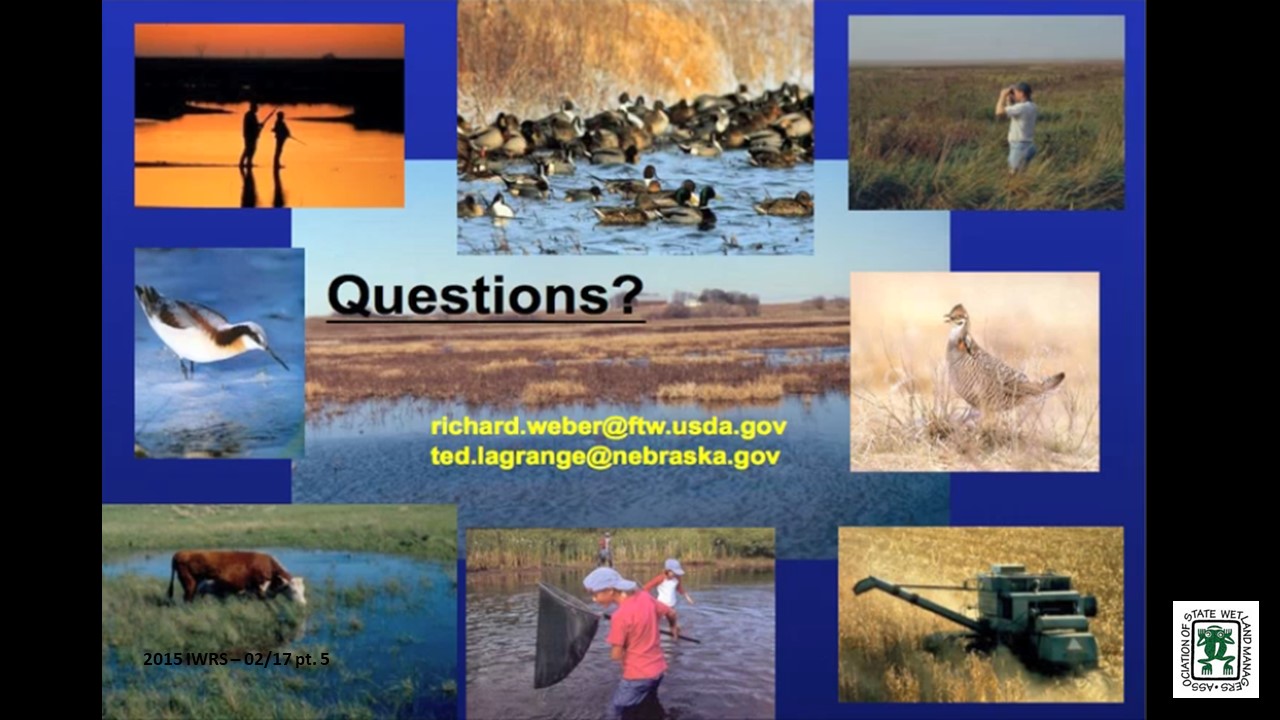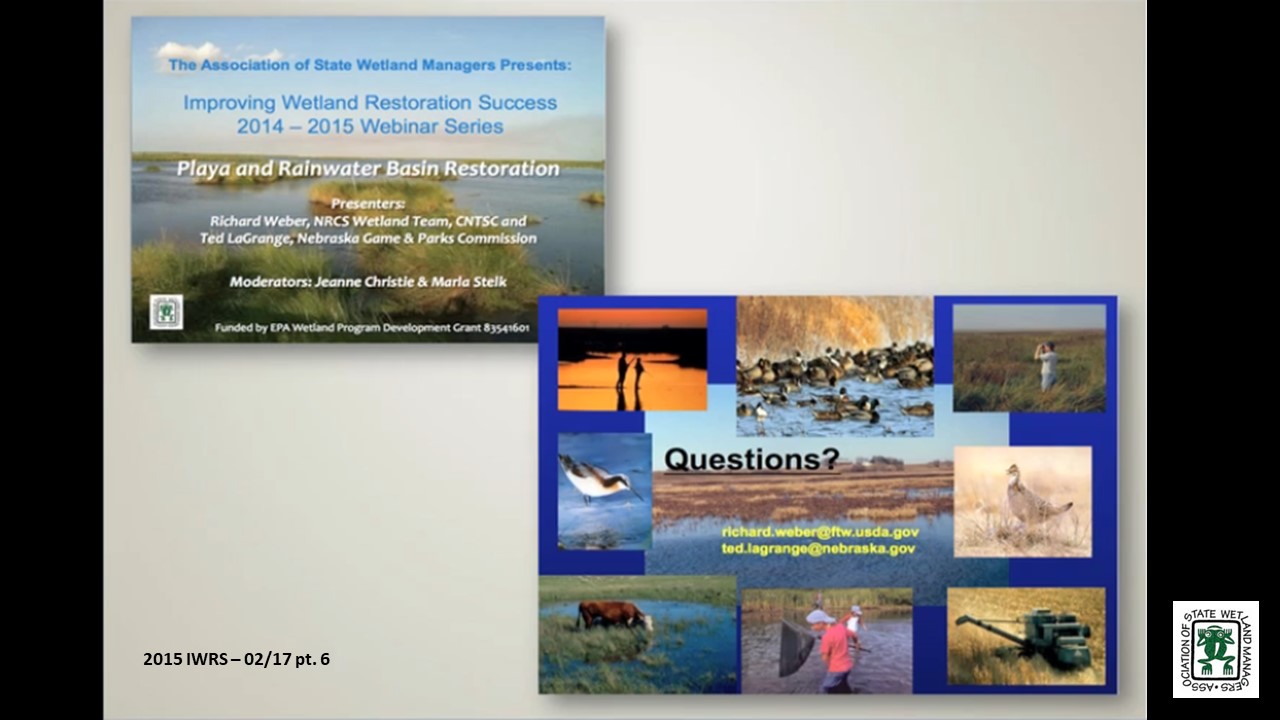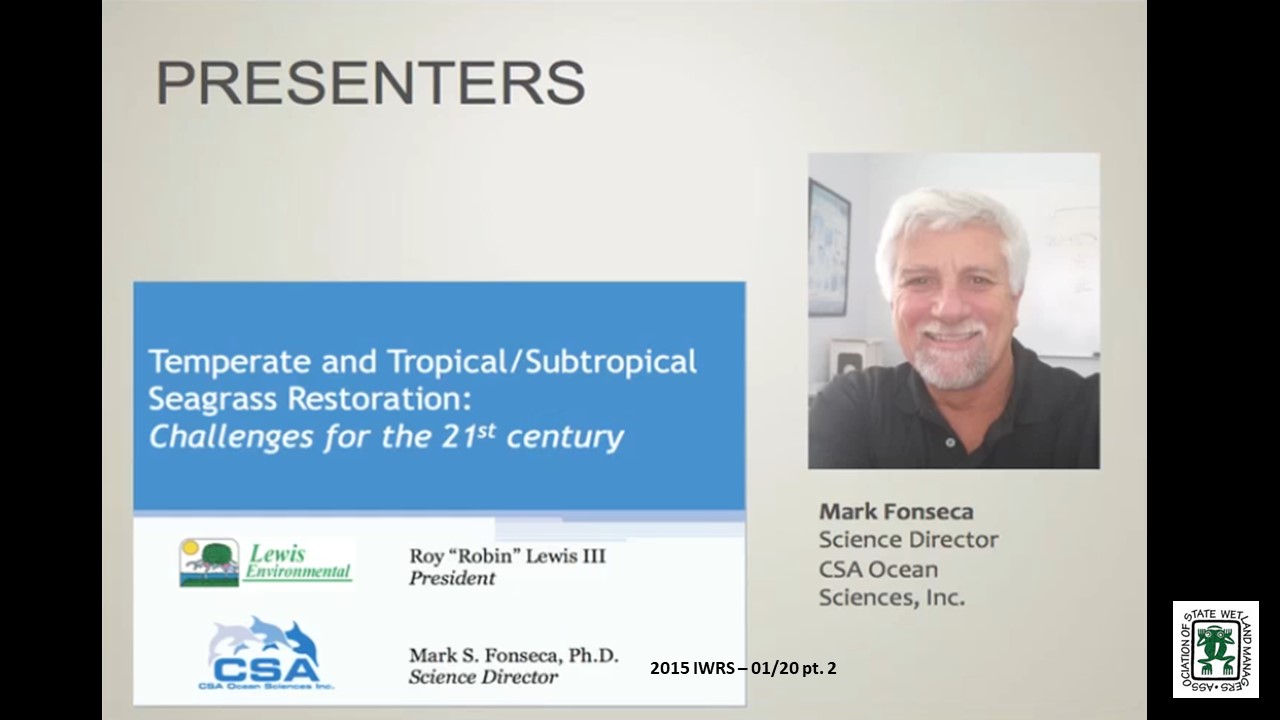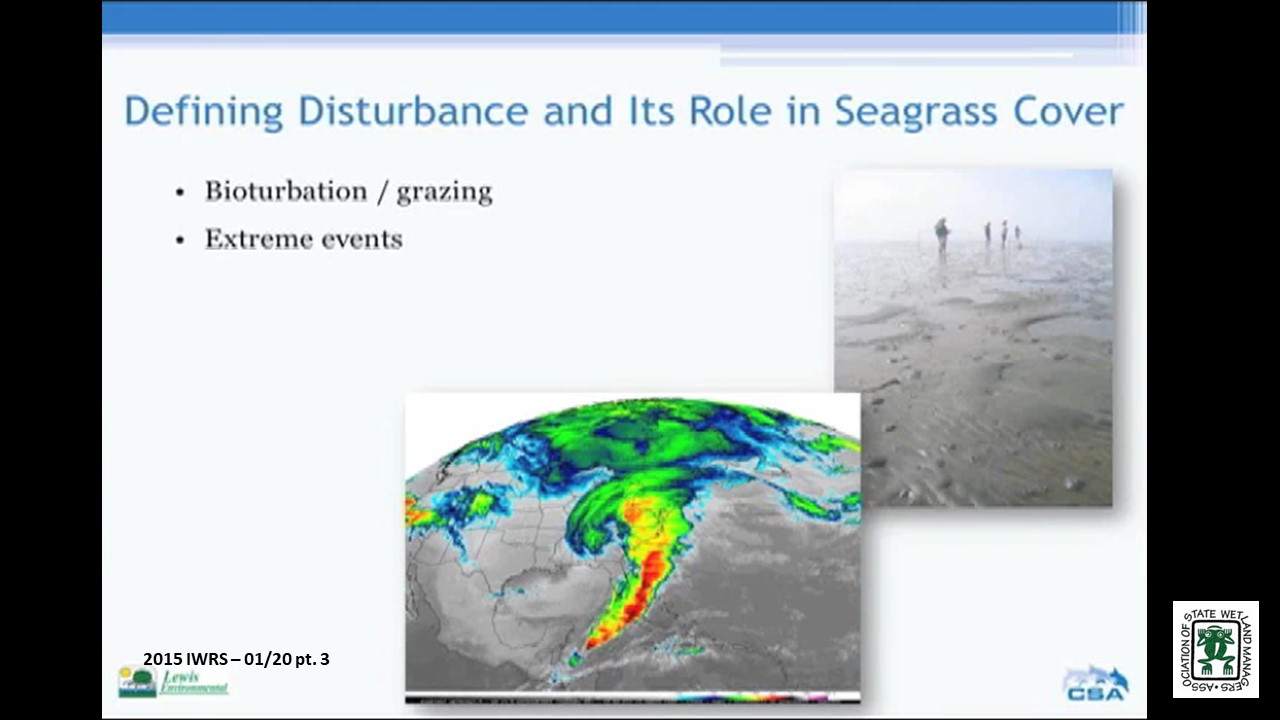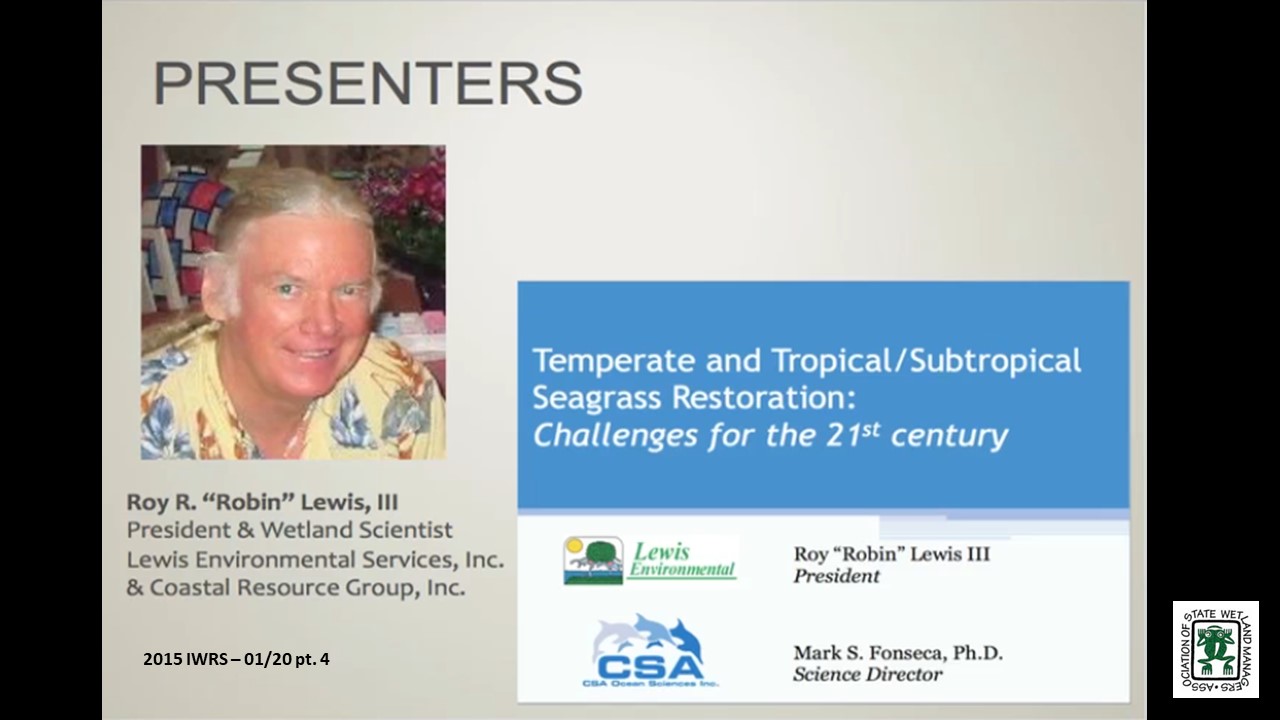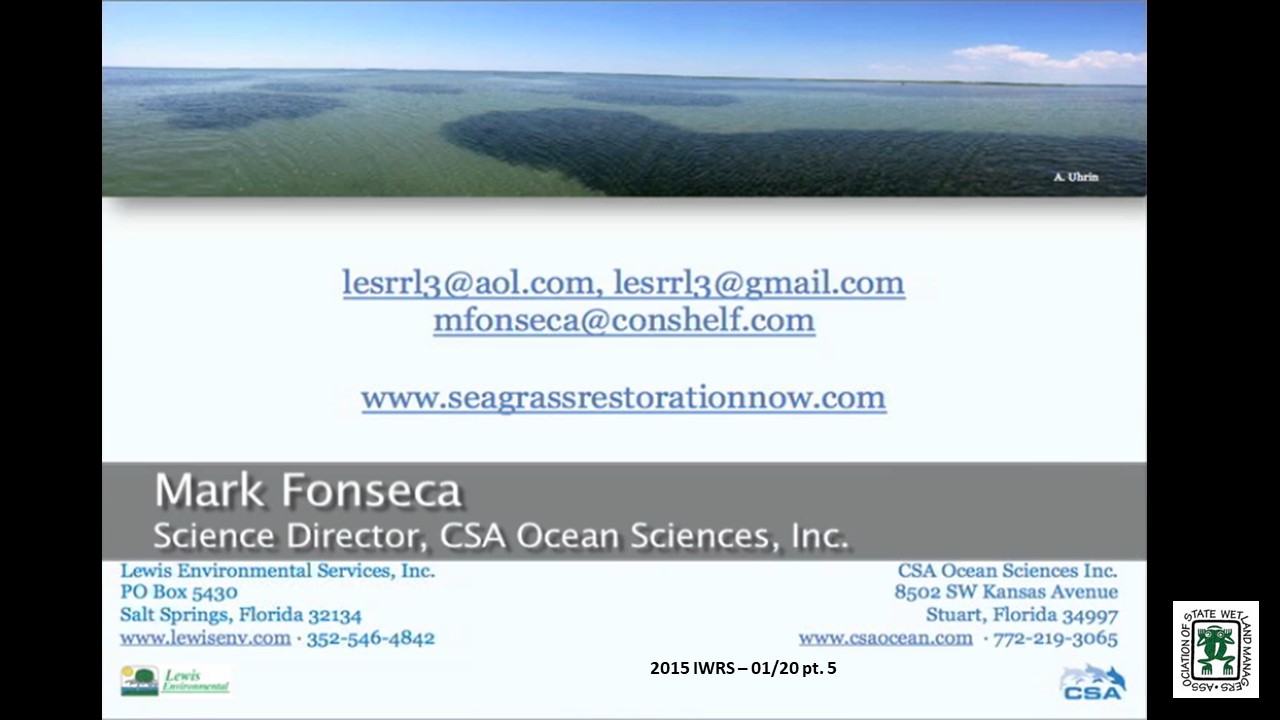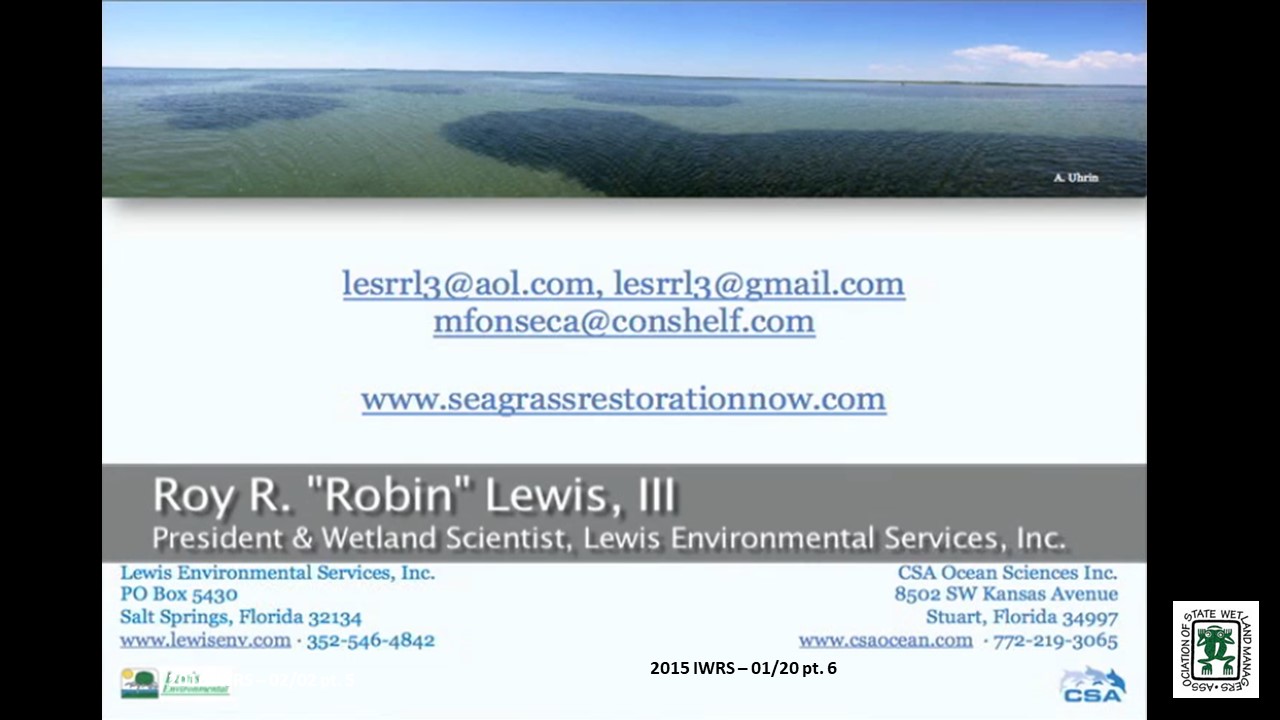Improving Wetland Restoration "Success": What We've Learned So Far
![]()
Held Tuesday, December 15, 2015 – 3:00 p.m. EST
PRESENTERS
- Jeanne Christie, Executive Director and Marla Stelk, Policy Analyst, Association of State Wetland Managers
- David Olson, U.S. Army Corps of Engineers
- Mary Kentula, U.S. Environmental Protection Agency’s, National Health and Environmental Effects Laboratory’s, Western Ecology Division
- Larry Urban, Montana Department of Transportation
PowerPoint presentation is available here.
ABSTRACT
This webinar looked back at the lessons learned about what the barriers and challenges for wetland restoration are that have been shared with all of you throughout this webinar series since it was first aired in September of 2014. After the initial presentation by Jeanne Christie and Marla Stelk at ASWM, joining the webinar was David Olson, USACE, Mary Kentula, EPA, and Larry Urban, Montana DOT who have been engaged in listening to the webinar series and have decades of experience in addressing the scientific and programmatic challenges posed by restorations of wetlands. They shared their perspectives on our findings, reflected on recent advances in wetland restoration including information shared during the restoration webinar series, and identify key actions to take to improve wetland restoration outcomes.
BIOS
Jeanne Christie, Executive Director, Association of State Wetland Managers
Marla Stelk, Policy Analyst, Association of State Wetland Managers
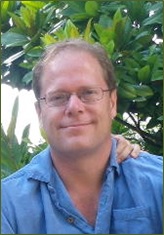
David Olson is a Regulatory Program Manager at the Headquarters office of the U.S. Army Corps of Engineers. He has worked for the Corps since 1991, beginning as a Regulatory Project Manager at the Baltimore District, evaluating permit applications for work in waters and wetlands. In 2002, he began working at his current position at Corps Headquarters. He spent several years working on the 2008 mitigation rule for wetland and stream mitigation. He also manages the Corps' nationwide permit program and is working on Endangered Species Act compliance and developing an approach for cumulative effects analysis.
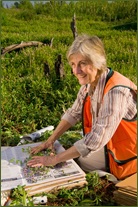 Dr. Mary E. Kentula is a Wetlands Ecologist with the U.S. Environmental Protection Agency’s (EPA) National Health and Environmental Effects Laboratory’s Western Ecology Division in Corvallis, Oregon. From 1992 through 1996 she served as the national program leader for the Agency’s Wetland Research Program and was responsible for directing and coordinating studies of freshwater wetlands across the Nation. Mary’s research within the Program focused on the use of restoration techniques in wetland management. Among Mary’s publications from that work is the book, Wetland Creation and Restoration: The Status of the Science (1990), which she co-edited with Dr. Jon Kusler. Mary’s current work supports EPA’s National Aquatic Resource Surveys through the development of approaches to monitor and report on the ecological condition of wetlands. In 2007 the Society of Wetland Scientists recognized Dr. Kentula with the Merit Award for her work in assessing wetlands at the watershed scale. This was followed by the successful completion of the field work for the first National Wetland Condition Assessment (NWCA) in 2011. Mary’s research team led the production of the field operations manual used in the assessment, played a major role in data analysis, and wrote the technical report which details the science behind the results of the 2011 NWCA. Her team is presently looking forward to the second NWCA in summer 2016.
Dr. Mary E. Kentula is a Wetlands Ecologist with the U.S. Environmental Protection Agency’s (EPA) National Health and Environmental Effects Laboratory’s Western Ecology Division in Corvallis, Oregon. From 1992 through 1996 she served as the national program leader for the Agency’s Wetland Research Program and was responsible for directing and coordinating studies of freshwater wetlands across the Nation. Mary’s research within the Program focused on the use of restoration techniques in wetland management. Among Mary’s publications from that work is the book, Wetland Creation and Restoration: The Status of the Science (1990), which she co-edited with Dr. Jon Kusler. Mary’s current work supports EPA’s National Aquatic Resource Surveys through the development of approaches to monitor and report on the ecological condition of wetlands. In 2007 the Society of Wetland Scientists recognized Dr. Kentula with the Merit Award for her work in assessing wetlands at the watershed scale. This was followed by the successful completion of the field work for the first National Wetland Condition Assessment (NWCA) in 2011. Mary’s research team led the production of the field operations manual used in the assessment, played a major role in data analysis, and wrote the technical report which details the science behind the results of the 2011 NWCA. Her team is presently looking forward to the second NWCA in summer 2016.
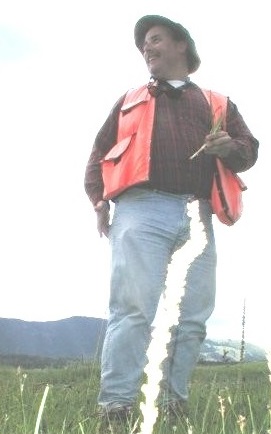 Lawrence J. “Larry” Urban, is the wetland mitigation specialist for the Montana Department of Transportation with state-wide responsibilities based out of Helena, Montana. He has over 30 years of experience in wetland delineations, functional assessments, monitoring and mitigation site development for both the New Jersey and Montana Department of Transportations. He has been involved in the development of a comprehensive aquatic resource mitigation program to meet wetland and stream mitigation needs for transportation projects throughout the state of Montana that has created over 55 mitigation areas ranging in size from ½ to 300 acres in size. He developed an annual monitoring program for the purposes of managing aquatic resource mitigation sites on both private and state lands to comply with federal, state and Tribal permitting requirements. Assisted in the funding, development and continued oversight of the Montana Department of Transportation’s Montana Wetland Assessment Method (MWAM) originally developed in 1989. He has also presented at a number of National and regional wetland mitigation conferences, and participates in annual continuing education courses as an instructor in wetland regulations, mitigation and wetland assessments in the state of Montana.
Lawrence J. “Larry” Urban, is the wetland mitigation specialist for the Montana Department of Transportation with state-wide responsibilities based out of Helena, Montana. He has over 30 years of experience in wetland delineations, functional assessments, monitoring and mitigation site development for both the New Jersey and Montana Department of Transportations. He has been involved in the development of a comprehensive aquatic resource mitigation program to meet wetland and stream mitigation needs for transportation projects throughout the state of Montana that has created over 55 mitigation areas ranging in size from ½ to 300 acres in size. He developed an annual monitoring program for the purposes of managing aquatic resource mitigation sites on both private and state lands to comply with federal, state and Tribal permitting requirements. Assisted in the funding, development and continued oversight of the Montana Department of Transportation’s Montana Wetland Assessment Method (MWAM) originally developed in 1989. He has also presented at a number of National and regional wetland mitigation conferences, and participates in annual continuing education courses as an instructor in wetland regulations, mitigation and wetland assessments in the state of Montana.
![]()
Novel Ecosystems and Restoration
Held Thursday, November 19, 2015 – 3:00 p.m. EST
Introduction – Marla Stelk, Policy Analyst, Association of State Wetland Managers and Jeanne Christie, Association of State Wetland Managers
PRESENTERS
- Joy Zedler, Professor of Botany and Aldo Leopold Chair of Restoration Ecology, University of Wisconsin-Madison
- Marilyn Jordan, Former Senior Conservation Scientist, The Nature Conservancy on Long Island, NY
PowerPoint presentation: Joy Zedler - Marilyn Jordan
ABSTRACTS
Joy Zedler, Professor of Botany and Aldo Leopold Chair of Restoration Ecology, University of Wisconsin-Madison
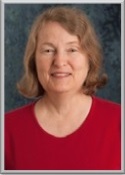 Novelty is not new; it’s the norm. The earliest restorationists worked in novel sites to achieve imprecise targets. In 1934, Aldo Leopold dedicated an “arboretum” for restoration of pre-settlement plant communities. Efforts to convert cultivated fields and pastures proceeded opportunistically and gave birth to tallgrass prairie restoration. The claim that early practitioners insisted on achieving some “original” condition is a popular myth that leads some to say we need novel targets and new terms, like “intervention.” Critics caution that the word “restoration” is key to public support and funding. Saying “Hey, let’s go intervene…” won’t likely energize volunteers, while “Let’s restore a prairie” does so in schoolyards and fields across Wisconsin. If we acknowledge historical disturbances, conduct experiments that compare restoration methods, and proceed adaptively, we will gradually improve our ability to restore what we can, where we can, and in the most efficient way. Let’s make adaptive restoration the new norm.
Novelty is not new; it’s the norm. The earliest restorationists worked in novel sites to achieve imprecise targets. In 1934, Aldo Leopold dedicated an “arboretum” for restoration of pre-settlement plant communities. Efforts to convert cultivated fields and pastures proceeded opportunistically and gave birth to tallgrass prairie restoration. The claim that early practitioners insisted on achieving some “original” condition is a popular myth that leads some to say we need novel targets and new terms, like “intervention.” Critics caution that the word “restoration” is key to public support and funding. Saying “Hey, let’s go intervene…” won’t likely energize volunteers, while “Let’s restore a prairie” does so in schoolyards and fields across Wisconsin. If we acknowledge historical disturbances, conduct experiments that compare restoration methods, and proceed adaptively, we will gradually improve our ability to restore what we can, where we can, and in the most efficient way. Let’s make adaptive restoration the new norm.
Marilyn Jordan, Former Senior Conservation Scientist, The Nature Conservancy on Long Island, NY
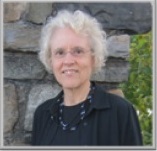 Novel ecosystems are new, historically unprecedented combinations of species created primarily by direct and indirect human actions, and now occupy ~40% of the terrestrial ice-free globe. Invasion by non-native plant species is typical in many novel ecosystems, which usually results in decreased native plant species diversity and biomass. Native insects, which depend on native plants, also decrease which in turn leads to simplified food webs and losses of higher trophic level species. Lost biodiversity reduces ecosystem resilience and degrades ecosystem function. The idea that despite their deficiencies novel ecosystems have value and should be considered part of nature is highly controversial and is seen by some (inappropriately in my view) as a “license to trash nature.” I think that the new science of novel ecosystems management offers a thoughtful way forward to manage for conservation goals when restoration to a historic condition is no longer possible.
Novel ecosystems are new, historically unprecedented combinations of species created primarily by direct and indirect human actions, and now occupy ~40% of the terrestrial ice-free globe. Invasion by non-native plant species is typical in many novel ecosystems, which usually results in decreased native plant species diversity and biomass. Native insects, which depend on native plants, also decrease which in turn leads to simplified food webs and losses of higher trophic level species. Lost biodiversity reduces ecosystem resilience and degrades ecosystem function. The idea that despite their deficiencies novel ecosystems have value and should be considered part of nature is highly controversial and is seen by some (inappropriately in my view) as a “license to trash nature.” I think that the new science of novel ecosystems management offers a thoughtful way forward to manage for conservation goals when restoration to a historic condition is no longer possible.
PRESENTERS BIOS
Joy Zedler is Professor of Botany at the University of Wisconsin-Madison and the Aldo Leopold Professor of Restoration Ecology and Research Director at the Arboretum. Her research and writings concern wetlands, restoration, and conservation of biodiversity and ecosystem services; she promotes Adaptive Restoration, mentors students, and helps edit the journal, Restoration Ecology. She advises many organizations on environmental issues and restoration projects. She is a Fellow of the Society of Wetland Scientists and a Fellow of the Ecological Society of America, in recognition of her research and service.
Dr. Marilyn Jordan retired in 2014 as a Senior Conservation Scientist for The Nature Conservancy on Long Island, NY after working for TNC since 1992. She grew up in Queens, NYC and got a BA in biology from Queens College (1966) and a Ph.D. in plant ecology from Rutgers University (1971). Her career experience includes ecological monitoring, invasive plant science, nutrient cycling, soil and water pollution, microbial ecology, atmospheric deposition, ecological impacts of deer browse in forests, fire as a restoration tool and novel ecosystems.
![]()
Wetland Restoration in Urban and Highly Disturbed Landscapes
Held Tuesday, October 13, 2015 – 3:00 p.m. ET
Introduction – Marla Stelk, Policy Analyst, Association of State Wetland Managers and Jeanne Christie, Association of State Wetland Managers
PRESENTERS
- Tom Ries, President and Founder of Ecosphere Restoration Institute
- Steven I. Apfelbaum, Principal Ecologist, Chairman, Applied Ecological Services, Inc.
- Alexander J. Felson, PhD RLA, Assistant Professor, Yale University School of Architecture & School of Forestry and Environmental Studies
PowerPoint presentations: Tom Ries - Steven I. Apfelbaum - Alexander J. Felson
ABSTRACT
Urban environments and highly disturbed landscapes create unique challenges and opportunities for wetland restoration. In this webinar, we will hear from three experts in the field of ecological restoration. Our presenters will discuss landscape hydrology changes resulting from urbanization and agricultural practices, current and recent case studies and how good design can enhance social and environmental outcomes.
PRESENTERS BIOS
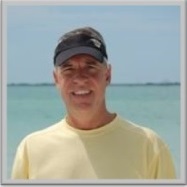 Thomas Ries has a biology degree from USF with a minor in Geology; he has worked in both the public and private sectors. He has extensive experience with estuarine ecosystems and has implemented over 90+ habitat restoration projects in this region; many of these have won awards of environmental excellence. In 2002, he founded the non-profit organization, Ecosphere Restoration Institute, to implement Public/Private/Partnerships to help preserve and restore coastal ecosystems. In 2013, he was presented with the National Habitat Restoration and Conservation Award by the Environmental Law Institute. The restoration of Ulele Springs was funded and implemented under his direction.
Thomas Ries has a biology degree from USF with a minor in Geology; he has worked in both the public and private sectors. He has extensive experience with estuarine ecosystems and has implemented over 90+ habitat restoration projects in this region; many of these have won awards of environmental excellence. In 2002, he founded the non-profit organization, Ecosphere Restoration Institute, to implement Public/Private/Partnerships to help preserve and restore coastal ecosystems. In 2013, he was presented with the National Habitat Restoration and Conservation Award by the Environmental Law Institute. The restoration of Ulele Springs was funded and implemented under his direction.
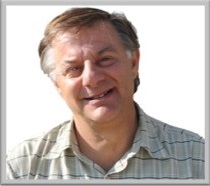 Steven I. Apfelbaum, M.S. is Senior Ecologist and Chairman of the Board/Founder, Applied Ecological Services, Inc. Steve Apfelbaum has been a full-time research and consulting ecologist with AES since 1978. Apfelbaum earned his MS Degree in Ecological and Biological Sciences at the University of Illinois, Urbana-Champaign and is trained as an animal and plant ecologist. He has been a scientist in hundreds of field ecological projects and data analysis projects. He has authored or co-authored hundreds of technical studies, reports, ecological program plans, restoration plans, and monitoring and compliance
Steven I. Apfelbaum, M.S. is Senior Ecologist and Chairman of the Board/Founder, Applied Ecological Services, Inc. Steve Apfelbaum has been a full-time research and consulting ecologist with AES since 1978. Apfelbaum earned his MS Degree in Ecological and Biological Sciences at the University of Illinois, Urbana-Champaign and is trained as an animal and plant ecologist. He has been a scientist in hundreds of field ecological projects and data analysis projects. He has authored or co-authored hundreds of technical studies, reports, ecological program plans, restoration plans, and monitoring and compliance 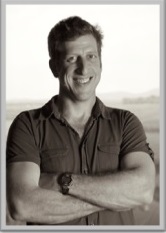 reports for research projects and for regulatory program reporting. Apfelbaum teaches a course at the Harvard Graduate School of Design on the future of coastal systems on earth and holds adjunct professorships and lectureships at several other universities.
reports for research projects and for regulatory program reporting. Apfelbaum teaches a course at the Harvard Graduate School of Design on the future of coastal systems on earth and holds adjunct professorships and lectureships at several other universities.
Dr. Felson is an assistant Professor at Yale University, an urban ecologist and a landscape architect. He directs the joint degree program between the School of Architecture and Forestry at Yale and founded the Urban Ecology and Design Lab. Felson focuses on ecological urban design through green infrastructure, coastal adaptation and constructed ecosystems. He led Yale’s efforts for Rebuild by Design and led the vision development for Connecticut’s phase one HUD’s NDRC. Felson is a leader in the ESA’s Earth Stewardship Initiative and has developed ecologically based urban design projects along the American River in Sacramento and in Baltimore.
![]()
Held Tuesday, September 8, 2015 – 3:00 p.m. ET
Introduction – Marla Stelk, Policy Analyst, Association of State Wetland Managers and Jeanne Christie, Association of State Wetland Managers
PRESENTERS
- Will Harman, Owner, Stream Mechanics
- Matt Daniels, Principal Engineer/Project Manager, River Design Group, Inc.
PowerPoint presentation is available here.
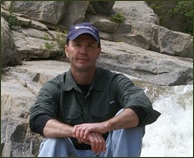 ABSTRACTS
ABSTRACTS
Determining Functional Lift of Stream/Wetland Restoration Projects
Will Harman, PG, Stream Mechanics
As compensatory stream mitigation increases, a recognized need for debit/credit determination methods for stream/wetland combinations is also increasing. Most mitigation guidelines account for wetland and stream debits/credits separately. However, Interagency Review Teams and practitioners realize that there is value in restoring valley corridors that support riverine and wetland functions together. This presentation will illustrate how the Stream Functions Pyramid Framework can be used as one tool for describing functional lift of stream/wetland complexes. Case studies will be provided to show metrics and performance standards for showing functional lift, along with lessons learned from implementing these types of projects.
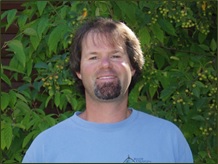 Use of an Ecosystem-based Approach for Stream and Wetland Restoration
Use of an Ecosystem-based Approach for Stream and Wetland Restoration
Matt Daniels, P.E., River Design Group, Inc.
The need for stream and wetland restoration projects in the western U.S., in particular the Northern Rockies and Columbia River Basin, is often driven by different mitigation objectives than those in the eastern U.S. The effects of large hydropower dams, extensive mining in headwater streams and grazing of riparian floodplains have altered migration corridors and aquatic habitat used by native fish populations, thus contributing to the listing of several threatened and endangered fish species. Extensive research has been undertaken to improve our understanding of these species life history needs and the ecosystems in which they exist. This presentation will describe some of the restoration challenges that are unique to the western U.S in the context of addressing stream and wetland mitigation. Example projects will be used to illustrate the use of an ecosystem-based restoration approach and to highlight some of the lessons learned.
PRESENTERS BIOS
Mr. Harman is the founder of Stream Mechanics and Ecosystem Planning and Restoration. In the course of his 24-year career, he has participated in hundreds of stream restoration projects, representing a wide variety of settings and techniques. He has authored or co-authored numerous peer-reviewed journal articles and proceeding papers and developed the Stream Functions Pyramid. Mr. Harman teaches stream restoration workshops to federal, state, and local agencies, universities, and private engineering firms. Prior to working in the private sector, Mr. Harman was on the faculty at NC State University, where he co-founded and led the NC Stream Restoration Program. Mr. Harman’s combination of academic and private-sector experience provide a unique skill set for teaching stream restoration principles and applications.
Mr. Harman has a Master’s degree in Geography from the University of North Carolina at Charlotte and Bachelor’s degree in Geography from Appalachian State University. He is a licensed Geologist in North Carolina.
Matt Daniels, P.E. is a principal and founding shareholder of River Design Group, Inc. In over 20 years of experience as a civil engineer, he has participated in the planning, design and implementation of over 70 water resources projects in Montana, Idaho, Washington and Oregon. His expertise includes project planning, technical support and construction oversight for large-scale, ecosystem restoration projects. Matt frequently speaks at design symposiums and conferences on the subjects of river restoration, fish passage and project case studies. He is a licensed professional engineer in seven western states. Outside of work, Matt enjoys mountain biking, fishing, skiing, and playing hockey.
![]()
August – No Webinar
![]()
Held Tuesday, July 14, 2015 – 3:00 pm ET
Introduction – Marla Stelk, Policy Analyst, Association of State Wetland Managers and Jeanne Christie, Association of State Wetland Managers
PRESENTERS
- Norman Famous & Marcia Spencer-Famous, Spencer-Famous Environmental Consultants
- Richard Weber, NRCS Wetland Team
- Larry Urban, Montana Department of Transportation
PowerPoint presentation is available here.
ABSTRACT
This webinar will focus on freshwater wetlands which feature organic soils, including peats, mucky peats, and mucks. These wetlands do not have a consistent set of hydrologic inputs and common landscape positions. However, they can be functionally separated into distinct categories based on their watershed position, and their dominant water source. The webinar will present a discussion of restoration of damaged organic soil wetlands, using three case studies from Maine, Michigan and Montana as examples.
In a general sense, peatlands and those with other organic soils are a type of freshwater wetland with a thick organic soil layer, and are referred to by many names, for example: bogs, fens, mires, pocosins, or prairie potholes. There are many subtypes: domed bog, blanket bog, coastal plateau bog, aapa mire, circumneutral fen, etc. What they all have in common is a thick layer of organic soil and a dynamic development process by which the soil accumulates over time. While a salt marsh is technically a peatland, we are not including tidal systems in today’s talk.
In today’s presentation, we are focusing on ombrotrophic bogs and the more nutrient-rich fens, both of which have historically been drained and developed for peat mining, agriculture, and other kinds of development, resulting in large highly disturbed areas that are difficult to restore to the pre-disturbance condition. We will include three case studies with very different disturbance histories: A large, mined raised bog; a small fen imbedded in a forested wetland disturbed by development; and a intermountain valley bottom fen drained for agriculture. We will summarize the steps necessary to guide these ecosystems towards recovery, and discuss critical considerations, pitfalls, and the necessity of adaptive management.
PRESENTERS BIOS
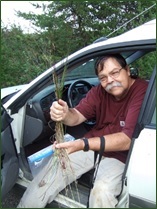 Norman Famous has worked on peatlands since 1978, conducting environmental surveys and assessments, writing restoration plans and creating and restoring small peatlands. As part of a three-person team, Norm evaluated the natural recolonization and regeneration of 39 mined bogs in NE North America between 1987 and 1993 by sampling vegetation and evaluating environmental factors that influence natural restoration processes. The team prepared restoration plans for mined bogs in Maine (for industry); Canada (Province of New Brunswick), and Michigan (U.S, DOJ and EPA). In 1999, Norm was one of several expert witnesses in a U.S. DOJ/Environmental Defense Section and EPA enforcement case). Between 1993 and 1997 Norm conducted a breeding bird monitoring program for 23 mined and unmined peatlands in Maine and New Brunswick, Canada.
Norman Famous has worked on peatlands since 1978, conducting environmental surveys and assessments, writing restoration plans and creating and restoring small peatlands. As part of a three-person team, Norm evaluated the natural recolonization and regeneration of 39 mined bogs in NE North America between 1987 and 1993 by sampling vegetation and evaluating environmental factors that influence natural restoration processes. The team prepared restoration plans for mined bogs in Maine (for industry); Canada (Province of New Brunswick), and Michigan (U.S, DOJ and EPA). In 1999, Norm was one of several expert witnesses in a U.S. DOJ/Environmental Defense Section and EPA enforcement case). Between 1993 and 1997 Norm conducted a breeding bird monitoring program for 23 mined and unmined peatlands in Maine and New Brunswick, Canada.
In 1991 Norm co-authored and presented papers on Natural Regeneration of Mined Peatlands in eastern NA and a radiotelemetry study on Coyote use of peatlands in Eastern Maine. In 1992, he was an invited speaker at a Peatland Reclamation Workshop in New Brunswick, Canada and at a workshop on the Status of Canadian Peatlands in Alberta, Canada where he summarized the current status of restoration work in North America. He co-chaired and presented at a peatland restoration session for the SWS in 1993. In 1994, Norm was an invited speaker at a symposium on Restoration of Temperate Wetlands in Sheffield, England, where he co-presented invited papers on natural restoration patterns in peatlands of Northeastern North America and on a reclamation plan for a bog flooded by seawater. During the 1990’s, Norm taught three peatland ecology and restoration accredited workshops, and taught Field Ornithology for over 20 years at the University of Maine in Orono. More recently, Norm co-presented a lecture on peatland restoration at the 2014 annual meeting of the Maine Association of Wetland Scientists.
Norm holds a M.S. degree in Plant Systematics from the University of Maine at Orono where he conducted a biosystematic study of three members of the Solidago canadensis complex in NE North America. Norm presently works as a wetlands/ecological consultant and lives in Augusta, Maine.
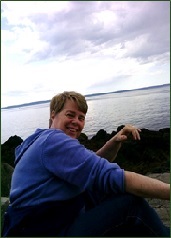 Marcia Spencer Famous has been employed as a Senior Planner for the State of Maine’s Department of Agriculture, Conservation and Forestry since 1998, with a focus on large-scale development such as windpower and commercial/agricultural ground water withdrawal. Prior to her current position, from 1986 to 1990 Marcia was employed by Downeast Peat, LP, where she investigated natural patterns of recolonization of mined peatlands in order to develop a restoration plan for a mined bog in Maine; and then until 1998 was a self-employed environmental consultant, specializing in wetland assessment and delineation, damaged peatland restoration, and landscape analysis.
Marcia Spencer Famous has been employed as a Senior Planner for the State of Maine’s Department of Agriculture, Conservation and Forestry since 1998, with a focus on large-scale development such as windpower and commercial/agricultural ground water withdrawal. Prior to her current position, from 1986 to 1990 Marcia was employed by Downeast Peat, LP, where she investigated natural patterns of recolonization of mined peatlands in order to develop a restoration plan for a mined bog in Maine; and then until 1998 was a self-employed environmental consultant, specializing in wetland assessment and delineation, damaged peatland restoration, and landscape analysis.
From 1986 to 1999, Marcia co-researched with her husband, Norman, and others, factors affecting the natural re-vegetation and regeneration of peatlands damaged by mining practices. In 1999, Marcia participated as one of several expert witnesses in a U.S. Department of Justice and Environmental Protection Agency enforcement case that involved developing a restoration plan for a mined peatland in Michigan. She presented various aspects of the peatland research at symposiums and conferences including: the ‘New Developments in Wetlands Science’ conference at the University of Sheffield, England (2001); the International Peat Society Annual Meeting in Quebec (2000); the Third and Fourth Annual Peatland Restoration Workshops at Laval University, Quebec (1995 and 1996), and more recently at the Maine Association of Wetland Scientists annual meeting in 2014.
In 2000, Marcia earned a MS in Botany and Plant Pathology at the University of Maine in Orono with a thesis, titled “The Potential for Restoration of Mined Ombrotrophic Peatlands” from which she published an invited paper in Wetlands Ecology and Management titled “Regeneration of three Sphagnum Species” (v.13, 2005: 635-645).
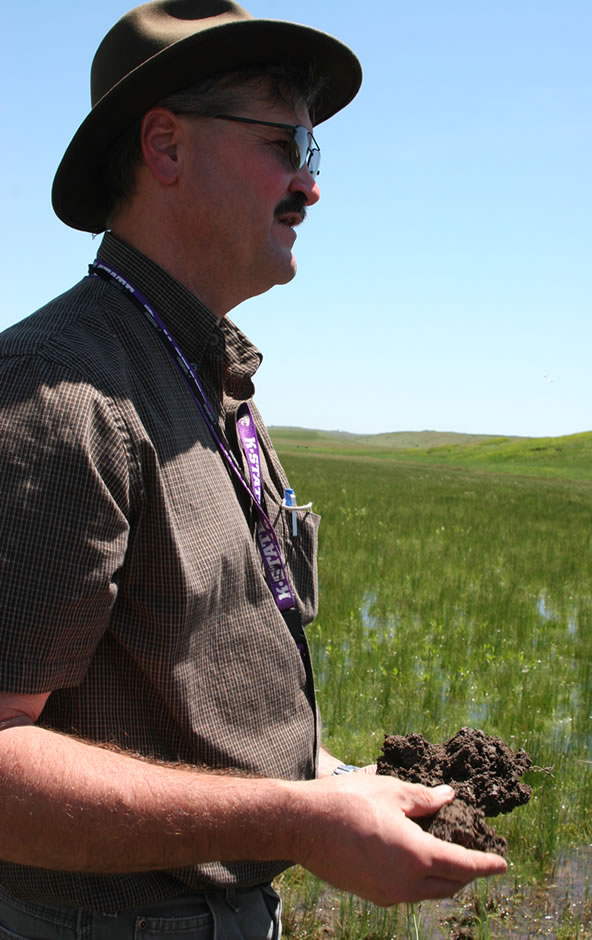 Richard A. Weber is a Wetland Hydraulic Engineer with the USDA Natural Resources Conservation Service (NRCS), Wetland Team, CNTSC in Fort Worth, Texas from 2006 to present. In this role, Rich has provided national leadership on wetland hydrology, including: Support for Wetland Restoration Program, Wetland Protection Policy, and E.O. 11990 Wetland Assessments. He leads a national training cadre for Wetland Restoration and Enhancement and Hydrology Tools for Wetland Determination courses. From 2005-2006, Rich was Design Engineer at the NRCS Nebraska State Office where he had design and A&E Contracting responsibilities for PL-566, WRP, and EQIP programs. From 1999-2005, he was a Field Engineer at the NRCS in the Scottsbluff, NE Field Office where he had design, construction, and contracting responsibilities for the Wetland Reserve Program, EQIP Irrigation and Animal Waste Management, and CTA conservation practices. From 1997-1999, Rich was an Agricultural Engineer at the NRCS in Chehalis, WA where he had design, construction, and contracting responsibilities for Conservation District funded Stream Restoration and Fish Passage projects, and EQIP program Animal Waste Projects. And from 1986-1997, he was a Watershed Project Engineer at the NRCS in Horton, KS where he performed Construction Contract Administration for PL-566 Watershed Protection and Flood Prevention projects.
Richard A. Weber is a Wetland Hydraulic Engineer with the USDA Natural Resources Conservation Service (NRCS), Wetland Team, CNTSC in Fort Worth, Texas from 2006 to present. In this role, Rich has provided national leadership on wetland hydrology, including: Support for Wetland Restoration Program, Wetland Protection Policy, and E.O. 11990 Wetland Assessments. He leads a national training cadre for Wetland Restoration and Enhancement and Hydrology Tools for Wetland Determination courses. From 2005-2006, Rich was Design Engineer at the NRCS Nebraska State Office where he had design and A&E Contracting responsibilities for PL-566, WRP, and EQIP programs. From 1999-2005, he was a Field Engineer at the NRCS in the Scottsbluff, NE Field Office where he had design, construction, and contracting responsibilities for the Wetland Reserve Program, EQIP Irrigation and Animal Waste Management, and CTA conservation practices. From 1997-1999, Rich was an Agricultural Engineer at the NRCS in Chehalis, WA where he had design, construction, and contracting responsibilities for Conservation District funded Stream Restoration and Fish Passage projects, and EQIP program Animal Waste Projects. And from 1986-1997, he was a Watershed Project Engineer at the NRCS in Horton, KS where he performed Construction Contract Administration for PL-566 Watershed Protection and Flood Prevention projects.
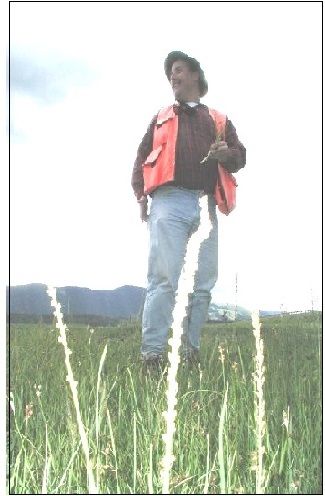 Urban, Lawrence J. “Larry” is the wetland mitigation specialist for the Montana Department of Transportation with state-wide responsibilities based out of Helena, Montana. He has over 30 years of experience in wetland delineations, functional assessments, monitoring and mitigation site development for both the New Jersey and Montana Department of Transportations. He has been involved in the development of a comprehensive aquatic resource mitigation program to meet wetland and stream mitigation needs for transportation projects throughout the state of Montana that has created over 55 mitigation areas ranging in size from ½ to 300 acres in size. He developed an annual monitoring program for the purposes of managing aquatic resource mitigation sites on both private and state lands to comply with federal, state and Tribal permitting requirements. Assisted in the funding, development and continued oversight of the Montana Department of Transportation’s Montana Wetland Assessment Method (MWAM) originally developed in 1989. He has also presented at a number of National and regional wetland mitigation conferences and participates in annual continuing education courses as an instructor in wetland regulations, mitigation and wetland assessments in the state of Montana.
Urban, Lawrence J. “Larry” is the wetland mitigation specialist for the Montana Department of Transportation with state-wide responsibilities based out of Helena, Montana. He has over 30 years of experience in wetland delineations, functional assessments, monitoring and mitigation site development for both the New Jersey and Montana Department of Transportations. He has been involved in the development of a comprehensive aquatic resource mitigation program to meet wetland and stream mitigation needs for transportation projects throughout the state of Montana that has created over 55 mitigation areas ranging in size from ½ to 300 acres in size. He developed an annual monitoring program for the purposes of managing aquatic resource mitigation sites on both private and state lands to comply with federal, state and Tribal permitting requirements. Assisted in the funding, development and continued oversight of the Montana Department of Transportation’s Montana Wetland Assessment Method (MWAM) originally developed in 1989. He has also presented at a number of National and regional wetland mitigation conferences and participates in annual continuing education courses as an instructor in wetland regulations, mitigation and wetland assessments in the state of Montana.
![]()
Riverine/Riparian Wetland Restoration
Held Tuesday, June 9, 2015 – 3:00 pm ET
Introduction – Marla Stelk, Policy Analyst, Association of State Wetland Managers and Jeanne Christie, Association of State Wetland Managers
PRESENTERS
- Richard Weber, NRCS Wetland Team, CNTSC
- Larry Urban, Montana Department of Transportation
PowerPoint presentation is available here.
ABSTRACT
Riverine wetlands exist in floodplains and along watercourses where the stream hydrograph dominates the wetland’s hydrology. They are classified as Riverine in the HGM classification system. The stream hydrograph provides flooding, ponding in floodplain depressions, and usually supports a floodplain water table. They provide dynamic floodwater storage, cycle sediment and nutrients, recharge aquifers, maintain stream baseflow, and many other unique functions. This webinar will provide rational distinctions between various types of Riverine wetlands. We will also present the functional distinctions between flooding, ponding, and groundwater, introduce the concepts of episaturation and endosaturation, and correlate landforms and functions with soils information. Various restoration techniques are presented, and the appropriateness of those techniques is related to specific Riverine wetland types. Techniques will cover a range of scale from stream channel treatment to large scale flood connectivity restoration.
PRESENTERS BIOS
 Richard A. Weber is a Wetland Hydraulic Engineer with the USDA Natural Resources Conservation Service (NRCS), Wetland Team, CNTSC in Fort Worth, Texas from 2006 to present. In this role, Rich has provided national leadership on wetland hydrology, including: Support for Wetland Restoration Program, Wetland Protection Policy, and E.O. 11990 Wetland Assessments. He leads a national training cadre for Wetland Restoration and Enhancement and Hydrology Tools for Wetland Determination courses. From 2005-2006, Rich was Design Engineer at the NRCS Nebraska State Office where he had design and A&E Contracting responsibilities for PL-566, WRP, and EQIP programs. From 1999-2005, he was a Field Engineer at the NRCS in the Scottsbluff, NE Field Office where he had design, construction, and contracting responsibilities for the Wetland Reserve Program, EQIP Irrigation and Animal Waste Management, and CTA conservation practices. From 1997-1999, Rich was an Agricultural Engineer at the NRCS in Chehalis, WA where he had design, construction, and contracting responsibilities for Conservation District funded Stream Restoration and Fish Passage projects, and EQIP program Animal Waste Projects. And from 1986-1997, he was a Watershed Project Engineer at the NRCS in Horton, KS where he performed Construction Contract Administration for PL-566 Watershed Protection and Flood Prevention projects.
Richard A. Weber is a Wetland Hydraulic Engineer with the USDA Natural Resources Conservation Service (NRCS), Wetland Team, CNTSC in Fort Worth, Texas from 2006 to present. In this role, Rich has provided national leadership on wetland hydrology, including: Support for Wetland Restoration Program, Wetland Protection Policy, and E.O. 11990 Wetland Assessments. He leads a national training cadre for Wetland Restoration and Enhancement and Hydrology Tools for Wetland Determination courses. From 2005-2006, Rich was Design Engineer at the NRCS Nebraska State Office where he had design and A&E Contracting responsibilities for PL-566, WRP, and EQIP programs. From 1999-2005, he was a Field Engineer at the NRCS in the Scottsbluff, NE Field Office where he had design, construction, and contracting responsibilities for the Wetland Reserve Program, EQIP Irrigation and Animal Waste Management, and CTA conservation practices. From 1997-1999, Rich was an Agricultural Engineer at the NRCS in Chehalis, WA where he had design, construction, and contracting responsibilities for Conservation District funded Stream Restoration and Fish Passage projects, and EQIP program Animal Waste Projects. And from 1986-1997, he was a Watershed Project Engineer at the NRCS in Horton, KS where he performed Construction Contract Administration for PL-566 Watershed Protection and Flood Prevention projects.
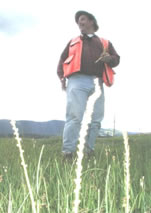 Lawrence J. “Larry”Urban is the wetland mitigation specialist for the Montana Department of Transportation with state-wide responsibilities based out of Helena, Montana. He has over 30 years of experience in wetland delineations, functional assessments, monitoring and mitigation site development for both the New Jersey and Montana Department of Transportations. He has been involved in the development of a comprehensive aquatic resource mitigation program to meet wetland and stream mitigation needs for transportation projects throughout the state of Montana that has created over 55 mitigation areas ranging in size from ½ to 300 acres in size. He developed an annual monitoring program for the purposes of managing aquatic resource mitigation sites on both private and state lands to comply with federal, state and Tribal permitting requirements. Assisted in the funding, development and continued oversight of the Montana Department of Transportation’s Montana Wetland Assessment Method (MWAM) originally developed in 1989. He has also presented at a number of National and regional wetland mitigation conferences and participates in annual continuing education courses as an instructor in wetland regulations, mitigation and wetland assessments in the state of Montana.
Lawrence J. “Larry”Urban is the wetland mitigation specialist for the Montana Department of Transportation with state-wide responsibilities based out of Helena, Montana. He has over 30 years of experience in wetland delineations, functional assessments, monitoring and mitigation site development for both the New Jersey and Montana Department of Transportations. He has been involved in the development of a comprehensive aquatic resource mitigation program to meet wetland and stream mitigation needs for transportation projects throughout the state of Montana that has created over 55 mitigation areas ranging in size from ½ to 300 acres in size. He developed an annual monitoring program for the purposes of managing aquatic resource mitigation sites on both private and state lands to comply with federal, state and Tribal permitting requirements. Assisted in the funding, development and continued oversight of the Montana Department of Transportation’s Montana Wetland Assessment Method (MWAM) originally developed in 1989. He has also presented at a number of National and regional wetland mitigation conferences and participates in annual continuing education courses as an instructor in wetland regulations, mitigation and wetland assessments in the state of Montana.
![]()
Held Tuesday, May 19, 2015 – 3:00 pm ET
Introduction – Marla Stelk, Policy Analyst, Association of State Wetland Managers and Jeanne Christie, Association of State Wetland Managers
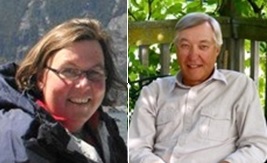 PRESENTERS
PRESENTERS
- Sue Galatowitsch, University of Minnesota
- Carter Johnson, South Dakota State University
PowerPoint presentation is available here.
ABSTRACTS
Sue Galatowitsch Abstract: Understanding how restored wetland communities deviate from natural conditions and how long those deviations persist can provide important insights into the mechanisms of recovery and improve restoration practice. This webinar focuses on restored prairie pothole wetland restorations in northern Iowa, southern Minnesota, and southeastern South Dakota. Complete floristic surveys were performed for each restored wetlands in this region for twenty years. The important barriers to the recovery of prairie pothole restoration: isolation, infrequent flooding, and invasive species, are all factors that do not self-correct over time over time and need to be addressed during planning by establishing sound practices for initial implementation and long-term vegetation management.
Carter Johnson Abstract: About half of the original wetlands in the Prairie Pothole Region have been drained, mostly for agriculture. If we are to maintain ecosystem services from these wetlands in the future, we need to rehabilitate a large number of drained wetlands in farmland. While they grow crops occasionally, most often crops are flooded out or the wetlands are too wet to plant. In most years they provide little either for farmers or for the conservation-minded public. An experiment was conducted on a working Prairie Farm from 2008-2014 to convert these wetlands to grass crops that would provide consistent income for producers either from native plant seed, hay, or grass-fed beef. Plants native to the region, well-adapted to the natural water regime, and with economic potential were planted, managed, and marketed. Results indicate that the costs of rehabilitation could be met in several years’ time, with significant profits afterwards.
PRESENTERS BIOS
Susan M. Galatowitsch is Professor and Head of Fisheries, Wildlife, and Conservation Biology at the University of Minnesota. Dr. Galatowitsch teaches courses in restoration ecology and wetland ecology at the University of Minnesota. Her research focuses on restoration assessment, revegetation, management of invasive species, and climate change adaptation for wetland and riparian ecosystems. In addition to many research publications, she has authored two books, Ecological Restoration (Sinauer Associates) and Restoring Prairie Wetlands: An Ecological Approach (with Arnold van der Valk).
Dr. W. Carter Johnson is Distinguished Professor of Ecology at South Dakota State University in Brookings and Chairman of EcoSun Prairie Farms, Inc. He received a B.S. in Biology from Augustana College (Sioux Falls) in 1968 and a Ph.D. in Botany (Plant Ecology) from North Dakota State University in 1971. Dr. Johnson began his professional career as Research Associate and Research Staff Member at Oak Ridge National Laboratory (1971-77), followed by 12 years in the Department of Biology at Virginia Tech. In 1989 he became Head of the Department of Horticulture, Forestry, Landscape, and Parks at South Dakota State University, a position held until 1995. Since then, he has maintained a combined teaching and research position at SDSU.His research interests include river regulation and riparian forest ecology, climate change and prairie wetlands, seed dispersal in fragmented landscapes, paleoecology (climate reconstruction using tree rings; Holocene seed dispersal and plant migration) and multi-functional agriculture and agro-ecological restoration. His research program is strongly multi-disciplinary and inter-institutional. Dr. Johnson has published approximately 135 peer-reviewed journal articles, books and book chapters.
![]()
Vernal Pool Restoration – How to Restore the Landscape![]()
Held Tuesday, April 21, 2015 – 3:00 pm ET
Introduction – Marla Stelk, Policy Analyst, Association of State Wetland Managers and Jeanne Christie, Association of State Wetland Managers
PRESENTERS
- Mick Micacchion, Midwest Biodiversity Institute
- Christina M. Schaefer, Schaefer Ecological Solutions
- Aram J.K. Calhoun, The University of Maine
PowerPoint presentation is available here.
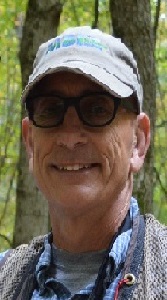
PRESENTERS BIOS
Mick Micacchion is a wetland ecologist at the non-profit Midwest Biodiversity Institute and is certified as a Professional Wetland Scientist by the Society of Wetland Scientists. He has a BS and MS in Wildlife Management, both from the Ohio State University, and retired in 2011 from the Ohio Environmental Protection Agency (Ohio EPA). While working at Ohio EPA he was instrumental in the development of Ohio’s Wetland Water Quality Standards rules, wetland assessment tools (including the Ohio Rapid Assessment Method for Wetlands (ORAM), Vegetation Index of Biotic Integrity (VIBI), and Amphibian Index of Biotic Integrity (AmphIBI)) and their integration into Ohio’s wetland program, which has worked as a model for the country. He has monitored the physical, chemical and biological features, including the plant, amphibian and macroinvertebrate communities of hundreds of Ohio’s natural wetlands and trained hundreds of wetland professionals in the development and use of wetland monitoring and assessment methods including ORAM, VIBI and AmphIBI. He has also monitored, assessed, and reported on the condition of hundreds of Ohio wetland mitigation projects. Mick was a member of the Technical Advisory Group, which developed the methods used in the National Wetland Condition Assessment, and on Ohio’s Interagency Review Team, where he was a major contributor to the “Guidelines on Wetland Mitigation Banking in Ohio”.
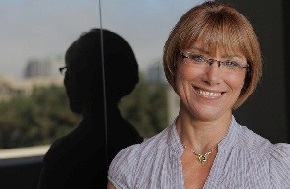 Christina Schaefer is a landscape ecologist with over 30 years of experience in natural resources planning and management, conservation biology, and restoration ecology. She acquired her expertise by piloting habitat restoration programs in arid and saline environments in the Middle East and Mexico, participating in research for the Biosphere II project (a self-contained ecosystem in the Arizona desert), and working on conservation projects in Germany and Italy. While at the Environmental Research Laboratory in Tucson, Arizona, she conducted her Ph.D. research on the biology of Distichlis palmeri, a California endemic salt-tolerant plant, and its usefulness for restoration of saline environments. Over the past 20 years, Christina has gained significant expertise in vernal pool ecosystems and their restoration through hands-on vernal pool habitat restoration. Christina specializes in habitat restoration design and implementation, large-scale natural resources and watershed management planning, and the development of land management funding mechanisms. As a board member of the San Diego Habitat Conservancy (SDHC), Christina chairs the Habitat Management Committee, assists with the implementation of state-of-the-art monitoring protocols, and reviews the acquisition process for new preserves. She also serves on the Education Committee on the behalf of which she engages with educators on developing an open space curriculum for elementary schools. Christina often guest-teaches at the University of California San Diego (UCSD) and participates in the National Science Foundation (NSF)-funded “Art of Science Learning” and the “San Diego Incubator for Innovation”, hosted by the Balboa Park Cultural Partnership.
Christina Schaefer is a landscape ecologist with over 30 years of experience in natural resources planning and management, conservation biology, and restoration ecology. She acquired her expertise by piloting habitat restoration programs in arid and saline environments in the Middle East and Mexico, participating in research for the Biosphere II project (a self-contained ecosystem in the Arizona desert), and working on conservation projects in Germany and Italy. While at the Environmental Research Laboratory in Tucson, Arizona, she conducted her Ph.D. research on the biology of Distichlis palmeri, a California endemic salt-tolerant plant, and its usefulness for restoration of saline environments. Over the past 20 years, Christina has gained significant expertise in vernal pool ecosystems and their restoration through hands-on vernal pool habitat restoration. Christina specializes in habitat restoration design and implementation, large-scale natural resources and watershed management planning, and the development of land management funding mechanisms. As a board member of the San Diego Habitat Conservancy (SDHC), Christina chairs the Habitat Management Committee, assists with the implementation of state-of-the-art monitoring protocols, and reviews the acquisition process for new preserves. She also serves on the Education Committee on the behalf of which she engages with educators on developing an open space curriculum for elementary schools. Christina often guest-teaches at the University of California San Diego (UCSD) and participates in the National Science Foundation (NSF)-funded “Art of Science Learning” and the “San Diego Incubator for Innovation”, hosted by the Balboa Park Cultural Partnership.
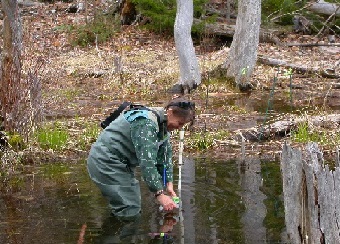 Aram JK Calhoun is a Professor of Wetland Ecology in the Department of Wildlife, Fisheries, and Conservation Biology and Director of the Ecology and Environmental Sciences Program at the University of Maine, USA. Her research focuses on forested wetlands and vernal pool ecosystems. She is particularly interested in conservation of natural resources on private lands and collaborative approaches to conserving them. Dr. Calhoun is active in working at all levels of government and with diverse stakeholders on wetland policy and conservation issues and is currently working with Maine municipalities to develop an alternative, locally driven, vernal pool regulatory tool.
Aram JK Calhoun is a Professor of Wetland Ecology in the Department of Wildlife, Fisheries, and Conservation Biology and Director of the Ecology and Environmental Sciences Program at the University of Maine, USA. Her research focuses on forested wetlands and vernal pool ecosystems. She is particularly interested in conservation of natural resources on private lands and collaborative approaches to conserving them. Dr. Calhoun is active in working at all levels of government and with diverse stakeholders on wetland policy and conservation issues and is currently working with Maine municipalities to develop an alternative, locally driven, vernal pool regulatory tool.
![]()
Pacific Coast Wetland Restoration
Held Tuesday, March 17, 2015 – 3:00 pm ET
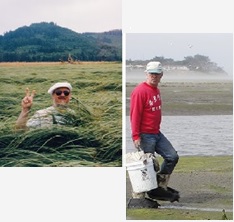 Introduction – Marla Stelk, Policy Analyst, Association of State Wetland Managers and Jeanne Christie, Association of State Wetland Managers
Introduction – Marla Stelk, Policy Analyst, Association of State Wetland Managers and Jeanne Christie, Association of State Wetland Managers
PRESENTERS
- Charles ("Si") Simenstad, University of Washington
- John Callaway, University of San Francisco
PowerPoint presentation is available here.
ABSTRACT
Pacific Coast tidal wetlands encompass a wide range of conditions from high-salinity, Mediterranean southern California salt marshes with ~2-m tidal range to tidal wetlands in the Pacific Northwest with low salinities, often extensive tidal freshwater, and tidal ranges up to 3.5-m. There has been a long history of tidal wetland restoration across this spectrum, in large part driven by high rates of wetland impacts in southern California, San Francisco Bay, and Puget Sound, but also in smaller coastal estuaries. Early restoration evolved directly from mitigation requirements, with focus on supporting endangered species, such as Pacific salmon and Clapper Rail. More recently, large-scale regional efforts have been undertaken to improve landscape-scale restoration, with a broad consideration of estimating climate change effects on wetlands. In addition to climate change issues, urbanization is a major constraint for restoration planning on the Pacific Coast. We will review lessons from a range of case studies across the region, considering issues of scale, evaluation of success, and restoration constraints. If we have a consensus take-home message, it is that our current ad hoc, opportunistic approach to tidal wetland restoration will need to be replaced by a more watershed, ecosystem process-based planning process.
PRESENTERS BIOS
Charles (“Si”) Simenstad is a Research Professor in the University of Washington’s School of Aquatic and Fishery Science, where he coordinates the Wetland Ecosystem Team. Prof. Simenstad is an estuarine and coastal marine ecologist who has studied the organization and function of estuarine and coastal marine ecosystems throughout Puget Sound, Washington, Oregon and California coasts, and Alaska for over forty years. Much of this research has focused on the functional role of estuarine and coastal wetlands supporting juvenile Pacific salmon and other fish and wildlife, and the associated ecological processes and community dynamics that are responsible for enhancing their production and life history diversity. His research interests focus on: ecosystem-, community- and habitat-level interactions, with emphasis on predator-prey relationships; sources, organization and flow of organic matter through food webs; estuarine ecology of juvenile Pacific salmon; and, landscape-scale interaction between estuarine circulation and ecological processes. Recent research has integrated such ecosystem interactions with applied issues such as evaluating and planning restoration and rehabilitation of estuarine and coastal wetlands at ecosystem and landscape scales.
Prof. Simenstad is a Fellow of the American Association for the Advancement of Science, Co-Editor-in-Chief for Estuaries and Coasts, and Associate Editor for San Francisco Estuary & Watershed Science and the Encyclopedia of Puget Sound. He also serves on the Chief of the US Army Corps of Engineers Environmental Advisory Board, and was the 2009 recipient of the NOAA-AFS Nancy Foster Award for Habitat Conservation. He has authored or co-authored over 80 peer-reviewed scientific papers, 20 book and proceedings chapters, ~35 miscellaneous publications and >125 workshop proceedings and technical reports. He has recently served as the co-editor for the 11-chapter, Vol. 1-Classification of Estuarine and Nearshore Coastal Ecosystems in Elsevier’s recently published, comprehensive Treatise on Estuarine and Coastal Science. He has served as academic advisor for 27 M.S./Ph.D. graduate students, and served on an additional ~40 graduate student committees.
Si’s recent research includes: NOAA-NWFSC studies of juvenile salmon rearing in wetlands and restoring shallow-water ecosystems of the Columbia River estuary; developing and testing an estuarine ecosystem classification system for the Columbia River estuary, and employing it to delineate juvenile Pacific salmon habitat through the estuary gradient; an interdisciplinary study of wetland restoration processes at Liberty Island in the Sacramento River delta; investigating the trophic responses of juvenile salmon and steelhead during intermittent closing of the Russian River (California) estuary; evaluating the contribution of estuarine rearing of juvenile salmon to life history diversity in Kachemak Bay and southeastern Cook Inlet, Alaska; and through 2012 served as Chair of the Nearshore Science Team (NST) of the Puget Sound Nearshore Ecosystem Research Program (PSNERP) providing scientific guidance for the (US Army Corps of Engineers, General Investigation) restoration planning of estuarine and nearshore ecosystems in Puget Sound.
Si holds a B.S. (1969) and M.S. (1971) from the School of Fisheries at the University of Washington.
John Callaway is a Professor in the Department of Environmental Science at the University of San Francisco, where he also directs the Master's program in Environmental Management. Prior to this, he was the Associate Director of the Pacific Estuarine Research Laboratory at San Diego State University. He teaches courses in wetland ecology and restoration ecology at USF, and he conducts research on wetland restoration, climate change effects on tidal wetlands, and wetland carbon dynamics. John has published over 50 peer-reviewed journal articles and book chapters. His most recent project was on carbon sequestration in tidal wetlands in San Francisco Bay. In 2013, he was awarded USF’s Distinguished Research Award. John also serves on a number of advisory panels on wetland restoration and management, including in Louisiana, southern California, and the San Francisco Bay area. Previously, he was the editor of Madroño and served on the board of editors of Wetlands, and Ecological Applications; currently he is an associate editor for Estuaries and Coasts. John received a B.S. in Biology from UC Berkeley, an M.S. in Biology from San Francisco State University, and a Ph.D. in Oceanography and Coastal Sciences from Louisiana State University.
![]()
Playa and Rainwater Basin Restoration
Held Tuesday, February 17, 2015 – 3:00 pm ET
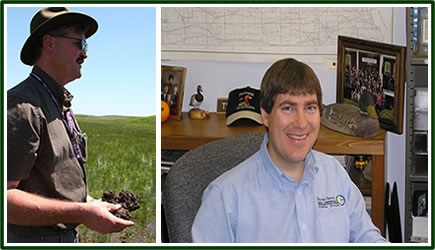 Introduction – Marla Stelk, Policy Analyst, Association of State Wetland Managers and Jeanne Christie, Association of State Wetland Managers
Introduction – Marla Stelk, Policy Analyst, Association of State Wetland Managers and Jeanne Christie, Association of State Wetland Managers
PRESENTERS
- Rich Weber, NRCS Wetland Team, CNTSC
- Ted LaGrange, Nebraska Game & Parks Commission
PowerPoint presentation is available here.
ABSTRACT
Playa wetlands are one of the most abundant wetland types on the Great Plains. They are shallow, mostly temporarily flooded, depressional wetlands, and most have no surface outlet and are perched above groundwater by a clay layer. Many playas are embedded in agricultural fields, and have been highly impacted by drainage attempts, watershed modifications, and/or culturally-accelerated sediment. We will discuss how to assess these impacts and the techniques that can be used to restore playas and their associated watersheds. We will also discuss the importance of managing playas after their restoration.
PRESENTERS BIOS
Richard A. Weber is a Wetland Hydraulic Engineer with the USDA Natural Resources Conservation Service (NRCS), Wetland Team, CNTSC in Fort Worth, Texas from 2006 to present. In this role, Rich has provided national leadership on wetland hydrology, including: Support for Wetland Restoration Program, Wetland Protection Policy, and E.O. 11990 Wetland Assessments. He leads a national training cadre for Wetland Restoration and Enhancement and Hydrology Tools for Wetland Determination courses. From 2005-2006, Rich was Design Engineer at the NRCS Nebraska State Office where he had design and A&E Contracting responsibilities for PL-566, WRP, and EQIP programs. From 1999-2005, he was a Field Engineer at the NRCS in the Scottsbluff, NE Field Office where he had design, construction, and contracting responsibilities for the Wetland Reserve Program, EQIP Irrigation and Animal Waste Management, and CTA conservation practices. From 1997-1999, Rich was an Agricultural Engineer at the NRCS in Chehalis, WA where he had design, construction, and contracting responsibilities for Conservation District funded Stream Restoration and Fish Passage projects, and EQIP program Animal Waste Projects. And from 1986-1997, he was a Watershed Project Engineer at the NRCS in Horton, KS where he performed Construction Contract Administration for PL-566 Watershed Protection and Flood Prevention projects.
Ted LaGrange is an Iowa native, Ted moved to Nebraska in 1993 to work as the Wetland Program Manager for the Nebraska Game and Parks Commission. As Wetland Program Manager he works on a wide variety of wetland issues throughout the state including private land restoration programs, public lands management, resource advocacy and outreach. Prior to moving to Nebraska, he worked for 8 years as a Waterfowl Research Technician for the Iowa Department of Natural Resources in Clear Lake. Stationed in northern Iowa, he worked with the prairie pothole restoration program, especially evaluation of plant and waterfowl response to wetland restoration. Ted received B.S. and M.S. degrees in wildlife biology from Iowa State University. During his college years he spent summers working on refuges in Oregon and New York for the US Fish and Wildlife Service, working on a muskrat ecology study on the Upper Mississippi River, and working on the Marsh Ecology Research Project for Delta Waterfowl and Wetlands Research Station in Manitoba. His professional interests are in prairie wetlands and waterfowl/waterbird ecology.
![]()
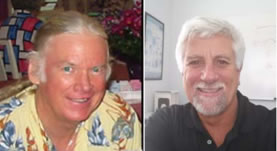 Temperate and Tropical/subtropical Seagrass Restoration: challenges for the 21st century
Temperate and Tropical/subtropical Seagrass Restoration: challenges for the 21st century
Held January 20, 2015 – 3:00 pm ET
Introduction – Marla Stelk, Policy Analyst, Association of State Wetland Managers and Jeanne Christie, Association of State Wetland Managers
PRESENTERS
- Robin Lewis, Lewis Environmental Services, Inc. & Coastal Resource Group, Inc.
- Mark Fonseca, CSA Ocean Sciences
PowerPoint presentation is available here.
ABSTRACT
This presentation reviews the status of the science for seagrass restoration and mitigation with a worldwide perspective. The presentation will include review of current challenges, such as understanding the importance of disturbance in site selection and stability, applying economic evaluation, applying landscape principles and management of species with diverse life histories. Strategies for the future engagement will be outlined including the need for more site-specific training and the addressing the current general lack of appreciation and application of the historical science base.
PRESENTERS BIOS
Roy R. “Robin” Lewis, III is President of Lewis Environmental Services, Inc., and Coastal Resources Group, Inc., a not-for-profit scientific and educational organization, both with offices in Valrico, Florida, and Salt Springs, Florida. He is a Professional Wetland Scientist certified by the Society of Wetland Scientists, and a certified Senior Ecologist with the Ecological Society of America. He has forty years of experience in the design and construction of wetlands with over 200 completed and successful projects in the USA and overseas. He has recently designed, permitted, and supervised initial construction of a 400 ha mangrove restoration project at the Rookery Bay National Estuarine Research Reserve near Marco Island, and a 7,000 ha project in Indonesia. He has also worked and taught wetland restoration in twenty-two foreign countries including Jamaica, Bonaire, the Bahama Islands, Cuba, Costa Rica, Barbados, Guyana, Nigeria, Mexico, Puerto Rico, the US Virgin Islands, India, Sri Lanka, Thailand, Vietnam, Indonesia and Hong Kong. He specializes in the ecological monitoring, management and restoration of mangrove forests and seagrass meadows and has over 125 professional publications in these and other wetland subject areas.
Mark Fonseca is the Science Director for CSA Ocean Sciences, a marine environmental consulting firm headquartered in Stuart, Florida and with numerous overseas branch offices. Besides ensuring scientific quality for CSA, he conducts applied research with a focus on ecosystem restoration and management, especially with seagrasses. In 2012 he retired from NOAA where he spent over 30 years as a research ecologist and research branch chief. He has authored or co-authored over 80 peer-reviewed papers and dozens of technical reports on the ecology, conservation and mitigation of seagrass ecosystems. In 1998 he also senior authored “Guidelines for the conservation and restoration of seagrasses in the United States and Adjacent Waters”, which remains a leading national and international treatise on the subject. He holds a B.Sc. in Resource Development from the University of Rhode Island, a M.Sc. in Environmental Sciences from the University of Virginia and a Ph.D. in Integrative Biology from the University of California, Berkeley.
![]()
View Past Improving Wetland Restoration Success Webinars Here
| 2016 | 2014 | ||
View a List of Improving Wetland Restoration Success Webinar Recordings Here

